

Pickering; Sam Christmas; Katie Barker;
Point Images; Cory Texter; Larry Pegram; Scott Brelsford; Sammy Sabedra; Dan Stanley; Jonas Hendrix; Manel Rosa; Alex Carbonell; Ryan Quickfall; Scott Toepfer; Death Spray Custom; Co-Built; Dee Johnson; Nick at Fartco; Jim Koch; Manel Portugal; Lucia at 5Special; Todd Marella; Shogo Nakao; Larry Lawrence; Mick Ofield; Fab Biker PR; Prankur Rana; Carl CFM; Cheetah; Dave & Kathy at Flat Trak Fotos; Leftie; Lenny Schuurmans; Egor at Anker; Semen Kuzmin; Kristen Lassen, Scott Hunter, Giselle, Helen & all


American
Track; the DTRA;

who
and
Kristina Fender.
Mutate to survive. American Flat Track emerges into a pandemic-gripped world. See p28 Cover: Survivor 250 SX & George Pickering by Sam Christmas @sideburnmag sideburnmag sideburnmagazine.com SIDEBURN IS THE OFFICIAL MAGAZINE OF AMERICAN FLAT TRACK This issue of Sideburn was created under lockdown conditions thanks to these stars: George
Braking
at
Flat
a thousand thank yous to all our advertisers old
new. Support those
support the scene. This issue is dedicated to
The opinions expressed in Sideburn magazine are those of the author(s) and do not necessarily reflect the opinions of the magazine’s publisher or editors. Sideburn is published four times a year by Inman Ink Ltd Editor: Gary Inman Deputy editor: Mick Phillips Art editor: Kar Lee For advertising/commercial enquiries please email: sideburnmag@gmail.com ©2020 Sideburn magazine None of this magazine can be reproduced without publisher’s consent sideburnmag@gmail.com SIDEBURN 43 will be published in November 2020. To subscribe go to sideburn.bigcartel.com
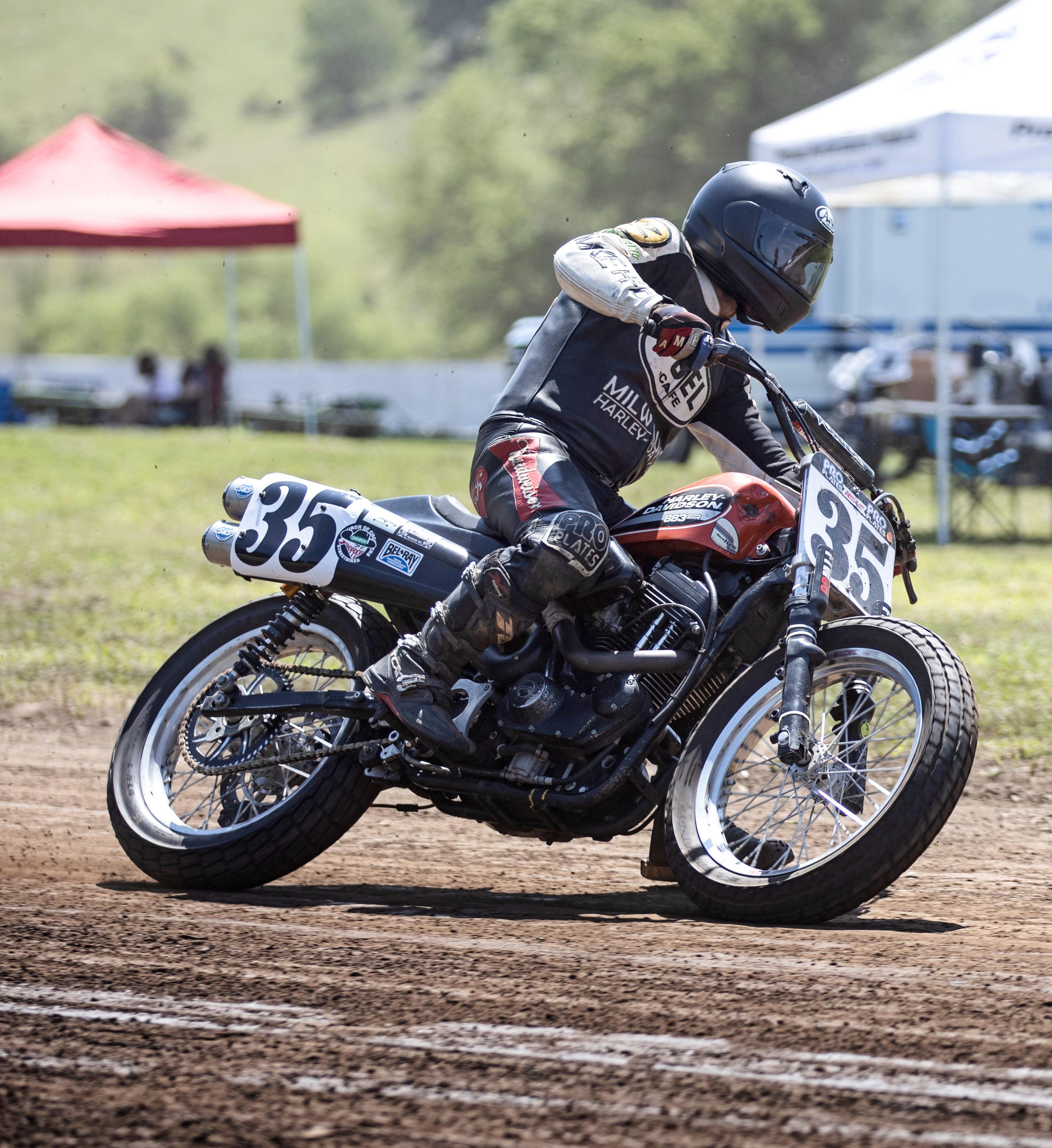
Made in the USA • sscycle.com • @sscycle • #sscycle Race-ready parts for your Hooligan build
6 GO! At last, 2020 is underway 8 DIVINE. LIGHT. Survivor KTM 250 stroker 20 LARRY PEGRAM SuperTwins wild card and colossal weed farmer 28 AFT VS THE NEW NORMAL Masks and alligator head trophies – Florida welcomes the pros 34 PAYBACK Why a freelance photographer sponsors a privateer racer 38 SX APPEAL Super-classy 1970s Harley two-stroke short tracker 49 CHAMPION KAWASAKI 750 H2 Blueprint of a mythical beast, Kanemoto’s triple 56 LEATHER QUEEN The artistry of D’s Leathers 64 MOTORCYCLES SAVED MY LIFE Mental health check 67 MANUEL PORTUGAL Portfolio of the Portuguese photo pro 76 5 STEPS TO SUDO Stunning Sudo Co-Built Rotax 86 SUPER POWER Russia’s only Trackmaster Triumph twin (plus an oddball IZH stroker) 5 #42 sideburn Regulars 24 C-Tech: Geometry 94 Have Fun!! Japanese Flat Track 97 Schuurmans’ Backflash 98 Project Bike 100 Racewear 103 Sideburn merchandise 104 Death Spray Custom 106 Trophy Queen Illustration: Death Spray Custom
GO!
THE DIFFERENCE SOME white paint and 24 hours make. The rescheduled AFT season got underway on 17 July at Volusia, a track the Grand National Championship had never previously visited. Night one of the double-header took place on a narrow groove, with few overtaking opportunities. For the early sessions of day two, painted lines on the outside of the previous night’s groove forced riders further up the track, widening the racing surface as they laid down more rubber. For the race, the paint was removed, reinstating the inside line. It was one of the ingredients that created a classic Singles race that fans will talk about for months, if not years. As riders pushed ever harder, a fog of excess adrenaline hung in the hot evening air. A red flag led to a fourlap dash that hotly-tipped teenager Dallas Daniels, #32, (battling here with #13 Mischler and #15 Rush) grabbed by 0.02s from Shayna Texter. The 2020 Singles class is totally unpredictable.

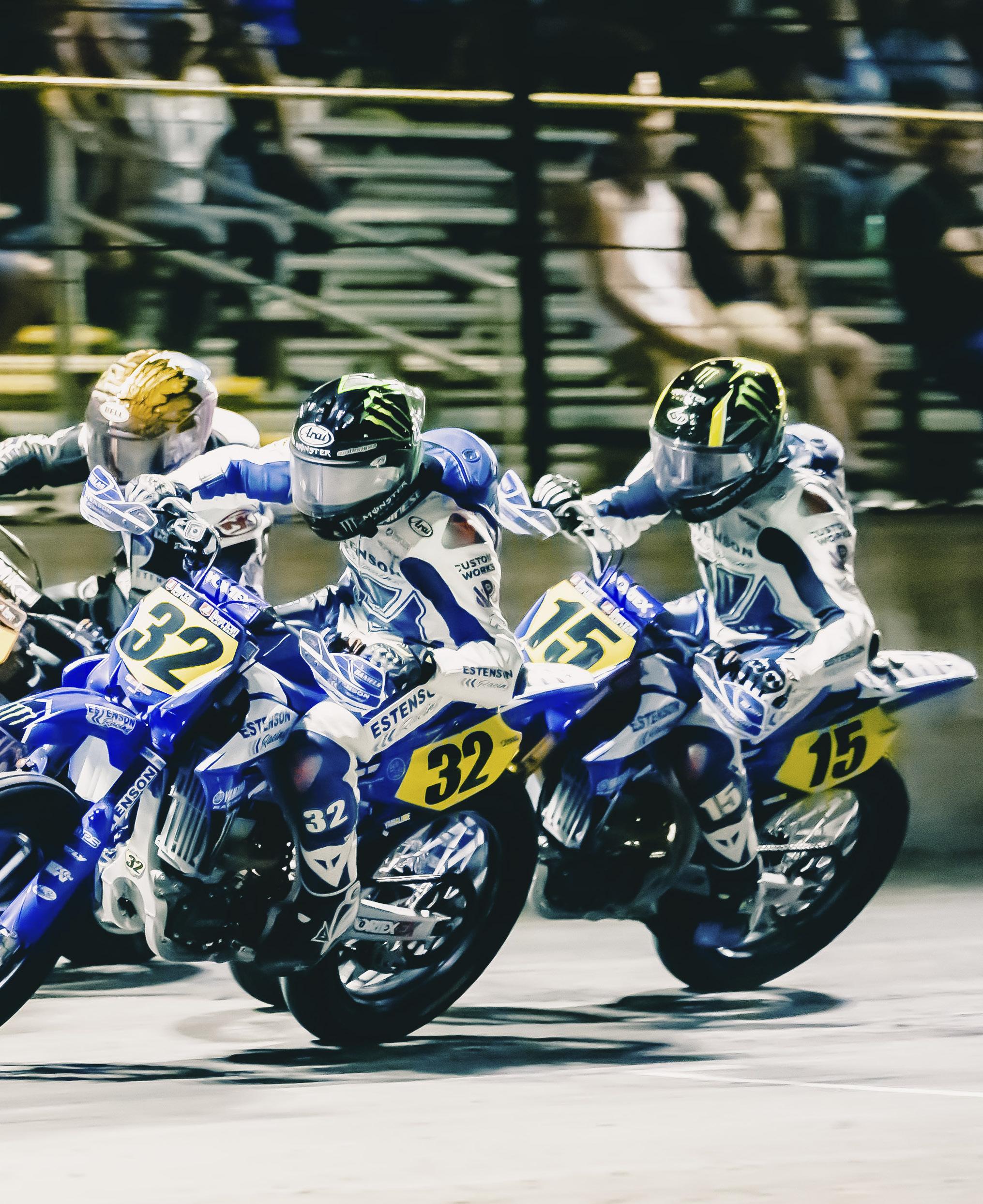
7
Photo: Kristen Lassen/ American Flat Track
Divine. Light.
And we mean light. A Brit-built, sub-90kg 250 framer with Pro class 450s in its sights. Time to prey
Words: Gary Inman Photos: Sam Christmas, Braking Point Images (track action)

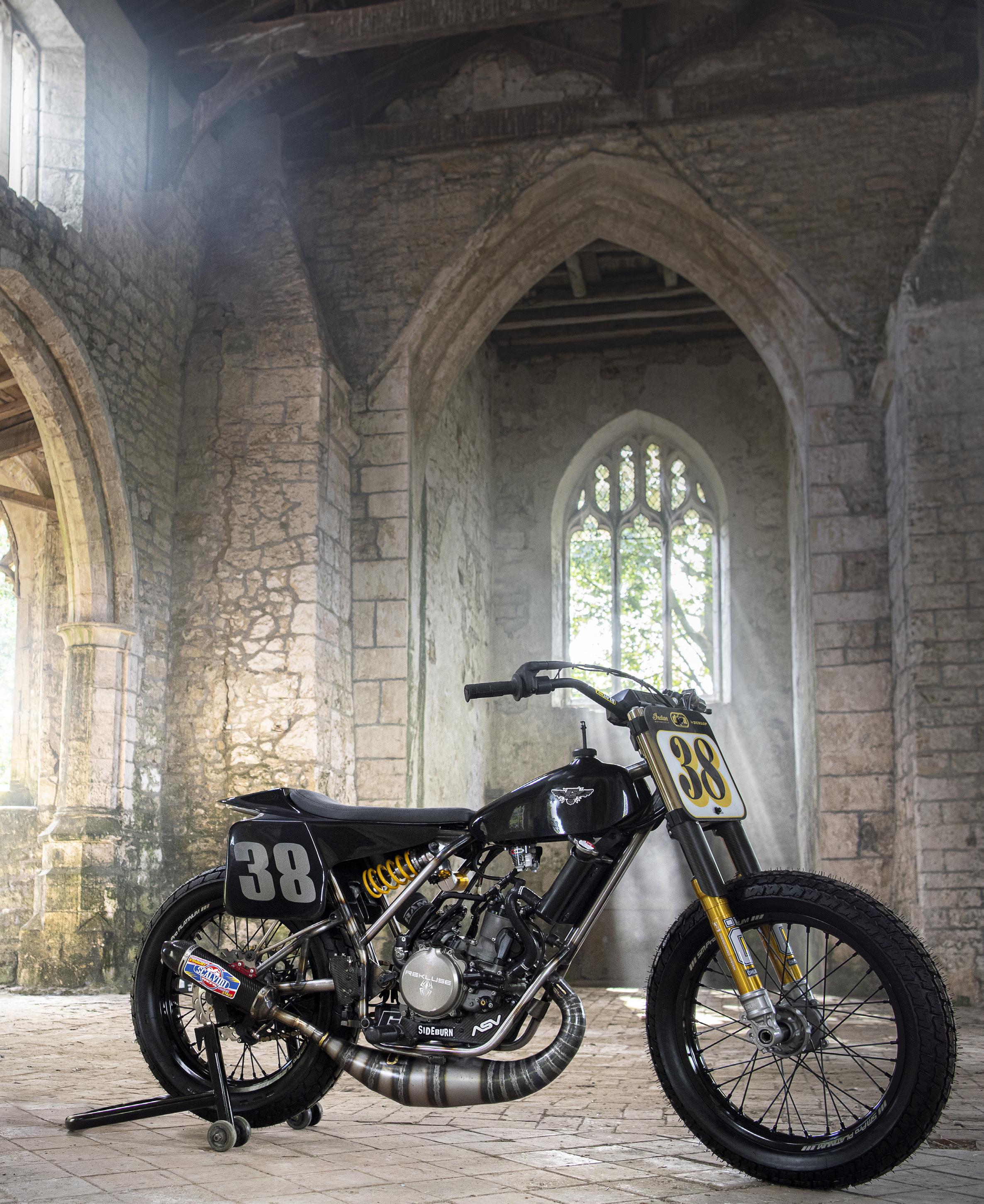
9 >
‘S
IMPLIFY, THEN ADD lightness.’
That line from Lotus racing supremo Colin Chapman is one of a handful of motorsport quotes that have lodged in my brain, along with ‘See God, then brake’ and ‘They don’t pay me enough to ride that thing’.
When it comes to competitionready vehicles, dirt track motorcycles are as comparatively complex as a cheese sandwich. The rules have stunted development for 60 years. Here’s one example: at the very pinnacle of the sport, American Flat Track’s SuperTwins class, aluminium frames are not allowed. It’s fair to say the sport has simplicity in abundance. There are no aerodynamic winglets, active suspension systems or carbonfibre brakes. That means half of Chapman’s ethos is embedded in the very DNA of the sport. Now to add the lightness.
‘I was baling some hay in the field next to Greenfield Dirt Track when a friend messaged to say he was selling a standard KTM 250 SX,’ says George Pickering, the young farmer who, on his family farm, created the oval that has become the focus of UK dirt track1. ‘I thought it would be fun to do some racing with and, because I’ve raced KTMs in the past, I already had some wheels and suspension set up for a KTM. Let’s give it a go.’
George bought the two-stroke motocrosser in mid-2019. After a couple of practice days, he entered a rare UK race with prize money up for grabs, the DTRA’s Friday night before DirtQuake at Eastbourne on England’s south coast.

‘I managed to take the win! The 250 engine was actually really
good and worked surprisingly well against the field of 450 DTX bikes on the short 275m (300 yard) speedway track,’ says George.
On the drive back north, a few riders stopped at Rye House, another speedway short track. George continues, ‘Me and Mike Hill of Survivor Customs pitted next to each other. He had the custom-made CRF450 framer2 he’d made his own frame for and asked if I wanted to have a go. Of course I did.’ In return, George let Mike ride the 250 twostroke DTX he’d won on a couple of days before.
George has plenty of experience on different race bikes, from 125s and 250s to 650cc singles and hooligan twins. ‘The frame Survivor made handled very well but the punchy 450 carbed engine took some hanging onto after the two-stroke I’d just jumped off. When we got back in the pits Mike said how good the KTM two-stroke motor felt and we joked that we should stick my motor in his chassis. Imagine how light it would be, we thought.’ Eyebrows raised, thoughts lodged, plans germinated.
‘About a month later, a friend of mine was selling a 2016 SX250 engine, carb and wiring loom. It was too good to be true,’ says George. It’s not luck, he puts himself in this position by buying, selling and having a few quid in his pocket to take a punt on a bike for sale and acting quickly. ‘I messaged him straight away, bought it and drove 200 miles up north the next day to give it all to Survivor Customs.’
There are a number of widely agreed-upon fundamentals to flat track chassis design. They relate to wheelbase, fork angle and swingarm angle, but even if you stick to those there is plenty of room for interpretation. Survivor’s most recent frames don’t look like any others I’m familiar with. The

Appendix 1. George and his Greenfield track were featured in SB38. George also modelled to help us recreate the famous Ray Weishaar Harley piglet shot for SB40.
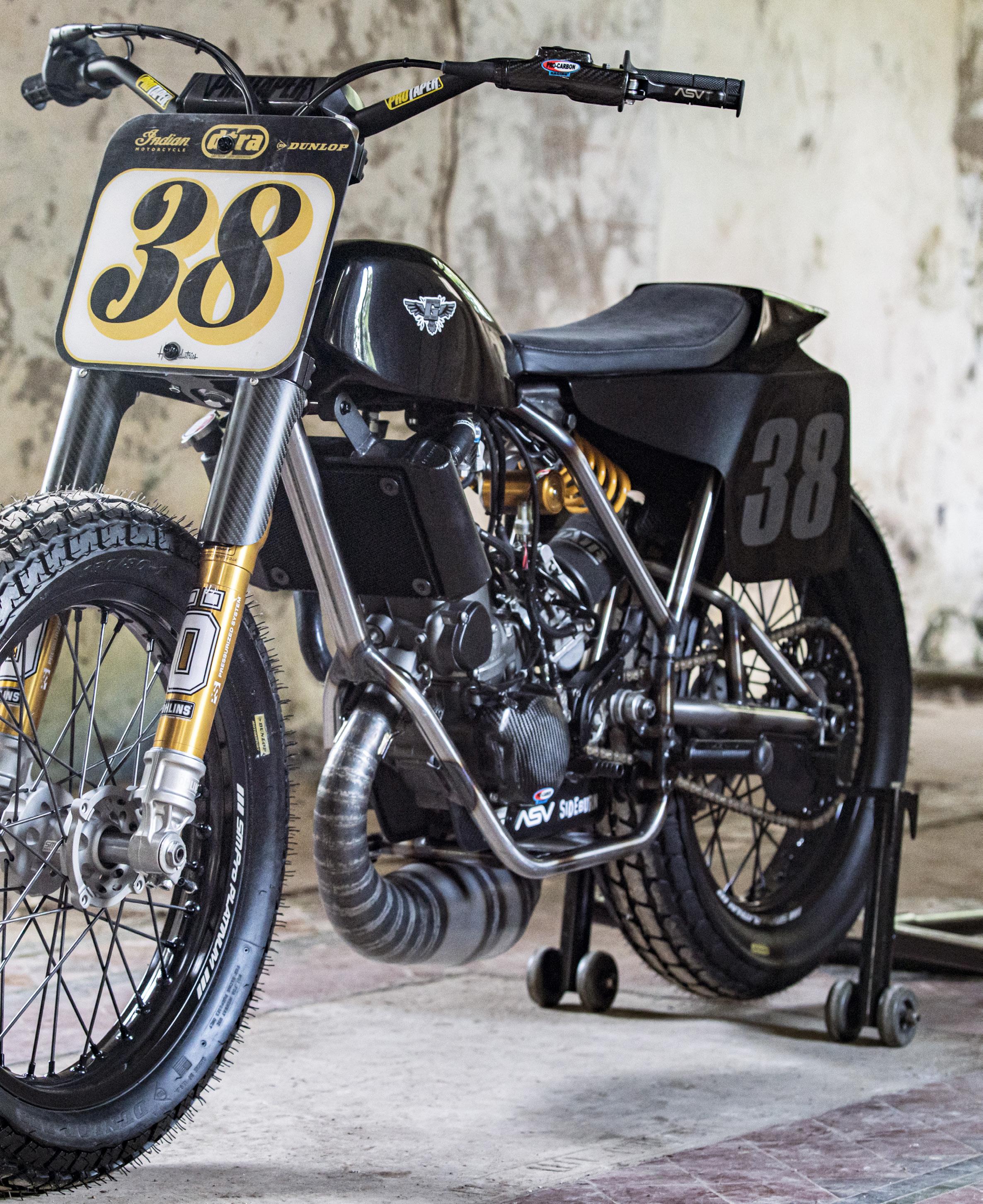
>
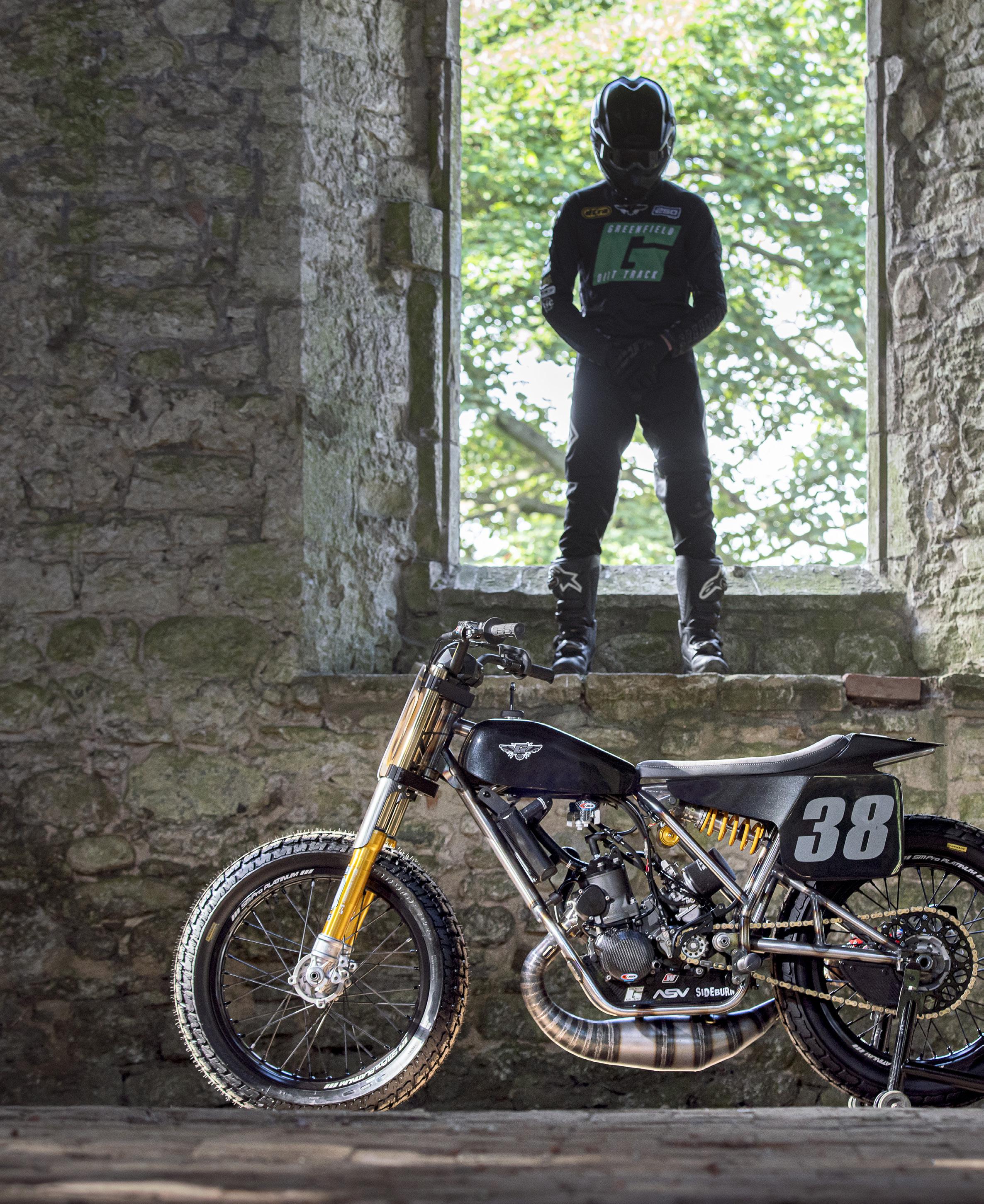
engine appears closer to the back wheel than with a lot of dirt track framer chassis, leading to a short swingarm and more real estate between the front wheel and the front of the engine. The appearance is exaggerated when a modern, compact, two-stroke motor is fitted.

This frame is made from TIGwelded, 16-gauge, BS4 T45 tubing. This is part of ‘adding lightness’. T45 is seamless manganese steel, used in aerospace applications. Because it’s stronger than mild steel, fabricators can use a thinner wall thickness without compromising strength or rigidity. It also helps that it doesn’t need heat treatment after welding.
‘We went with a steering head angle [rake] of 24.5 degrees,’ says George, ‘and added another inch [25mm] of wheel adjustment in the swingarm, so we could make the wheelbase extra short or extra long. It can be adjusted between 52.5in and 55.5in [1333 – 1410mm]. I also fitted a set of Survivor Customs adjustable offset flat track yokes which can be changed from 40mm to 60mm in 5mm increments3.’
Modern 250 framers are uncommon, because there are very few places pros can race them, so there isn’t a lot of knowledge to rely on or refer to. George used the bike’s suspension to create extra adjustment possibilities. Ben Flick at B&G Motorsport in Silverstone made a length adjuster for the Öhlins TTX rear shock, so the swingarm angle can be quickly adjusted between 4 and 9 degrees4 to suit different track conditions. He also supplied the Öhlins RWU front forks longer than they might need, to give extra adjustment each way in the yokes.
Appendix
2. Featured in SB38. 3. See this issue’s C-Tech to read what difference this makes.
4. The angle the swingarm sits at. The 5-9 degree figure is below horizontal and is the line between the centres of the swingarm pivot and rear wheel spindle. On a swingarm like this you’d place your measuring device on the top of the swingarm. Many smartphones have an angle-measuring app as standard. >
‘Once I picked the bike up it was rideable and looking beautiful. Mike had done far more than I expected, lots of the little time-consuming bits as well. My friend Steve Nicholls and I totally stripped it and sent all the engine components off to Factory Coating in Chesterfield to be powder coated. I opted to clear lacquer the frame to show off the craftsmanship and quality of the welding.’
George wasn’t in the mood for cutting corners. He fitted a KTM PowerParts 300cc kit and renewed the whole bottom end; installed a Rekluse clutch; ordered brand new SM Pro 19in wheels and had JS Performance make custom cooling hoses. Survivor made the tank and seat unit. The tank is a fibreglass cover over an alloy cell. Pro-Carbon and Sudo Cycles carbonfibre parts supply further lightness and a factory racer feel.
‘It was important to me to have such a nice exhaust, because it’s always the main feature of a two-stroke, and I wanted it to look special.’ Two-stroke expansion chamber design is much more complicated than for a four-stroke, because the internal pressures and waves of the exhaust gasses leaving the engine can be used to suck the fresh charge – the fuel and air mix –into the combustion chamber. John Riley of Redspeed Racing, Redcar, more used to making racing kart exhausts, created the beautiful front exhaust system.
So, how light is it? ‘The finished bike has a dry weight of only 89kg,’ says George, still sounding a bit surprised it’s as low as just 196lb. ‘We’re happy with that figure, because the little Honda CRF125s we play around on are 91kg.’
KTM claim a ‘weight without fuel’ of 96kg [212lb] for the stock 2020
250 SX. And George’s bike is 21kg [46lb] less than the kerb weight5 Honda claim for a stock 2020 Honda CRF450 – 110kg [242lb], the kind of bike he’ll be racing against in the DTRA series. For further comparison, the minimum weight for an AFT SuperTwin is 140kg [310lb] and for the singles is 104kg [230lb]. So yes, George’s 89kg 250 is seriously light.
‘This obviously has its pros and cons,’ he explains. ‘The bike is very manoeuvrable and turns in very well and it has so much feel in the middle of the corner. It works well on a loose track, but it’s a real handful on a grooved track with lots of grip. It’s all you can manage to keep the front end down. We used a Honda CRF450 front brake caliper for the rear brake, and this is possibly too sharp for the weight of the bike, it’s something I’m going to have to adjust and make changes to. It’s taken around eight months to build the bike and there’s still a lot of setting up to do as we get more time on the track.’
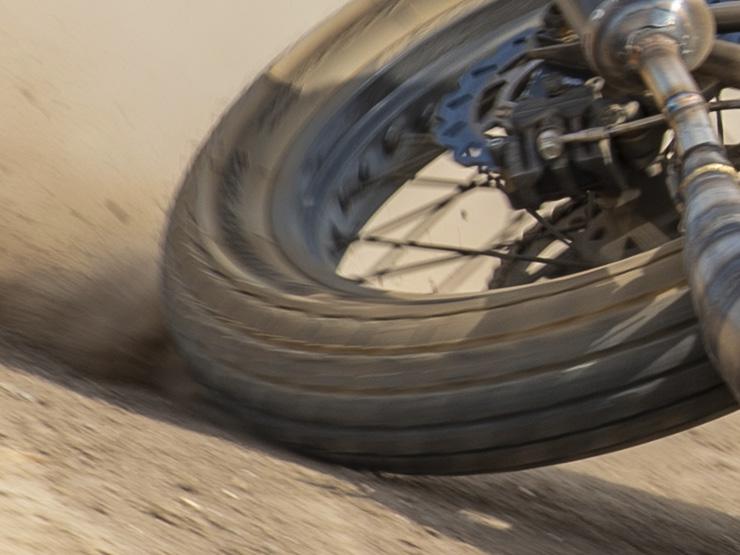

Even though he’s won titles, built bikes, created the UK’s favourite dirt track from scratch, organised events, run race teams... George still reckons, ‘It’s a mammoth task to have an idea in your head and then transform it into real life.
‘There are too many people to thank for their time helping me with this build, but I think we’ve created a real head turner and I hope once we have it set up it’ll be a weapon on the track.
‘It was a bigger job than I realised when I first thought it was a good idea, but we’ve learned a lot along the way and I’m very pleased with what we’ve built.’
We think the weight was well worth the wait.
Appendix 5. Car and bike manufacturers quote different weights: dry, wet, kerb, shipping... and they’re not standardised. Kerb normally means ready to ride with fuel tank 90% full. Dry can sometimes be stretched to mean without even battery acid.
George on the bike he built, riding the track he created from nothing, in the shirt of the team he runs (all while managing the family farm)

>
A disused 13th century church in the wilds of Lincolnshire was a dream location. We just had to wait for the fetish shoot to wrap up



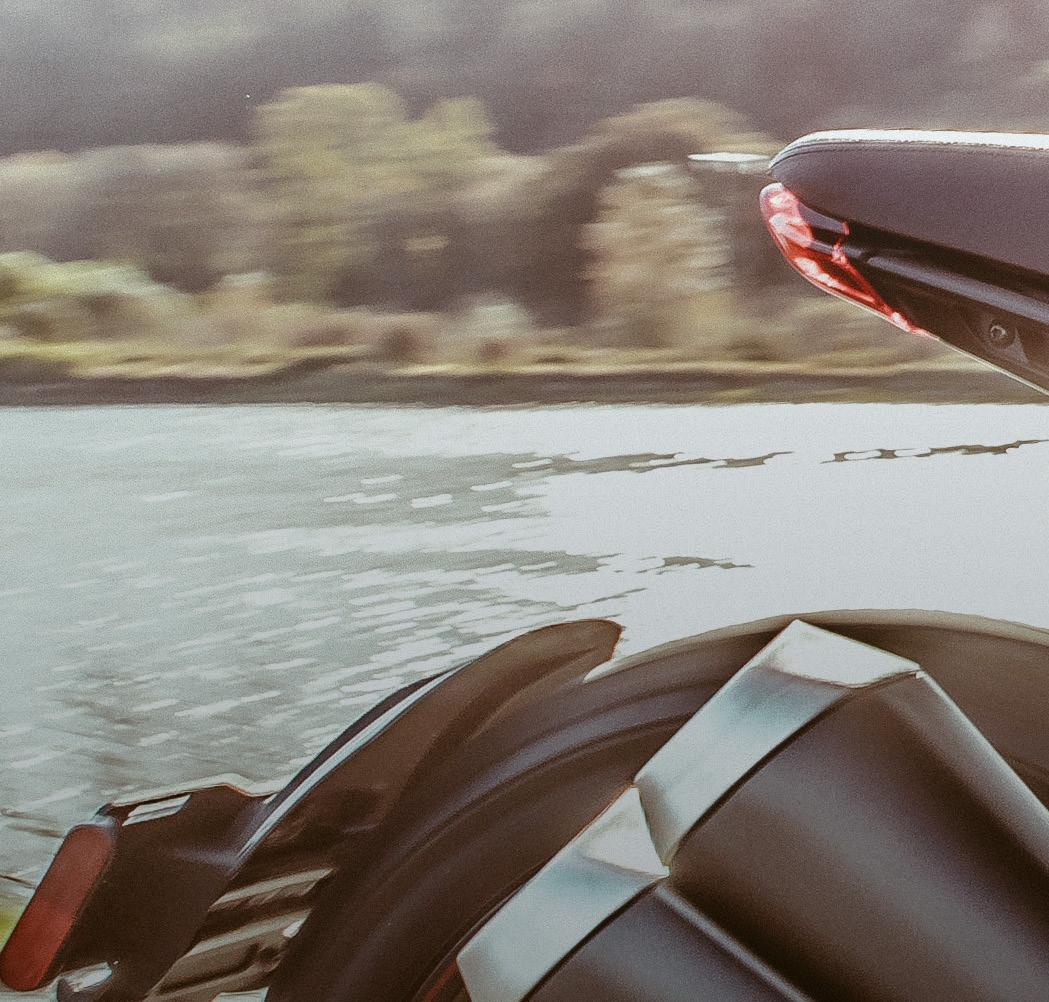
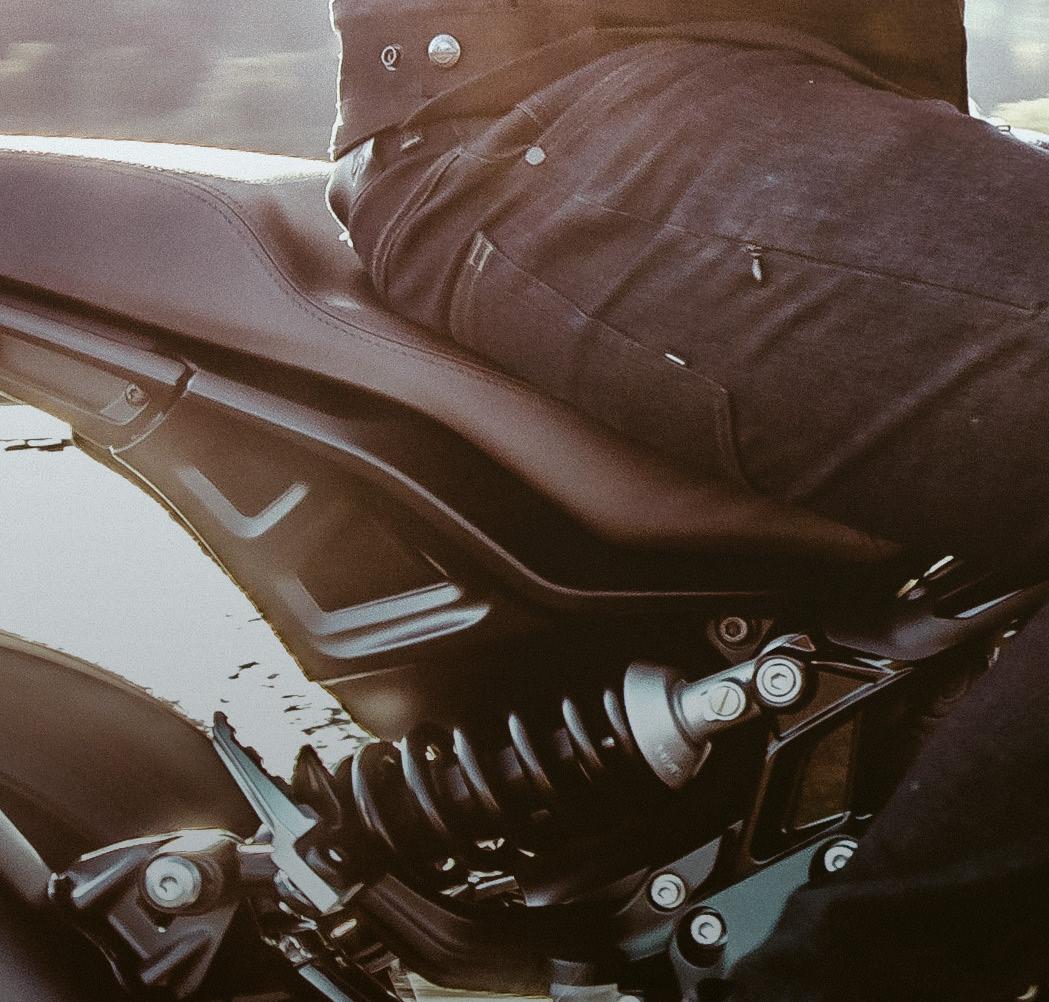
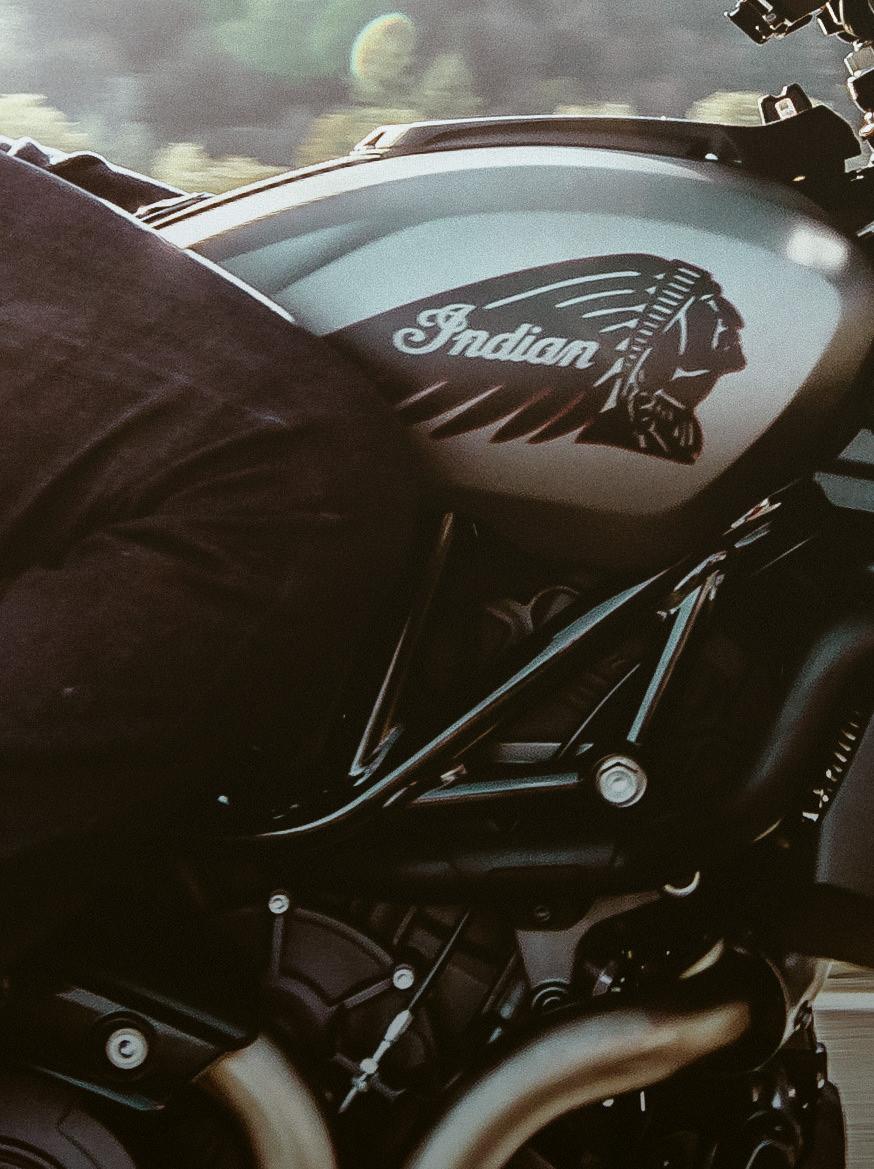
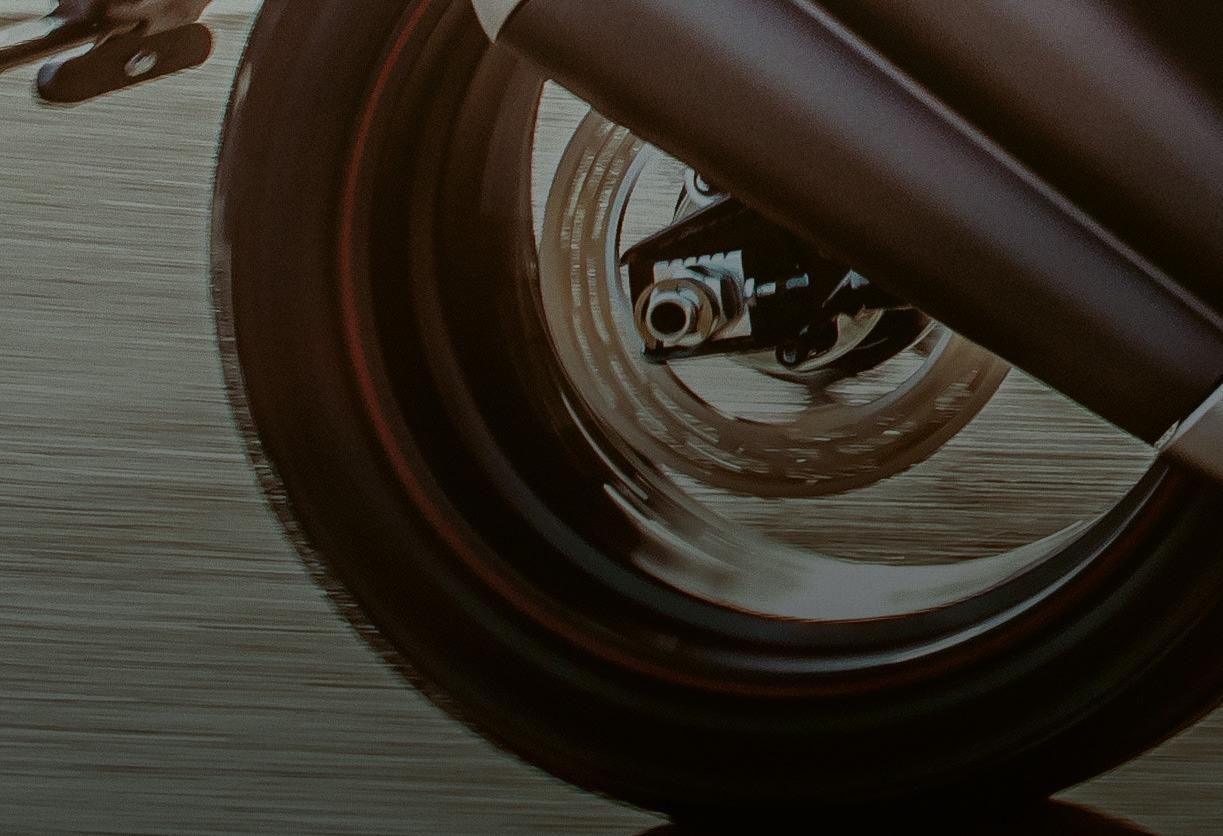

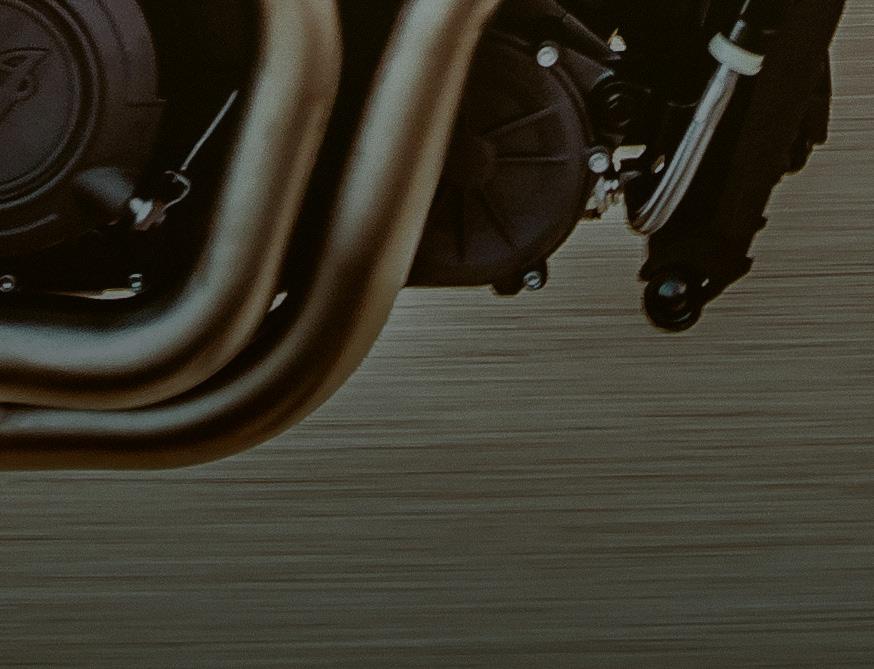




Always wear a helmet, protective eyewear and clothing and insist your passenger does the same. Ride within the limits of the law and your own abilities. Read and understand your owner’s manual. Never ride under the influence of drugs or alcohol. Copyright © 2020 Indian Motorcycle International, LLC. All rights reserved. BOOK YOUR TEST RIDE INDIANMOTORCYCLE.CO.UK/FIND-A-DEALER @indianmotorcycleuk @indianmotorcycleuk Always wear a helmet, protective eyewear and clothing and insist your passenger does the same. Ride within the limits of the law and your own abilities. Read and understand your owner’s manual. Never ride under the influence of drugs or alcohol. Copyright © 2020 Indian Motorcycle International, LLC. All rights reserved. BOOK YOUR TEST RIDE INDIANMOTORCYCLE.CO.UK/FIND-A-DEALER @indianmotorcycleuk @indianmotorcycleuk
SCRAMBLER STYLING







WITH MODERN PERFORMANCE.

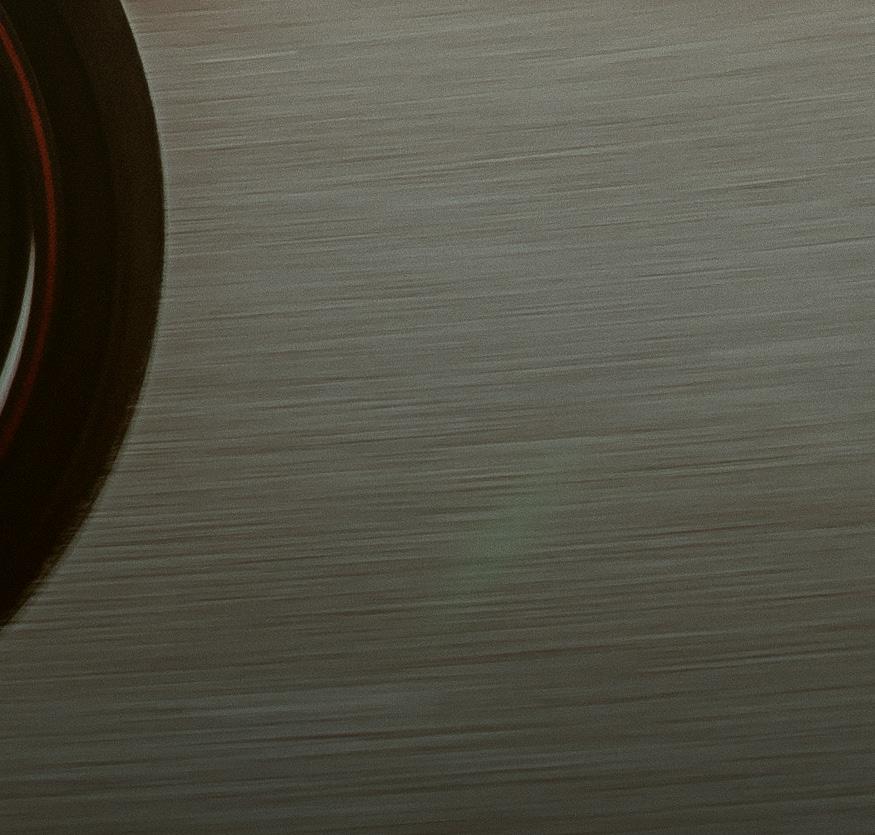


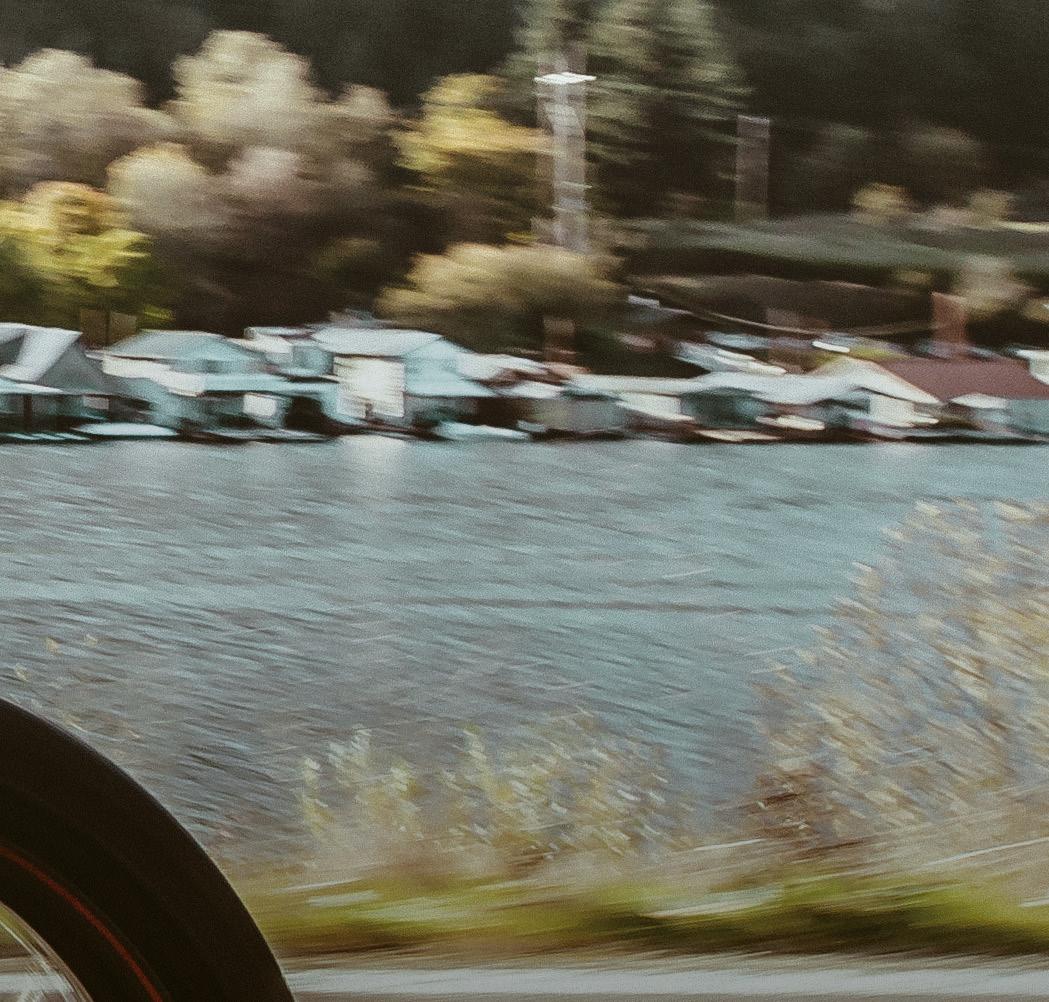
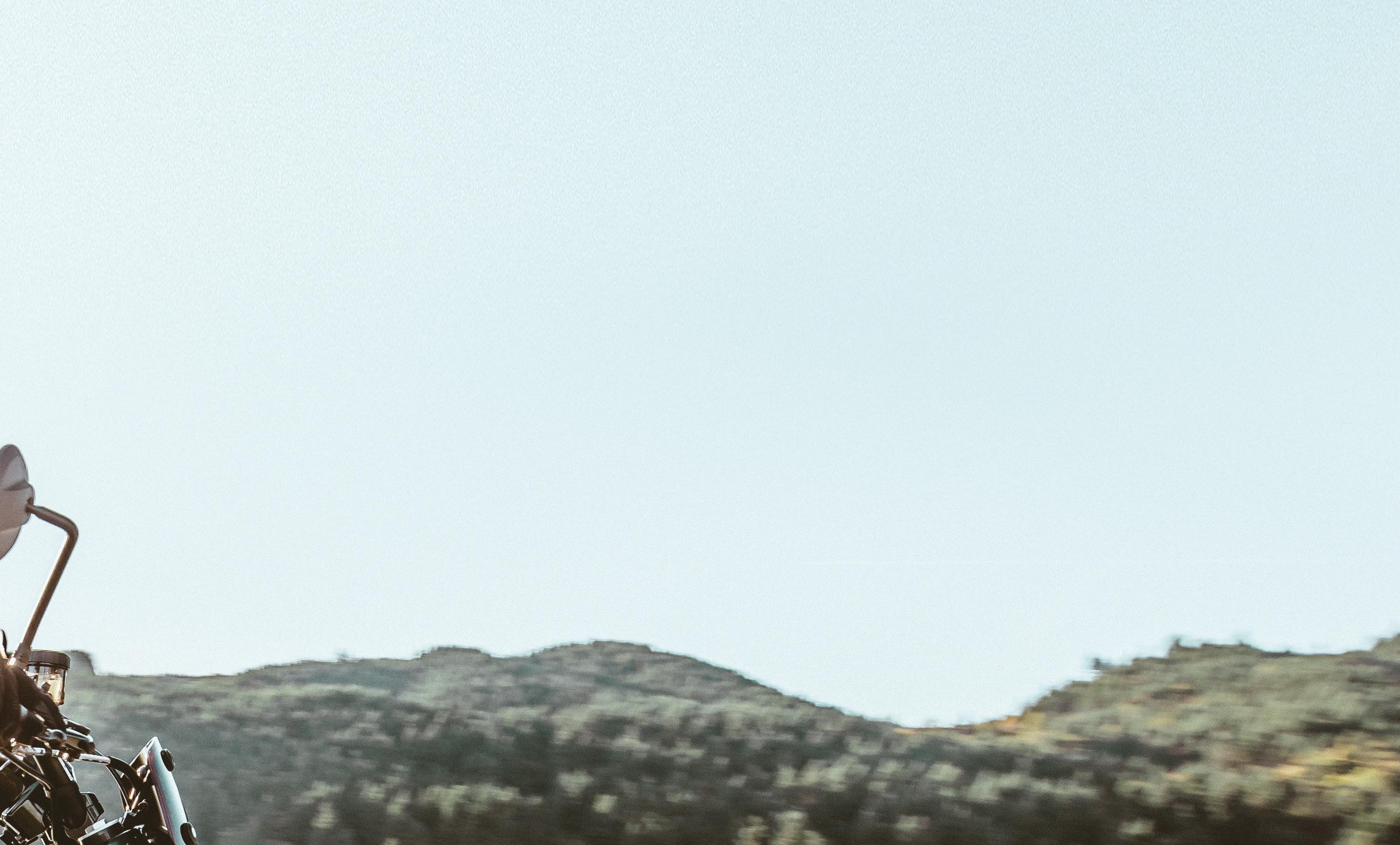
Who? What? When? Why? Where?
Larry Pegram
Interview: Gary Inman Illustration: Ryan Quickfall
You’ve won AMA dirt track and superbike races, and, at 47, you’re still racing in American Flat Track SuperTwins, but what do you remember of your first race?
I had an Indian 50 that I rode when I was three and when I turned five I got my sister’s Honda MR50. She’s five years older than me. I thought I rode on the ice first, because we live in Ohio and in the winter the lakes freeze up, but my dad said I rode the hare scramble first, through the woods on a closed course. It was me and one other guy in the class and I was on an old, three-speed, two-stroke Honda. I won, because the other guy’s bike broke. I would say from that race until now that’s all I’ve done, race motorcycles, every weekend pretty much. If I wasn’t racing, I was thinking about racing.
Was your family into racing?
Yeah, my grandpa raced, my dad raced professionally. He was a flat track and road race guy back in the 1960s and ’70s. He got tenth in the Daytona 200 once, back in the ’70s, when it was real hard, so he was a very good racer. We would go to the local track called Honda Hills, which was owned by a guy named Dick Klamfoth1. Dick had a dealership there and motocross and flat tracks. I’d ride the motocross track but kept sneaking up on the flat track. Dad had a flat track background, so he said, ‘Hey, do you want to do this?’ And I said, Yeah, I like going fast. So
Appendix
I started racing flat track and I never went back to motocross. Back then, you could race pretty much every weekend and never leave Ohio, though we did. We went to amateur nationals. I just got really good at it. It would be very seldom that I’d get beat and I won the amateur nationals every year. I had the record for the most amateur nationals ever won in AMA history at the time. All I wanted to do was race motorcycles, turn pro and follow in the footsteps of Jay Springsteen.
Where and when did you turn pro?
The day I turned 16, which was the rules back then. I turned pro at Zanesville, Ohio. There were Novice, Junior and Expert classes2, and I won the Novice race on my birthday, racing a Wood Rotax. Ron Wood was sponsoring me then.
Did you always plan to leave flat track for road racing?
I knew I wanted to be a world champion, and I honestly think I had a pretty good opportunity to accomplish that. I was on my way, I’d won the amateur stuff; I was winning dirt track nationals at 17, 18 years old; then went into road racing and immediately did really well, but then got hurt in ’93. That was only my third Superbike race ever, third road race ever, and broke my hip and knee. The hip was what got me because I lost a lot of my range of motion, so I couldn’t hang off the bike and stuff, but, you
know, things happen. So I just gritted my teeth and kept racing. I still won dirt track nationals and Superbike races.
Why did you return to pro flat track?
I raced the X Games [flat track] in 20153. Then Brad Baker got hurt, not when he got paralyzed, but he got hurt the year before. Indian had called me up and I filled in, so it kinda got me back in. Even though I went road racing, flat track was always my love.
You have one of the least flattering nicknames in racing, The Worm, where does that come from?
I’ve got a lot of different stories on that, but the real story is my sister used to call me Worm when I was little, so I used to have it on the butt of my leathers and it kinda stuck.
What’s the most memorable win of your career?
There are two. Winning the Hagerstown Half-Mile in 1991 when I was 18, in my rookie year [as an Expert]. That was my first Grand National win and probably my most memorable. But also, in 2009, winning the AMA Superbike race at Road America. That was with my own team, my own bike, my own crew that I’d put together. I went head-to-head with Matt Mladin4 , who’s the biggest dick on the planet, and beat him, heads up. We passed each other seven times on the white flag lap. To do that with my own team was pretty neat.
1. Three-time Daytona 200 winner, when still held, partly at least, on the beach itself. Klamfoth first won on a Norton in 1949. He died in December 2019, aged 91. 2. At the time, a rider turned pro at 16 as a Novice. They had to earn enough points to progress to Junior, and then Expert. This has been replaced by AFT Singles and Twins classes. 3. Pegram was rider/team manager for Erik Buell’s Hero-backed EBR World Superbike team in 2015 until the company folded. Larry was the first rider to score points in WSB on an American OEM bike, as a wild card at Laguna Seca, 2014. 4. Australian Superbike racer, seven-time AMA Superbike champ between 1999 and 2009. Also raced the Cagiva 500 in MotoGP for one season in 1993. Global dick status unconfirmed at time of going to press.
>

21
What’s the best bike you’ve ever raced?
The Skip Eaken5 Honda RS750 I won Hagerstown on. They were all ex-Shobert bikes. When Honda pulled out of AMA flat track, Skip ended up getting the bikes from Honda and started his own team with Mike Sponseller as sponsor. Either that bike or my Ducati [1098R] in 2009, that I won on at Road America. My bikes that season were Troy Bayliss’s factory World Superbikes from the year before.
And what’s the worst bike you ever raced?
A Suzuki TL1000 superbike. The first year I rode for Yoshimura, they had me on a GSX-R750 and the next year, they said, ‘You’re riding this new bike, it’s a TL1000 V-twin.’ I thought, Oh, that’ll be good. And it was not, it had that rotary damper system6. I lived, but barely.
Are you still racing as an AFT wild card in 2020?

Yeah. The bike is Indian’s and the guys from S&S prep it for us. David Lloyd7 has been a friend for long time and we show up and work on it at the racetrack and we kind of prep it between races sometimes, get it cleaned up. It’s a good bike, but it doesn’t have the effort behind it that their full factory bikes do. It’s basically a stock Indian, which is a pretty good advertisement, because we won a couple of heat races [in 2019] on it. I just couldn’t keep up the pace for 25 laps.
Why is a 25-lap main a struggle?
After all, you were fifth at the 2019 Texas Half-Mile.
It’s down to two things. Number one, I just got beat, I’m not afraid to say that. The other thing is, I’m 47 years old and I’m just not able to train the way I should, ’cause I’m sitting in this weed
Appendix
Back to the bikes for the final question: what do you think of the SuperTwins9 evolution of AFT?
I think they’ve done a phenomenal job. Five years ago, nobody was talking about flat track and now people are. It’s hard as a racer, team owner or manufacturer to step back and look at the big picture, but I think that’s what AFT has done. I’ve always said that you need to be a show that has a race involved, not a race that you’re trying to make into a show. You’ve got to make people want to watch the individuals and that’s what they’re trying to do. NASCAR could have an event where they’re all racing tractors and they’d get 30,000 people turn up, so it’s not about the vehicle that they’re racing.
business all day long, trying to figure out how to make [enough for] my kids to go to college. I try to race just to have fun, but my real goal is to try to win a race or two, that would be really cool.
Wait. Weed farm?
I own one of the largest marijuana cultivation facilities in Ohio8. We’re about a year into the programme and have a 53,000sq.ft facility growing cannabis, and three dispensaries as well. I was completely illiterate to what the whole cannabis industry was about because I just believed the ‘Just Say No’ type stuff. Then I got into it and realised that there’s a ton of medical issues it helps with better than any conventional medicine. Our median customer is 55 years old and it relieves their pain without them being in a fog all day, like they would be with opiates. You take the correct doses and you don’t get high. I actually became a real advocate for it.
You gotta make the racing close. In my opinion, if a guy wins eight races in a row, turn them around backwards on the back row for the main event, you know, make a show out of it. If you’re in tenth place at the halfway and you win the race, you get five extra points.
A monster truck show and WWE wrestling can fill 100,000-seat stadiums and people say, well, flat track racing is way better than that. It is to me. It is to you, but obviously it’s not, or we’d have a 100,000 people at our races. How do we make this into a show? You need rivalries. You gotta have two guys that don’t like each other. You don’t even need anybody else in the race. You know what I mean? You’ve got to have two guys and everybody gets on one side or the other, and it’s no different than football or baseball or anything else. We know the Springfield Mile is the greatest sports spectacle we’ve ever seen. You’ll have 120 lead changes in 25 laps with 15 different guys, but we don’t have 100,000 people standing around to watch it. So we’ve got to figure out how to think outside of the box.
5. Racer, factory Honda flat track tuner and privateer team owner/tuner. Won multiple dirt track and superbike titles as a tuner. Eaken died in 2012. 6. Instead of a regular piston-and-spring-style rear suspension unit, Suzuki fitted their Superbike with a rotary damper, more like those used for closing doors. It was universally derided and dropped from production shortly after release. 7. Of Lloyd Brothers Racing, most wellknown for campainging Ducatis in AFT. 8. Pegram, with no previous agricultural experience, saw an opportunity after the collapse of EBR. He can only sell his crop in Ohio, where marijuana is legal for medical, not recreational use. 9. For the 2020 season, American Flat Track’s premier class has been renamed SuperTwins. The main difference is that all entrants will make the final, qualifying is simply to determine grid position. This brings AFT in line with major motorcycle race series like MotoGP and World Superbike.

MAX28 EXPANDABLE BACKPACK Utilising Kriega’s groundbreaking Quadloc-Lite™ harness, combined with high-tech construction materials to meet the demands of the modern-day urban rider. • 100% WATERPROOF ROLL-TOP LAPTOP POCKET • FOLD-DOWN COMPARTMENT WITH ORGANISER POCKETS • MAIN SECTION EXPANDS TO CARRY A FULL-FACE HELMET KRIEGA 10 YEAR GUARANTEEKRIEGA.COM #RIDEKRIEGA NEWphoto credit @gorm_moto

Flat Track Geometry
I HAVE NEVER been a great math student. At school, I didn’t want to know all the inbetween steps on how to solve a problem, I just wanted to get the right answer and move on to the next task, or a subject I was better suited for, like physical education or recess. I relate this outlook to some of the things I know when it comes to setting up the geometry of a flat track race bike. I don’t always understand the science behind why a certain change to the front end of the motorcycle reacts the way it does, but I know what works for certain racetracks and I can simplify it enough to explain it.
CLAMP DOWN
One major area of geometry adjustment is the triple clamps [aka fork yokes]. Many flat track race bikes are fitted with adjustable triple clamps that allow racers to change fork offset relatively simply. Offset is the distance between the centre of the steering stem and the centre of the fork legs. Lots of companies make adjustable triples clamps. Some are altered by changing the spacer plates in the clamps, but more commonly by changing the eccentric inserts that hold the steering stem. Changing the offset alters the way the bike handles and steers going into the corner, and, more importantly in my opinion, how the bike keeps its wheels in line when you get on the throttle. Adjusting the offset changes the front end trail without altering the rake. Whole books have been written about motorcycle geometry with all sorts of graphs and all that stuff, but I’m trying to make it simple for you, so I’ll leave it to that statement.
GET INTO OFFSET
Every twin-cylinder flat track motorcycle that I know, and I’ve ridden pretty much all of them, starts with 60mm offset. This is ‘zero offset’ and the eccentrics are usually marked with a zero on the top. If you’re happy with how the bike is behaving, leave the eccentrics at the ‘zero’ setting of 60mm. If you feel forced to make an improvement, here’s my advice. When adjusting the triple clamps, I usually use 2mm increments, because only changing it 1mm isn’t enough to feel a real difference. Putting in a 2mm insert with the number forward changes the offset to 62mm. Putting the same insert
in backwards changes the offset to 58mm.
There are two eccentrics and you have to pop one in both the top and bottom triple clamps.
I’ve run as far out as 65mm and as far back as 55mm, depending on the bike I’m riding and track conditions. Adjustment is simple, but sometimes it takes two people if they’re clamps where the front end has to come off the bike while changing the eccentrics.
STEERING AND STABILITY
Some mechanics have a different theory on what the feel of the bike should be when adjusting the triple clamps, but I’m describing my seat-of-the-pants experience. Generally speaking, on cushion racetracks, where the bike is steered with the throttle, I like to have my front end pushed out with a 62mm offset. This helps keep the wheels in line when I’m accelerating out of the turn and gives me less chance of highsiding off the corner. The bike seems to drive off the corner better, because I’m not chasing the rear end. One negative of running with increased offset is the bike doesn’t turn as sharply, but on a cushion you steer with the rear wheel while twisting the throttle, so that’s less important. If I ran a 55mm offset on a cushion track, I would most likely be fishtailing everywhere. It might look cool in photos, but it’s quite a bit slower, because I won’t be driving forward off the corner if the tail end of the bike is dancing around. Sometimes this varies when riding a street bike, but another negative I’ve found from having your front end pushed out is less stability down the straightaway. On some mile tracks that are rough or with high winds, this might cause the bike to wobble and the bars to shake a bit, or tank slap. This term reminds me of a pretty sweet podcast available for free on iTunes called Tank Slappin’! [Co-hosted by our man Cory and, originally former GNC number 1, Jake Johnson, not Sammy Sabedra. Widely available and well worth a listen. Ed]
On clay tracks, and surfaces that have some grip, I typically reduce the offset. Remember when I said pushing the eccentrics out on a cushion track helps keep the wheels in line when I pick up the throttle? This is where things are bit confusing, because I feel like the wheels stay in line best entering a corner with eccentrics
pulled back, running a 58mm or less offset. So, on cushion or loose tracks we typically increase the offset to 62mm or more. On the clay or hard-packed tracks we’ll reduce it to 58mm or less.
FRAME FACTOR
Every motorcycle handles differently, even with the same offsets. The handling of my Harley-Davidson XR750 feels way different with 58mm offset than when we run the same offset on the G&G Racing Yamaha MT-07 I won the 2019 AFT Production Twins championship with. Basically, every time you ride a new bike, you have to start from scratch and find what works best from testing and experience on the bike. Frame ergonomics have a lot to do with the different feel in offsets, as well as where the motor sits in the frame, the wheelbase and so on.
DTX 450s have leading-axle forks, so the geometry is quite a bit different. I can’t ride a DTX 450 with negative offsets, it has to be stock or increased offset. Those bikes already dance around through the corners, because they’re designed to hit jumps and bang ruts, so pulling back the offset makes them almost impossible for me to ride.
RAISE ’EM OR DROP ’EM
Another way of adjusting the front end is to effectively change the length of your forks by raising or lowering them through the clamps. Doing this affects both the rake and trail. Raising the forks through the clamps, so the top of the fork legs is closer to the handlebars, gives similar results to reducing the offset, so going from 60mm to 58mm or less.
Confusing? Too many options? Welcome to my life as a motorcycle racer. I would add that if you’re making wholesale adjustments on race day, you’re most likely riding the struggle bus and your mechanic is probably saying, ‘Let’s try it. What do we have to lose at this point?’ A good day at the track is maybe a tyre pressure adjustment and 1-2 teeth on the gearing.
THANKS to long-time mechanic Brent Armbruster who has tuned for guys like Jared Mees, Brandon Robinson and Jake Johnson; Bob Weiss of Weiss Racing.
25
You’re chasing the perfect set-up with your fancy adjustable triple clamps, but what do they do? AFT champion Cory ‘C-Tex’ Texter is here to explain
Illustration: Prankur Rana
C-TECH

©2020 H-D or its affiliates. HARLEY-DAVIDSON,
HARLEY, H-D,
and the
Bar
and
Shield
Logo are among the trademarks of H-D U.S.A., LLC.
Iron out your soul.

The IRON 883™ is stripped down, blacked out and ready for the streets. Learn more at H-D.com. It’s time to ride.
Ryan Varnes The Rider
aft vs
the new normal
The 2020 American Flat Track season finally got underway in mid-July. With the paddock in lockdown, we relied on insider Sammy Sabedra to take the sport’s temperature

Words: Sammy
Photos:
Sabedra
Sammy Sabedra,
Scott
Hunter, Kristen
Lassen
Brian Willis The Team Principal
Sammy Sabedra
Sammy has been embedded in flat track since he could balance on two wheels. Now he is a mechanic for AFT Production Twins contender Ryan Varnes and co-host with Cory Texter of the Tankslappin’ podcast
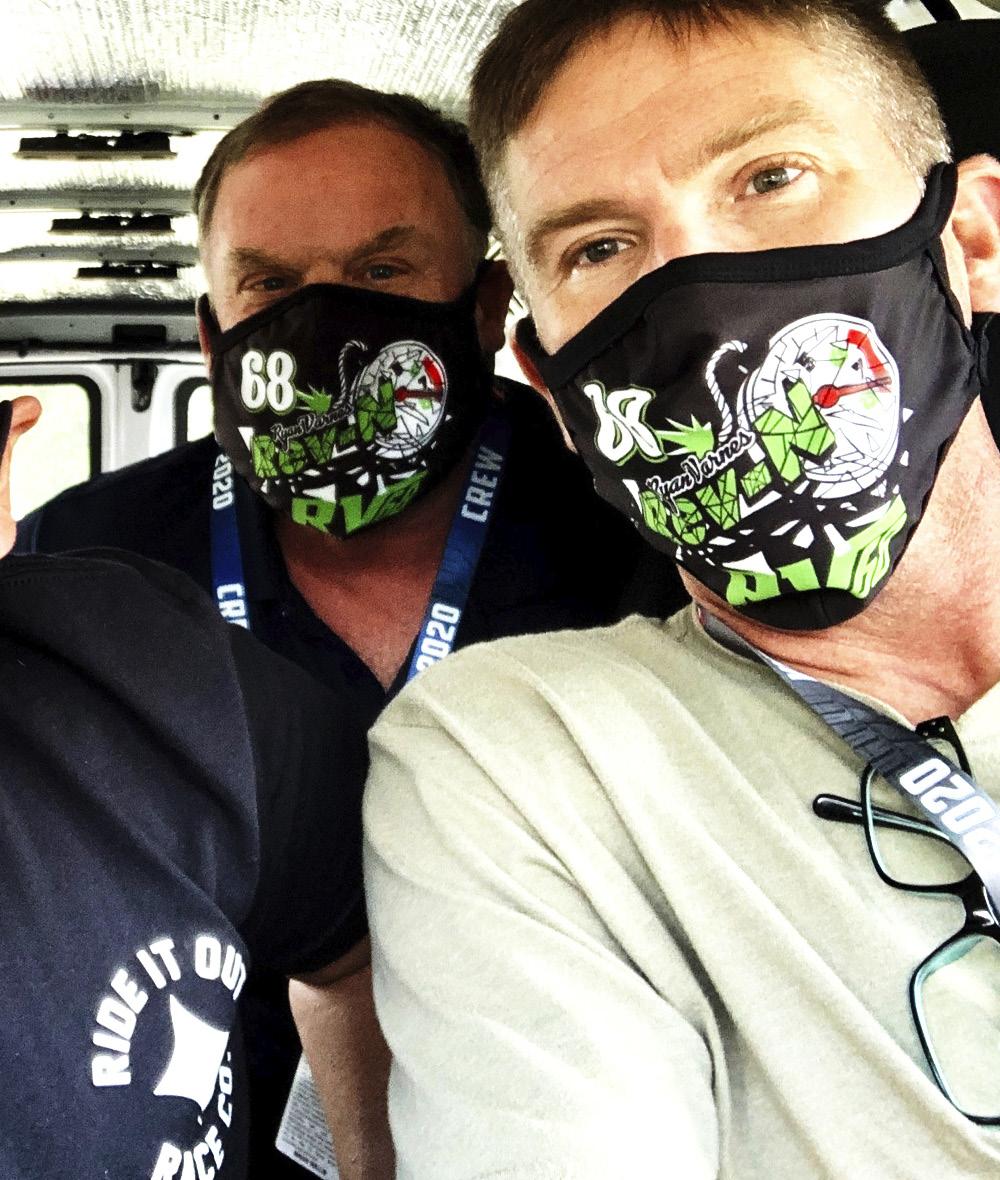 Kevin Varnes The Mechanic
Kevin Varnes The Mechanic
29 >
FTER WHAT FELT like an eternity of waiting, we were finally on our way back to Florida for the opening two rounds of the American Flat Track series at Volusia Speedway Park. We’d been in Florida – Daytona to be exact – back in March, when the original season opener was cancelled with just 24 hours to go. It felt almost unbelievable to be heading to a race again, 290 days since the last AFT round.

We left our Pennsylvania race shop at 6am for the 15-hour drive. Here in the States, local governments can step in at a moment’s notice and shut things down fast, so we had doubts if the event would even take place due to the recent spike in coronavirus outbreaks. A few hours down the road we spotted another team, heading south and, just like that, things felt normal again. Horns honked and social media posts were tagged as we drafted past each other like we were on the Springfield Mile’s straightaway.
(top left) Varnes junior and senior discuss set-up; (far left) Socially distanced crowd on a sweltering evening; (left) Cory Texter, Production Twins number one, said he was happy to be racing again, but was also nervous of the possibility of infection and didn’t take chances; (above) Varnes, Texter, Rispoli, Armstrong make the front row



(left) New season, new control tyre and longer, timed races add a chance for race strategy to make a difference; No one uses Kawasakis in the SuperTwins class, but they can still win in Production Twins. Varnes uses Big A frames; (bottom) There is new normal and there is just normal – Mees winning races is the latter. He won both nights; (bottom left) Varnes lining up Rispoli on the Harley for a lastlap smash and grab
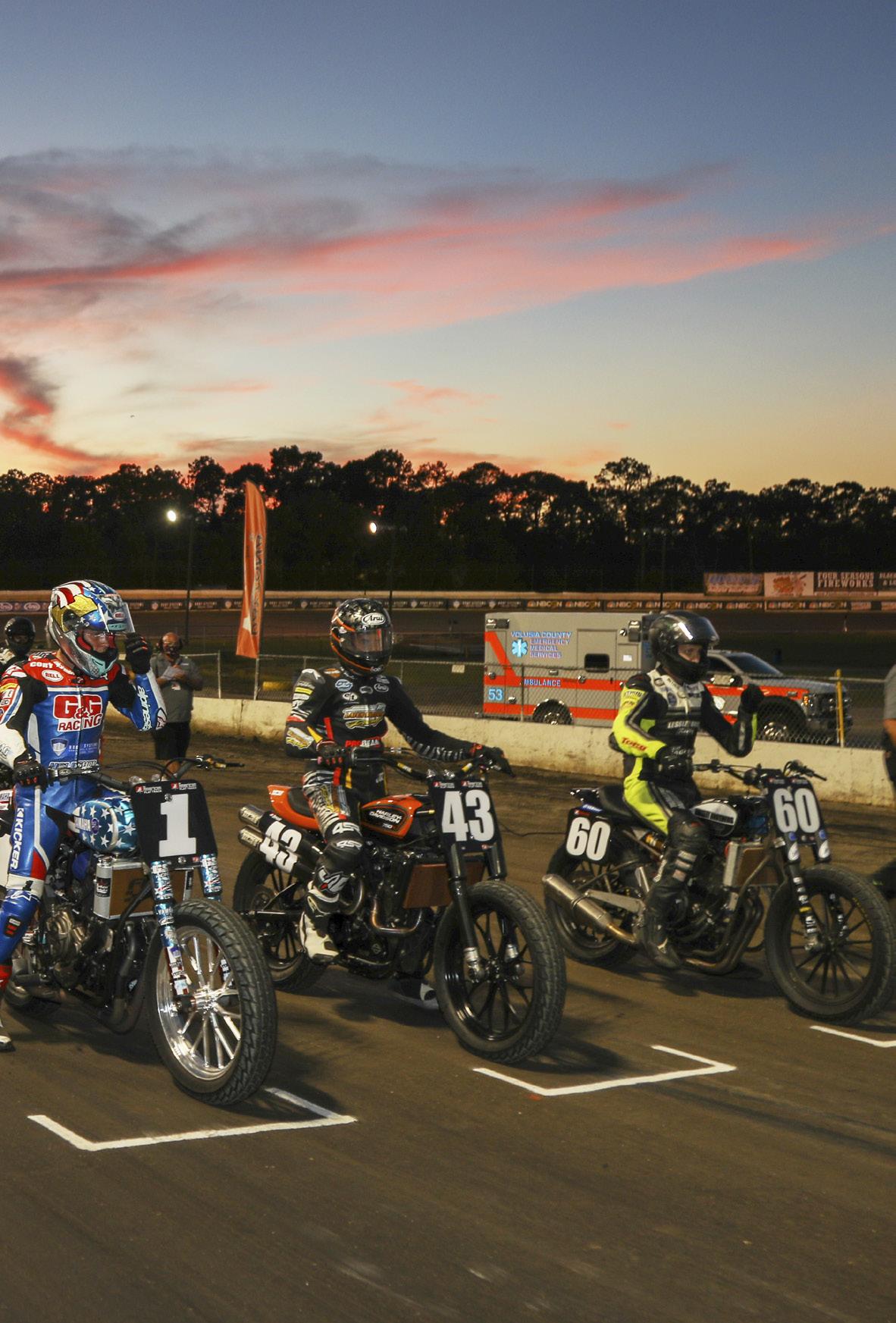

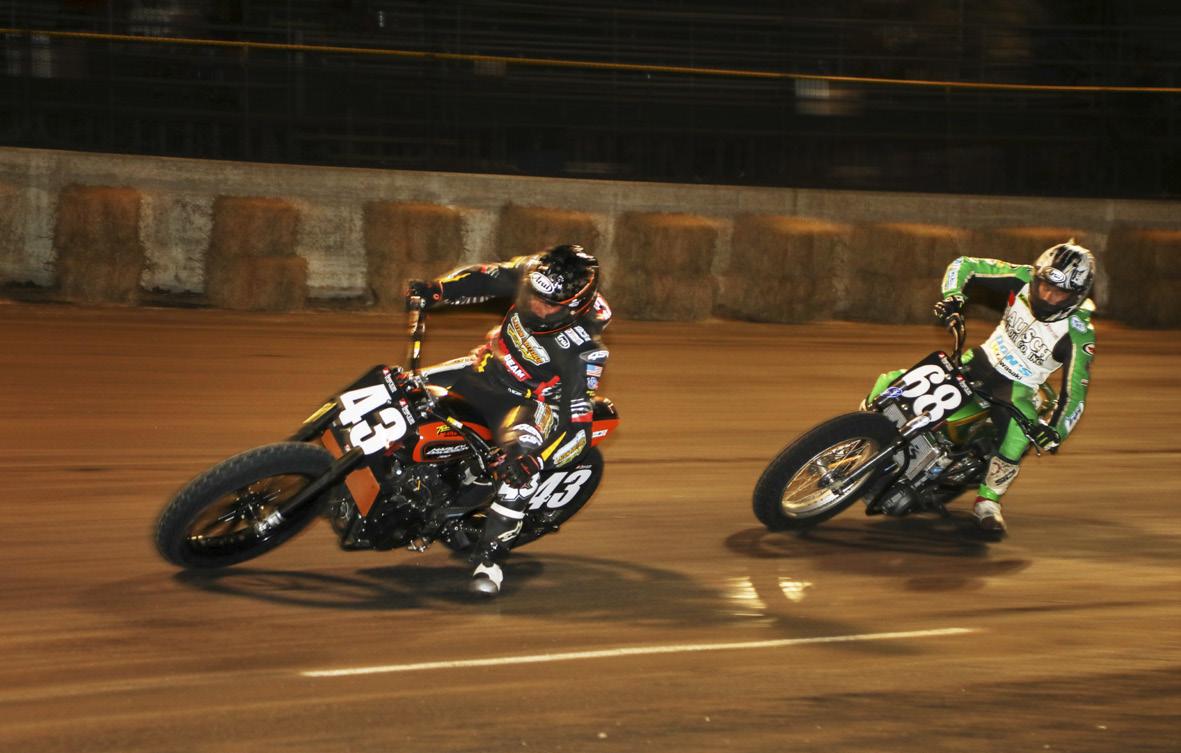
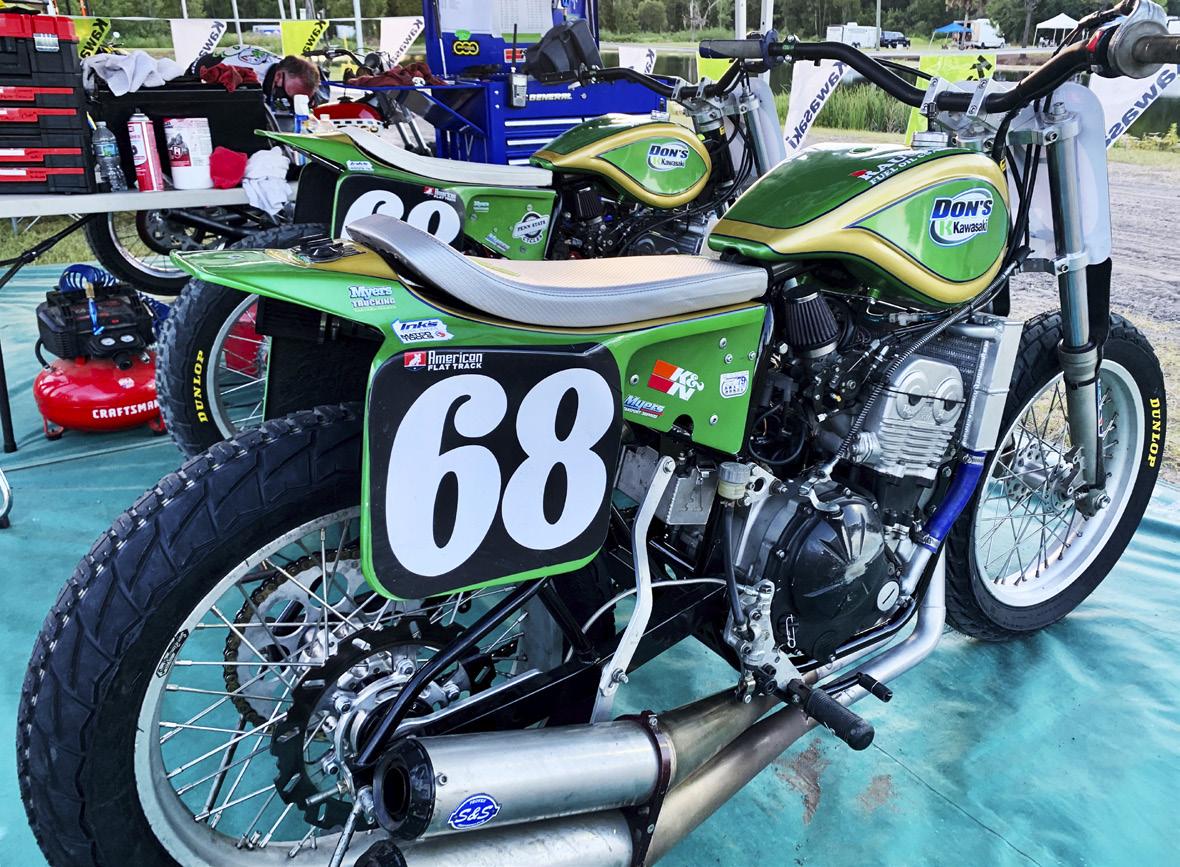

>
By the time we arrived in town to start the weekend double-header, emails were arriving from AFT with new health and safety regulations and protocols. The new process was more on a par with an international border crossing than the usual smile and simple credential check it usually took to enter a race facility.
Traditionally, we would arrive at the track by 8am for a night event, but in this new era teams were given orders to arrive in a specific slot to avoid everyone showing up at the same time. The Ryan Varnes Racing Production Twins team was slated to arrive at 1.15 in the afternoon. After being cleared from the initial arrival zone, we navigated through a series of three additional checkpoints. No one in the vehicle was allowed to set foot outside through the entire process. Safety personnel checked our temperatures at the first stop. The last two checkpoints were for further health evaluations and credential scans. After clearing all the checkpoints, we were finally permitted to enter the facility. The AFT crew did a great job with the whole entry process.
Once inside the gates, the general vibe in the paddock was far from the usual social event we’re accustomed to. Teams were encouraged to keep social interaction to a minimum and race fans would not be permitted to enter the paddock at any time, meaning the popular pit walks, prior to the day’s main event, were off the schedule. Interacting with the fans is usually one of my favourite parts of an event, but while they were missed it was nice not to have any outside distractions. In another effort to help maintain social distancing, the paddock layout for the weekend was split into three distinctive sections for each class – SuperTwins, Production Twins and Singles – with additional space between each team. Another big change for the weekend was the use of video links for mandatory rider and crew briefings by AFT operations.
than making a few fine-tune adjustments to both our primary and back-up motorcycles, our test day went extremely well. By day’s end, the team knew Ryan would be tough to beat come race time, 24 hours later.
Race day, and months of preparation would be put to the test. Our efforts as a team would now be measured by race results. As one of two team mechanics, my job is to make the rider feel as comfortable as possible on the motorcycle so he can ride to his limits. At this level, it is already a given that all riders have a very high level of riding talent. Short of writing a book, it would be hard to sum up the amount of hard work and dedication it takes to be competitive at any level in this series.
I raced in Florida and all I got was a pickled ’gator head nailed to a plank of wood

On night one of the double-header, the team made all the right decisions. We gave Ryan the best motorcycle possible and he went out and did his job perfectly, making a last-lap outside pass for the win. When it all comes together for a team, the feeling of victory is like no other. Perhaps the greatest reward a rider can give his mechanic is a wave to hop on the back of the motorcycle for a victorylap celebration. And that’s what I got on that Friday night. It’s a feeling I wish everyone could experience at least once in their life. I felt on top of the world waving that chequered flag, then seeing our rider standing on top of the podium.
Our race weekend began with the first official test day of the year. Ryan’s mandatory skeleton crew was made up of team principal Brian Willis, mechanics Kevin Varnes (Ryan’s dad, who was racing the Bultaco Astro Cup support race, too) and me. Although Volusia has never hosted a national, it’s a track we’re all very familiar with, because there are races there in the runup to the regular Daytona season openers. Thanks to the combined experience the team has at this fast, half-mile oval, we had a pretty good idea of what to expect. Other
As good as some nights are, others can be the complete opposite. Night two was a rough one for the team. We were once again on pace and fighting for second [behind Cory Texter] when, with just a few laps to go, Ryan coasted to stop a few feet from the very same spot where he’d stood on top of the podium the night before. The cause: a broken intake valve. To add insult to injury, Ryan’s dad, Kevin, [himself a former national number] would also suffer mechanical problems while leading the Bultaco Astro Cup race on the last lap. He still had a big enough lead to coast to a third-place finish.
Leaving the track and thinking about the weekend on the drive home, I was happy. It felt good to get back to racing. Even though we had one bad night, the weekend was still a success for us and the sport. The American Flat Track crew proved they could deal with just about anything thrown at them in a time of huge uncertainty. They did a great job with track prep and the level of professionalism within the paddock made it clear it was a world class event. I can’t wait until the next one.

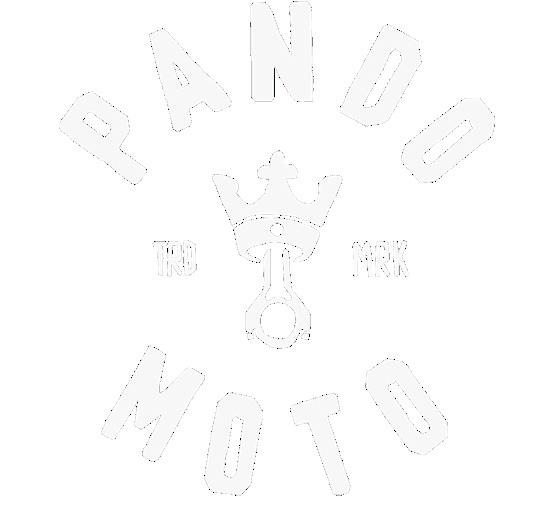
MOTORCYCLE GEAR ENGINEERED BY RIDERS FOR UK INQUIRIES PLEASE CONTACT: WWW.DPC-DISTRIBUTION.COM | +44 (0)870 122 0214 PANDOMOTO.COM @PANDOMOTO
Payback
Sideburn contributor Scott Toepfer explains his move into sponsorship
Photo: Kristen Lassen/American Flat Track
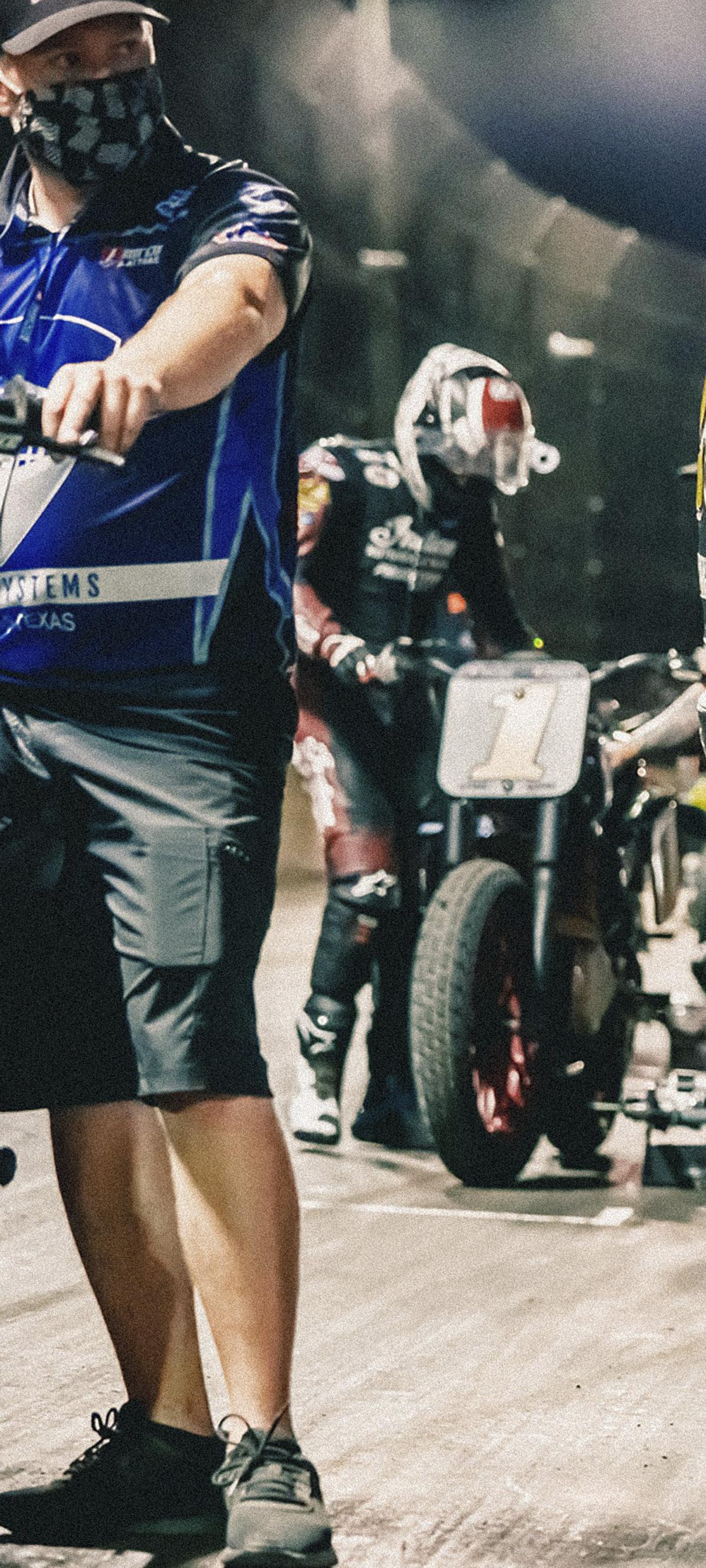
EVERYONE
LOVES AN underdog. In motorsport, the privateer racer is the ultimate example. Going up against the better-funded and corporate factories, the privateer stands quietly and proud.
Somewhere between my final crash racing my Champion Triumph [featured in SB38] and the announcement of the AFT SuperTwins class, I decided I wanted to support dirt track racers. I’d never amount to much aboard a bike, nor am I able to turn wrenches well enough to fill a crew member’s role, so sponsorship came to mind. A little funding for tyres or fuel, a couple of stickers and an exuberant ‘Good luck this weekend!’ seemed like a decent start to a simple programme. Thus, SGT Racing was born.
I don’t sell roofing, nor do I have a logistics monolith, but my professional skill set is in photography and video production. Riders don’t just need money, they also need the means to help attract bigger sponsors so that they can make the next race and the next season. My goal with SGT Racing (SGT are my initials by the way) would be to serve the riders in two ways: traditional monetary sponsorship and a media package of photos and video I would create.
Now, which rider to support... The idea from the outset was to focus on a rider or two that I’m inspired by (we artsy types love to be ‘inspired’) and see if my sponsorship programme would be of interest. This was a much easier choice due to the creation of the AFT SuperTwins class. Knowing I wanted to work specifically with a privateer racer, and the field of riders for the season being more or less decided before the season began, I immediately landed on Jeffrey Carver.
I’d met Jeffrey, photographed him during at least two or three races, and seen him whoop on the famed Wood Rotax at Willow Springs, but we weren’t anything more than passing acquaintances. I’d seen him ride, and win, and take a chance at going it alone in SuperTwins against the better-funded outfits. That was all I needed to reach out.
Carver was nothing but classy and cool, and despite the humble beginnings of my first foray into sponsorship support, he has been patient with me. Just to be clear, I take photographs for a living, which means there isn’t always a lot of extra cash floating around at any given point in time, so the SGT Racing fund will have a humble beginning. If I was going to put money directly into any corner of the competitive, two-wheeled sporting world, it would be for the privateer dirt track racer. I owe a lot of my work to the motorcycle industry, and if I’m going to give back, it’s going to be to the industry that has helped to keep my family fed, and my head clear.
Visibility
SGT Racing could be a vanity project, but who wouldn’t get a buzz from seeing their ‘company’ on the grid?

35
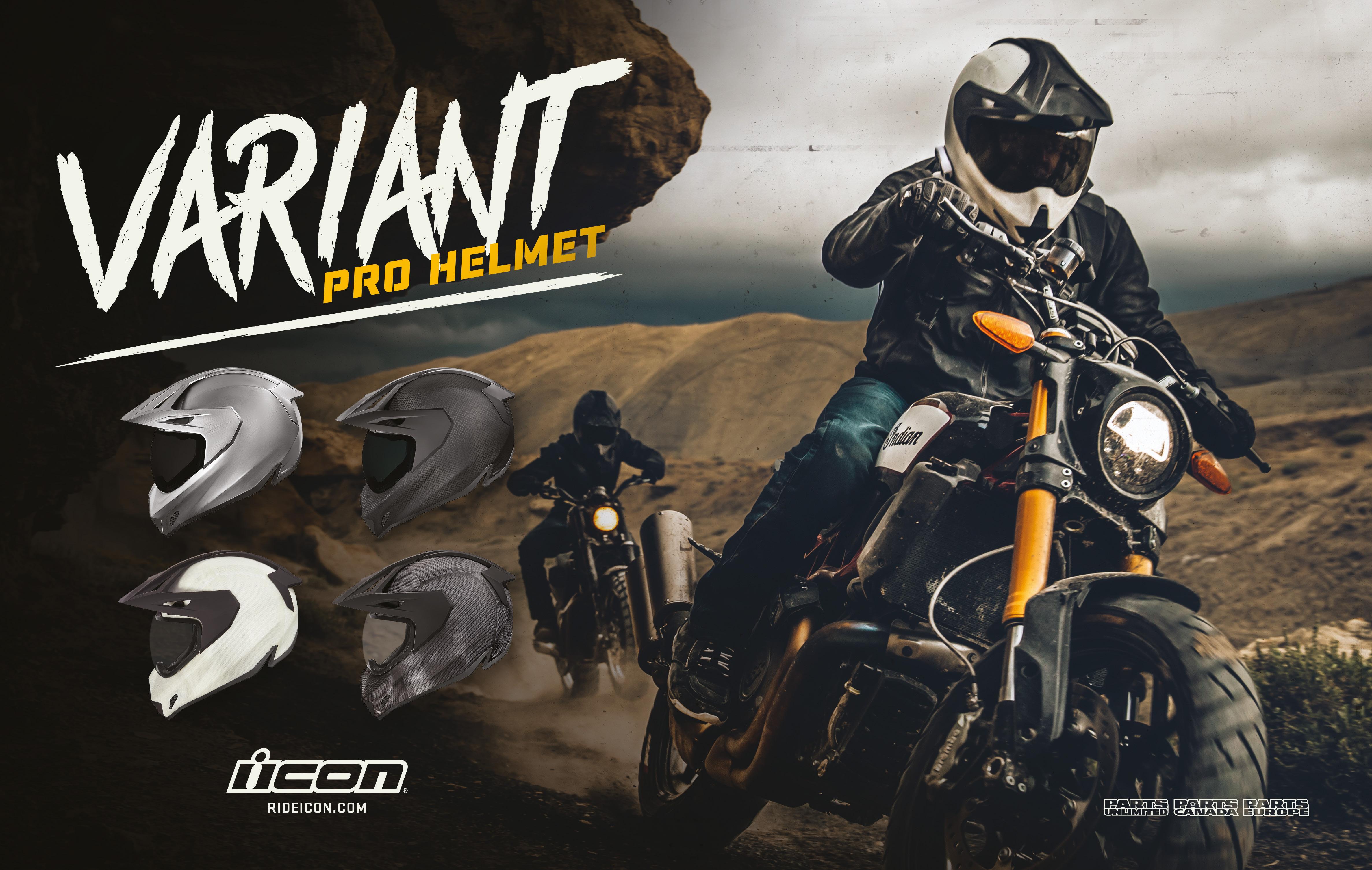

SX APPEAL
ARE YOU READY for a long story? OK. When
I lived in Amsterdam, back in 2002, I went to a family gathering at my uncle’s house. While mooching in the shed I found a 1974 Suzuki TS250. He’d bought it from American oil rig contractors when he worked in Yemen and brought it back to the Netherlands in ’79 or ’80. When he got it back he realised it had two bullets lodged in the forks where it had been shot. My uncle said he hadn’t started it for a couple of years, but we put some gas and oil in it, gave it a couple of kicks and... tadaaaa! It started! My uncle decided to give me the bike and I’ve had it ever since, even though it’s been stolen, then found again, five times in Amsterdam.
Once, I went to get parts for it from a big vintage motorcycle and car show and found a similar bike to mine, but it was all black and with Harley-Davidson on the tank. The price tag was pretty high, they were asking about €7-8000 ($8-9000 at current exchange rates) for what I
found out was an SX-250. I wanted one, and eventually found a rolling chassis with paperwork and slowly started to find all the original parts to rebuild the bike.
While accumulating the parts, often having to order them by fax using the exact part numbers from an old guy in America, I started to acquire extra engines, a second frame with papers, more tanks…
Then life changed course when I met a beautiful lady while working in Barcelona and decided, in 2007, to move to Spain with all the bikes and my dog. The TS250 came and the two Harley frames; three Kawasaki Zeds; a Honda XL500S; 1961 Vespa GS150… I finally finished the Harley SX-250 at the back of our terrace in the middle of Barcelona. Then I met Ferran Mas1, who asked if he could do some pics of the bike for a classic bike magazine. Since then, a full decade ago, the Harley has been pretty much unridden and stored in my workshop.
By 2009-10 I’d become busy with La Corona Motorcycles2 in Barcelona – four guys, including me. We’d built
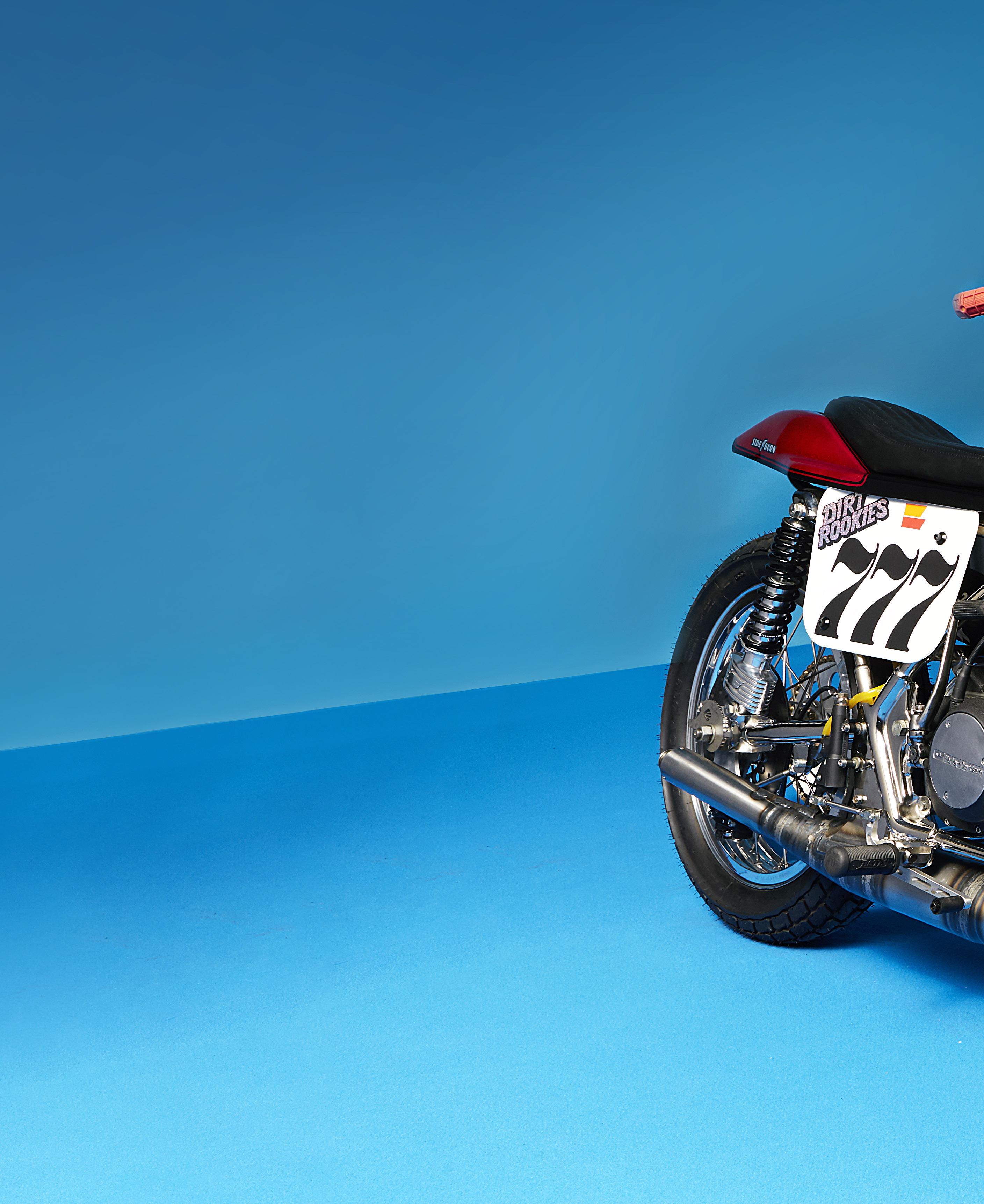
Jonas Hendrix is a Mexican-born, Argentinian-Dutch guy living in Spain. This is his complex story of building a Harley-Davidson SX-250 race bike. Strap in!
Words: Jonas Hendrix Photos: Manel Rosa (studio), Alex Carbonell (action)
Appendix 1. Ferran Mas, amateur flat track racer, precision rider for TV and film and builder of ‘brand new’ Bultaco Astros, as seen in SB41. 2. One of the many bike builders, inspired by the Wrenchmonkees, that sprung up at the time.
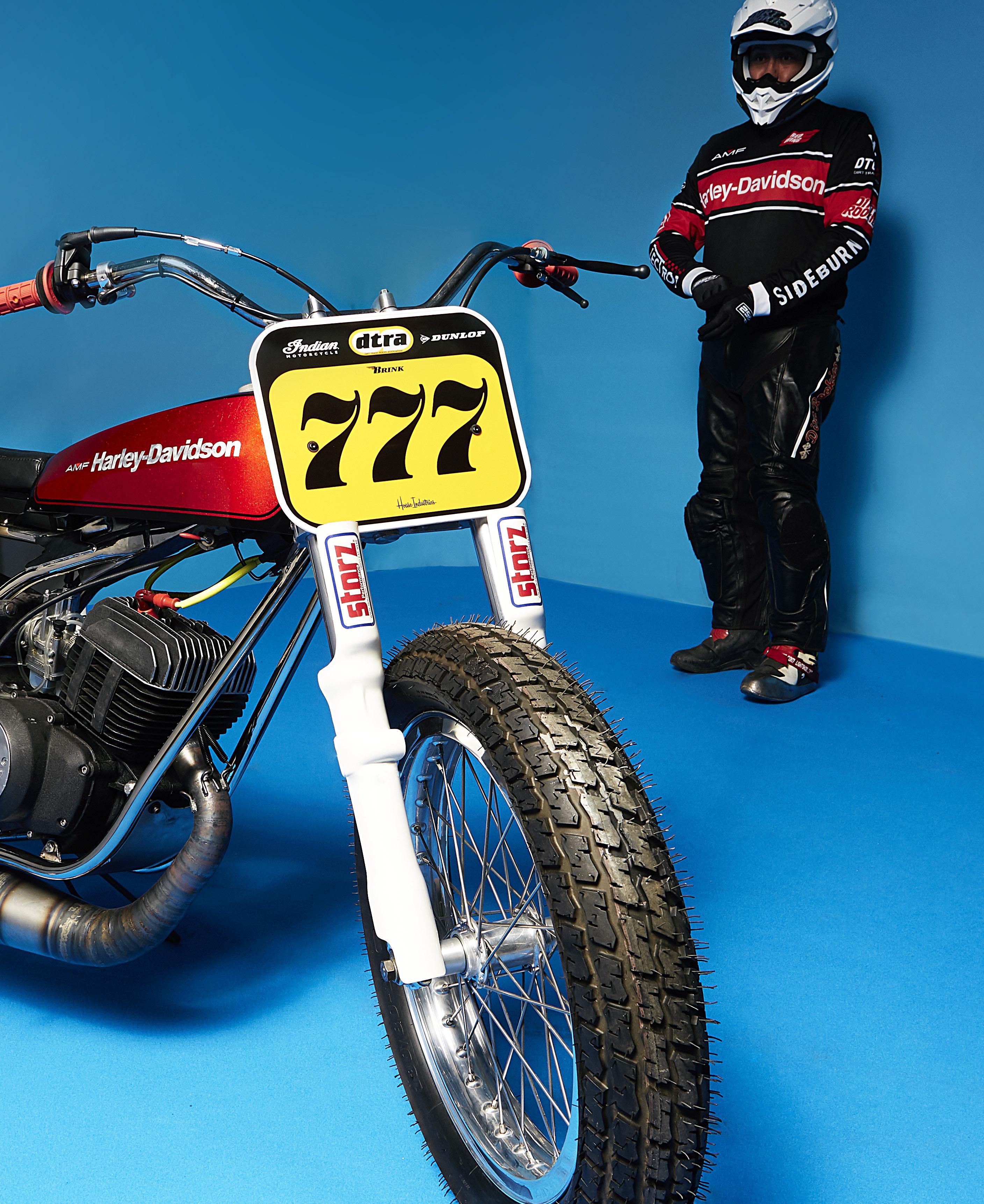
39 >
five or six bikes and done mods for clients, more as a hobby. Then when Wheels and Waves started we all went crazy and got motivated about rebuilding and modifying bikes. The next Wheels and Waves introduced the El Rollo flat track race and I got my first taste of the dirt oval. Then I went to the Noyes3 family flat track school with a group of friends and that was it, I was hooked.
I modified my Honda XL500S and was invited to join Dirt Rookies, a group of Spanish flat track riders on modified bikes. Then I built a Yamaha XS650 with a Co-Built frame. I’d fly to England and rent bikes to race. I bought a Sunday minibike too. Like I say, I was really bitten by the bug.

Now it was time to make all the leftover Harley SX-250 parts into a flat track project. I had a frame; two spare engine blocks; two sets of wheels… I got in touch with Brandon at Ancient Warriors4 who was selling some used flat track parts, and bought his Ceriani GP35 forks, A&A triple clamps and two hubs. I used the front hub on the Harley and the rear on my XS650. I sent the hubs to Jerry of Cheney Engineering in Iowa. He serviced them, supplied new, quick-release rear hub nuts with a 12in rear disc and a few rear sprockets. It was nice to discover that someone still knew the offsets and measurements of the original 250 Harleys. Jerry told me he had done quite a lot of Harley 250 modifications, even frames, back in the ’80s. The hubs were laced with new-old-stock 40-hole Akront/Morad alloy rims, then fitted with Dunlop DT3 tyres that I’d bought from the Cardus Brothers of Rocco’s Ranch, based in Barcelona.
Once all the parts were gathered, my friend Xarly at Vintage Addiction helped me get the frame ready for nickel plating. He’s built some outstanding flat track bikes in the
Appendix 3. Spanish-based American Kenny Noyes was instrumental in growing Spain’s
flat track scene and involved with Marc Marquez’s
Superprestigio, where Noyes was a podium finisher. He was also a Superbike
racer
and
was seriously injured in a testing crash in
2015. 4. Flat track Instagram feed: @ancientwarriors
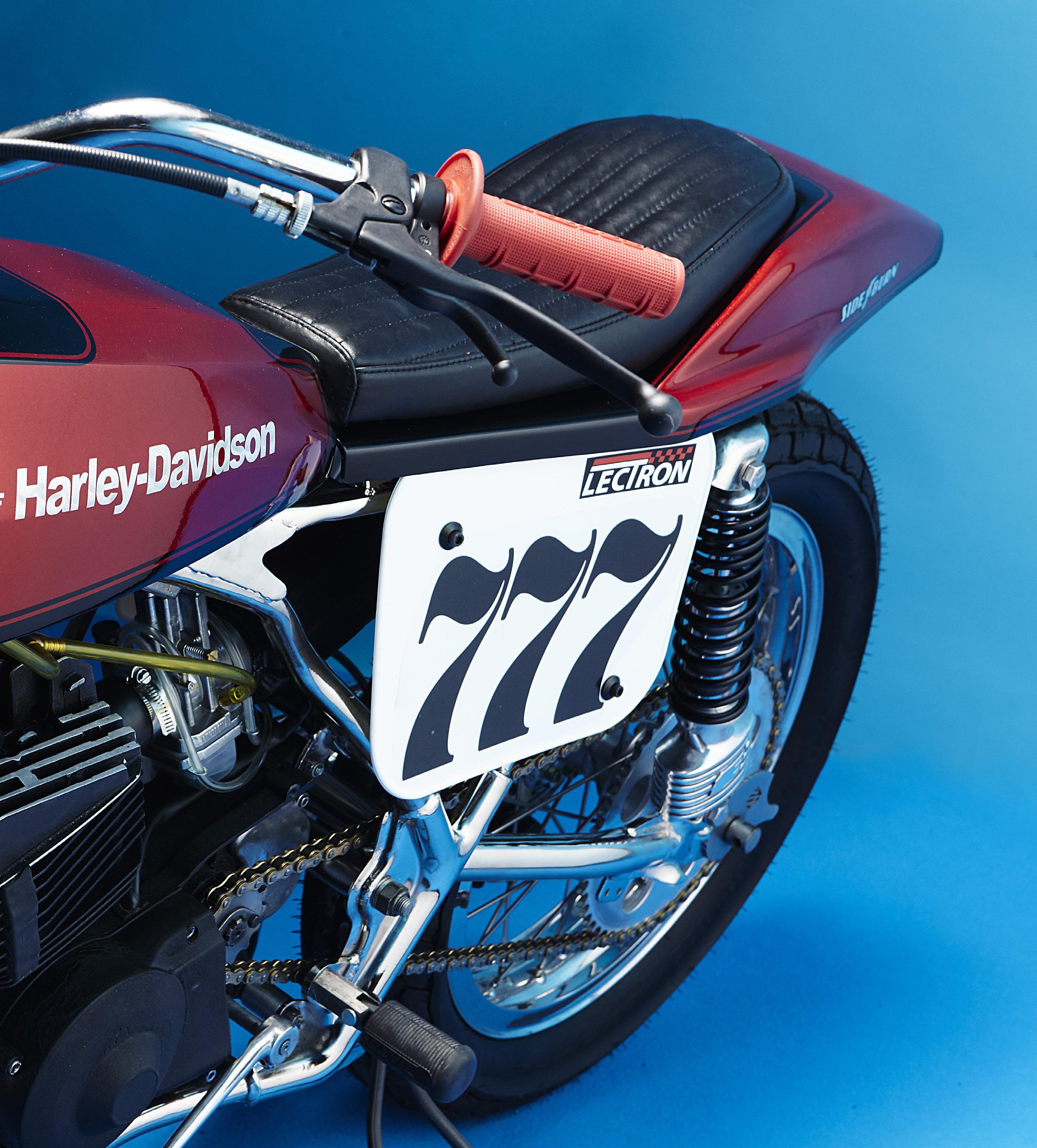
> >
(clockwise from above) Why the long face? Jonas designed the shoot to copy Harley ads of the 1970s, including moody blue steel expressions; Lectron carb and nickel plating; Period Red Wing shocks and modern Brembo caliper, yum yum

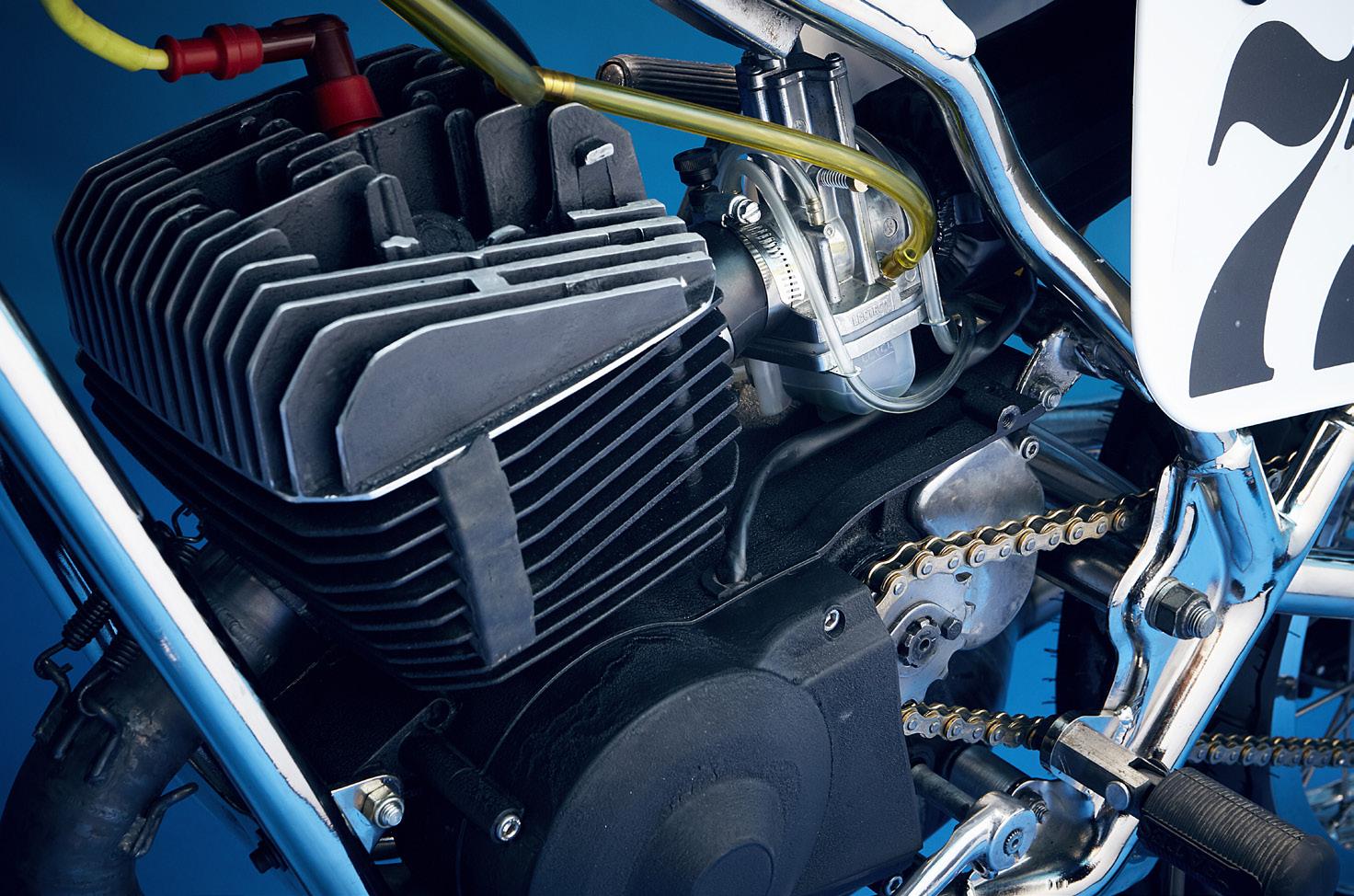
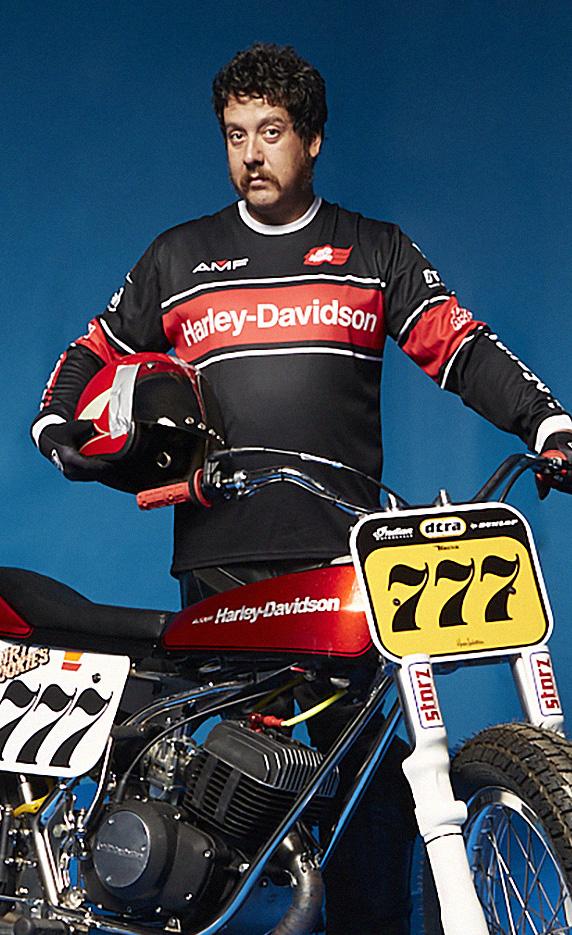


‘Aesthetically, I wanted to use the same Staracer seat and tank that they used on some versions of the Harley DT-250’
>
last few years. We cleaned the frame, welded new tabs for the number plates and exhaust, then rebuilt the engine – not once or twice, but four times – because I was still mixing original Italian Aermacchi parts with Cagiva ones I had5. Now the engine is 100% Harley-Davidson from 1975 and we managed to make a back-up engine with the Cagiva parts in it .
Xarly fine-tuned the engine and covered the crankshaft holes with nylon. We balanced all three crankshafts I had, polished the cylinders and installed a
decompressor in the second sparkplug hole. I discovered old racers are really good at answering questions that you post on forums and Facebook groups.
Aesthetically, I wanted to use the same Staracer seat and tank that they used on some versions of the H-D DT-2506 and, funnily enough, I had the tank of my XS650 that had started to rot from the inside from the effects of modern gasoline. I had seen Dimitri Coste would always drain his tank after a race, but I didn’t see why I should do it on mine. I’ve learned my lesson. The tank was
ruined, so we cut the bottom out of it to use as a cover for a new alloy tank that Xarly made. Kilian Ramirez did an amazing job with the paint, but I’ve already upset him because I really love stickers.
Now, thanks to Covid-19, before I return to England to race with the DTRA I have time to practise and get used to riding this 250 two-stroke with a decompressor that I can’t get on with yet. I also want a gear shifter on the right, like the factory bikes had.

It’s been a long journey, so I can wait a few months more.
drought
Appendix 5. In the 1960s, Harley bought into Aermacchi to fast track into road racing. In the 1970s, they were in a long
of short track wins, losing out to European and Japanese two-strokes, so they began using Aermacchi 250 two-strokes to compete in motocross and the AMA Grand National Championship, to score points at the short tracks. Cagiva bought Aermacchi from Harley in 1978. 6. Harley-badged 125, 175 and 250cc Aermacchis made up the the SX range and there were SST road versions. The motocross-spec bikes were MX-250, while the factory short track racers, ridden by Springsteen and Randy Goss among others, were given the DT prefix.
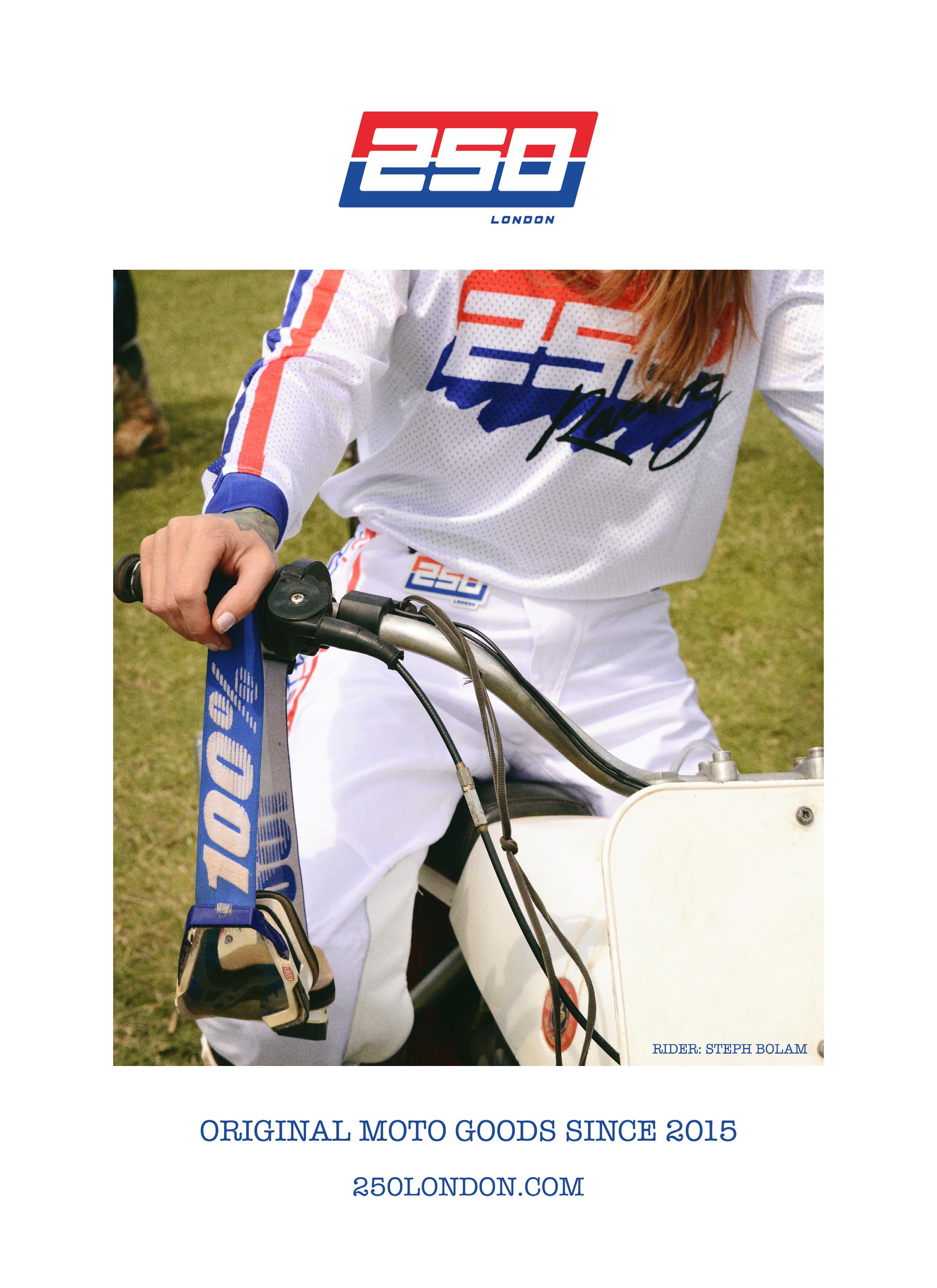
THE GOOD OLD DAYS ARE HERE AGAIN
Desert racing is a wildly enigmatic sport generally associated with the Fast, Rich or Dumb. You just gotta figure out which one you are. The endurance required is the long-format sort. It’s not the skills that win Supercross that gets one through the harsh terrain encountered in this kind of racing, it’s the thousands of micro-decisions that happen over hours and hours of riding that makes the difference. This sport was built on the backs of hearty individuals who did their best work hundreds of miles away from other humans. You’ve got to love it unconditionally, because it does not love you back. The desert can smell arrogance miles away and takes crafty pride in humbling the most talented riders, no matter their previous success or accomplishments in other arenas.
As tough as it may sound, the Biltwell 100 will be one of the easier races in the Southern California desert for 2021. Our goal is simple: make offroad racing fun again. Through the years, bigger, faster and better-funded teams tend to eclipse the underdog, blue-collar people who exist at the core of off-road racing. Those high-end teams can fight for television coverage and sponsorship contracts– we’ll help you out when you snap your chain in a sand wash, or have a beer with you around the campfire after the race. We’re here for the good times, not the lap times. Did we mention camping and spectating is totally free? Or that there’s a party and BBQ on Saturday night? Anyway, you are invited!

RIDGECREST, CA / APRIL 10-11 2021
information as things evolve:
More
www.biltwell100.com & @biltwell off-road race ridgecrest, cal. off-road race ridgecrest, cal. off-road race ridgecrest, cal. 2021 off-road race ridgecrest, cal.


MIGHTY MO R M I G H T Y M O S H O P . C O M We are MightyMo and so are you. Dedicated to the Greater Moto Good. MIGHTY MO R M I G H T Y M O S H O P . C O M We are MightyMo and so are you. Dedicated to the Greater Moto Good.
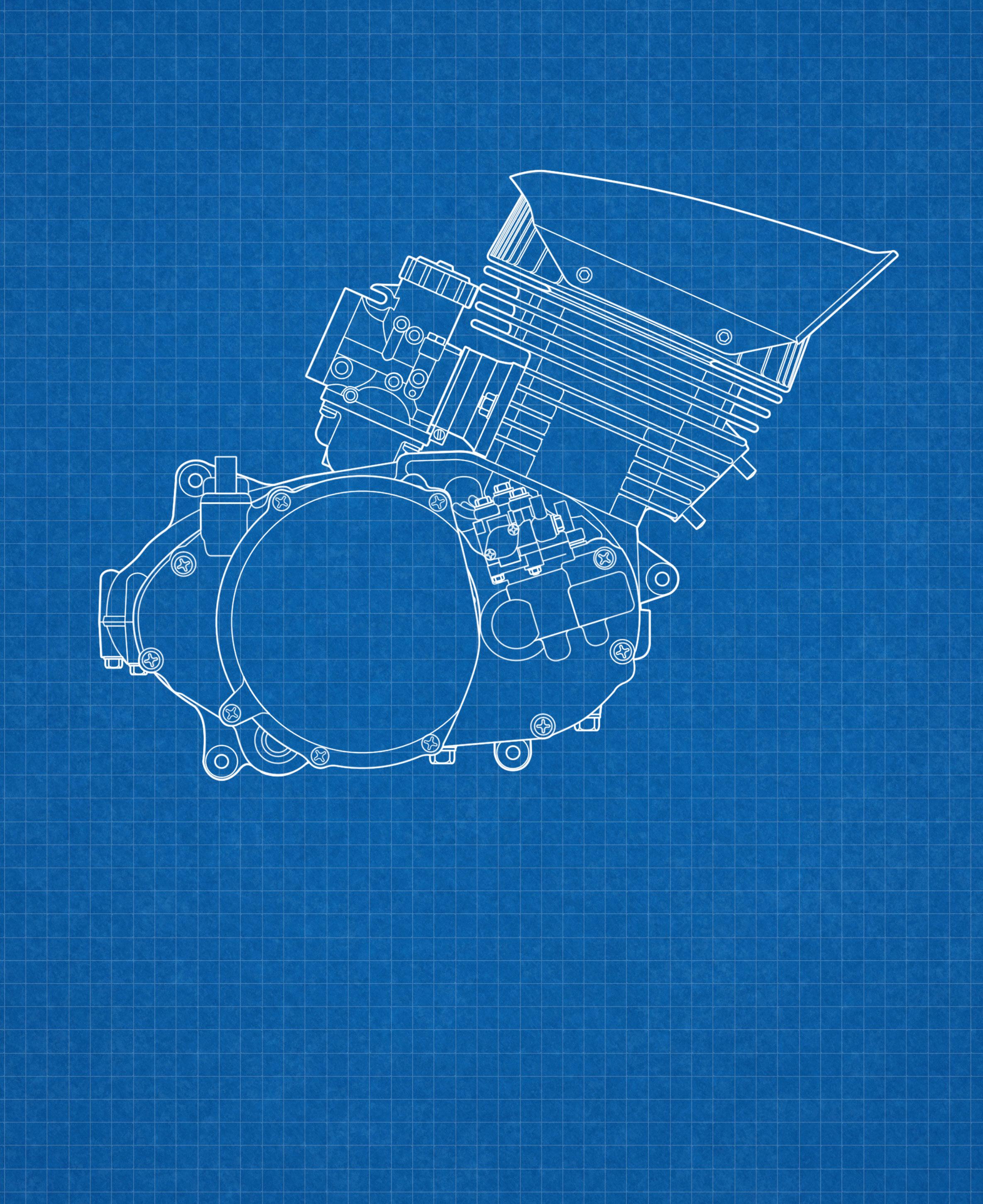
Words: Gary Inman Illustrations: Mick Ofield 49 > The ‘other’ 750cc multi-cylinder two-stroke that screamed in and rattled the the mid-’70s AMA flat track hegemony 1/3 ENGINE 750cc SIDEBURN #42 2020 CHAMPION KAWASAKI H2R

Kanemoto made the scoop for the head to help cool the middle cylinder, always the first to seize 2/3 SIDE ELEVATION 750cc SIDEBURN #42 2020 CHAMPION KAWASAKI H2R
THERE HASN’T BEEN much written about this bike, and a lot of what has been posted seems to be wrong. That’s the opinion of the rider who won on it, Scott Brelsford. For a handful of races over two seasons, Japanese 750cc twostroke framers shook pro flat track till its teeth came loose. Kenny Roberts’ win at the Indy Mile on the yellow and black Champion-framed Yamaha TZ700 was an emphatic exclamation mark that ended the era of the big strokers when it had barely started. The establishment, those with a vested interest in American and British bikes, banned two-strokes from dirt track competition with, looking back, few very good reasons.
‘Kenny sided with [Harley], saying, “They don’t pay me enough to ride this thing,” like he was Superman,’ says Brelsford. ‘But there were other guys who could ride them if they had them, but only a few guys did, and they didn’t have the set-up or special tyres that Kenny had.’ What gives Brelsford the confidence to offer this iconoclastic opinion? By the time of Roberts’ now-famous quote, Scott had already won a big mile race on a 750 two-stroke at Stockton, Ca. Plus he was in the same Indianapolis race as Roberts. ‘I was on the front row, I’d won the heat race, I thought I was going to win that thing, but I blew up the first lap. Then Kenny wins it from the last row.’
The Stockton Mile that Brelsford won wasn’t a national, it was a regional championship race. ‘That’s why people didn’t know I’d won a mile race on the Kawasaki before Kenny Roberts won Indianapolis,’ says the younger brother of Mark Brelsford, the 1972 Grand National champion. Still, that Stockton race was

>
packed with talent and former champs. ‘Dave Aldana, Mert Lawwill, Rex Beauchamp, Gene Romero, a lot of the top guys. Kenny Roberts wasn’t there, he was testing the road racer in Ontario, I think. But I won the race in his hometown.’
Brelsford had raced smaller Champion-framed twostrokes as a Novice, so he got along well with the Doug Schwerma-built chassis that tuner Erv Kanemoto1 built his Kawasaki flat tracker around. ‘I was familiar with the geometry, it was pretty much the same. [Champion Yamaha 250s] were pretty easy to ride, and the Kawasaki was similar, just with a bigger engine. It didn’t get the traction I would have liked, but it was ridable.’
The Californian was 1973 AMA Rookie of the Year, but had fallen out with Harley and their racing director, Dick O’Brien, over a fateful trip to New Zealand to race factory Harleys without O’Brien’s permission 2 . With few options left to him, Brelsford agreed to race the Kawasaki.
‘When I was on the Kawasaki, I planned to get vengeance on the Harleys. I was committed, I hung it out, but the thing just kept blowing up.’
The engines were ex-Gary Nixon H2R road race triples, says Brelsford. ‘Gary Nixon rode the [dirt track] bike before I did. He rode it at San Jose, but he didn’t make the programme 3. He was afraid to shift
championships] but they were planning to get the water-cooled Kawasaki, the KR750, and that’s what I wanted for the road races the next year.’
While things didn’t pan out, Nixon and Kanemoto moving to Suzuki, Brelsford claims the honour of being the first two-stroke to make a mile national main event, when he qualified through the semi for Golden Gate Fields, Albany, California.
‘I could’ve won the race, the first I rode on it, if I didn’t suck sand through the carburettors. It was my fault. We had to have nine filters [for the day] and I put three on that hadn’t been prepped right.’ The win at Stockton, in the regional race, came shortly after.
‘The tyres, back in 1975, weren’t great. Dunlop didn’t have the big new tyre they came out with for 1976, that was quite a bit wider and deeper cut, but Erv found a 4.50 Carlisle tyre for Stockton. I didn’t even know they had a 19in Carlisle that big, so that might have helped me get in the winner’s circle. The front tyre was a Pirelli, they worked really good. Stockton was a sandy surface, not that deep, but I had to try to keep the bike as up and down as possible, I couldn’t really lay it over. I wanted to keep as much tyre on the track as possible.
‘After I won the Stockton race, Erv hired Don Castro, who had ridden for him back in the ’60s as a novice. I didn’t like the idea I was going to have a teammate after I just won a race, but Erv didn’t know where I was at. I figured I could out-ride anybody on that thing. I don’t think Castro ever made the programme in five attempts, but those things weren’t easy to ride.’
After Roberts won the national at Indy, the AMA’s competition committee moved to neutralise the twostroke threat, and it came as a shock to Brelsford.
it and you had to shift to make them work, you had to use that five-speed and downshift for the corner. He’d broken his leg real bad on a three-cylinder Triumph in 1969, by missing a shift [at Santa Rosa], and it pretty much ruined his dirt track career.’
Being young, skilled and driven to beat the factories meant Brelsford was ideal for the Kawasaki, but, he remembers, ‘Everybody was scared of the thing. It was pretty scary to ride a [two-stroke] on a mile or a half-mile. I never got to ride a half-mile because Erv didn’t have time to get the thing ready. We didn’t have the money to develop it or test it.’
Brelsford had his eyes on a Japanese 750 for the road races that made up the Grand National Championship at the time 4 . ‘Erv was working with Nixon [the pair had won the 1973 road race
‘All the old-timers were afraid to even think about riding one of them. They didn’t want their stuff to become obsolete. They were trying to protect their legacies. The guys on the competition committee who chose to ban them were all protecting their own deal. [The two-strokes] had so much potential. Soon there wouldn’t have been any four-strokes in the main event. The young guys coming up were used to riding two-strokes as Novices. My brother, and all the guys before him, had [grown up] riding Harley-Davidson Sprints on short tracks. I was pretty much ruined. I really didn’t think they’d do it.’
Instead, the Champion Kawasaki H2R has become an almost mythical oddity, a flash in the pan never given a chance to at least try to fulfil its potential. The last word on it has to go to Scott Brelsford. ‘It was fun to ride the thing, but it was a challenge.’
the 250 and 500 Rothmans Hondas. The list of racers
races, where he’d be given good start
worked with

Rayborn died after crashing a borrowed
famous Harley racer
and heat races to the semis and main event, the day’s final
the Grand National Championship on dirt tracks and road
‘All the old-timers were afraid to even think about riding one of them. They didn’t want their stuff to become obsolete’
Appendix 1. Kanemoto is most famous for masterminding Freddie Spencer’s GP championship titles on
he’s
is a who’s who. 2. Brelsford shipped a Harley race bike to New Zealand to compete in
money just for turning up. At one of the races, in December 1973 at Pukekohe, the
Cal
race bike. 3. ‘Making the programme’ is flat track jargon for progressing from qualifying
race. 4. Through the 1970s and into the ’80s, riders earned points towards
races. Specialists could score well, but all-rounders had a much better chance.
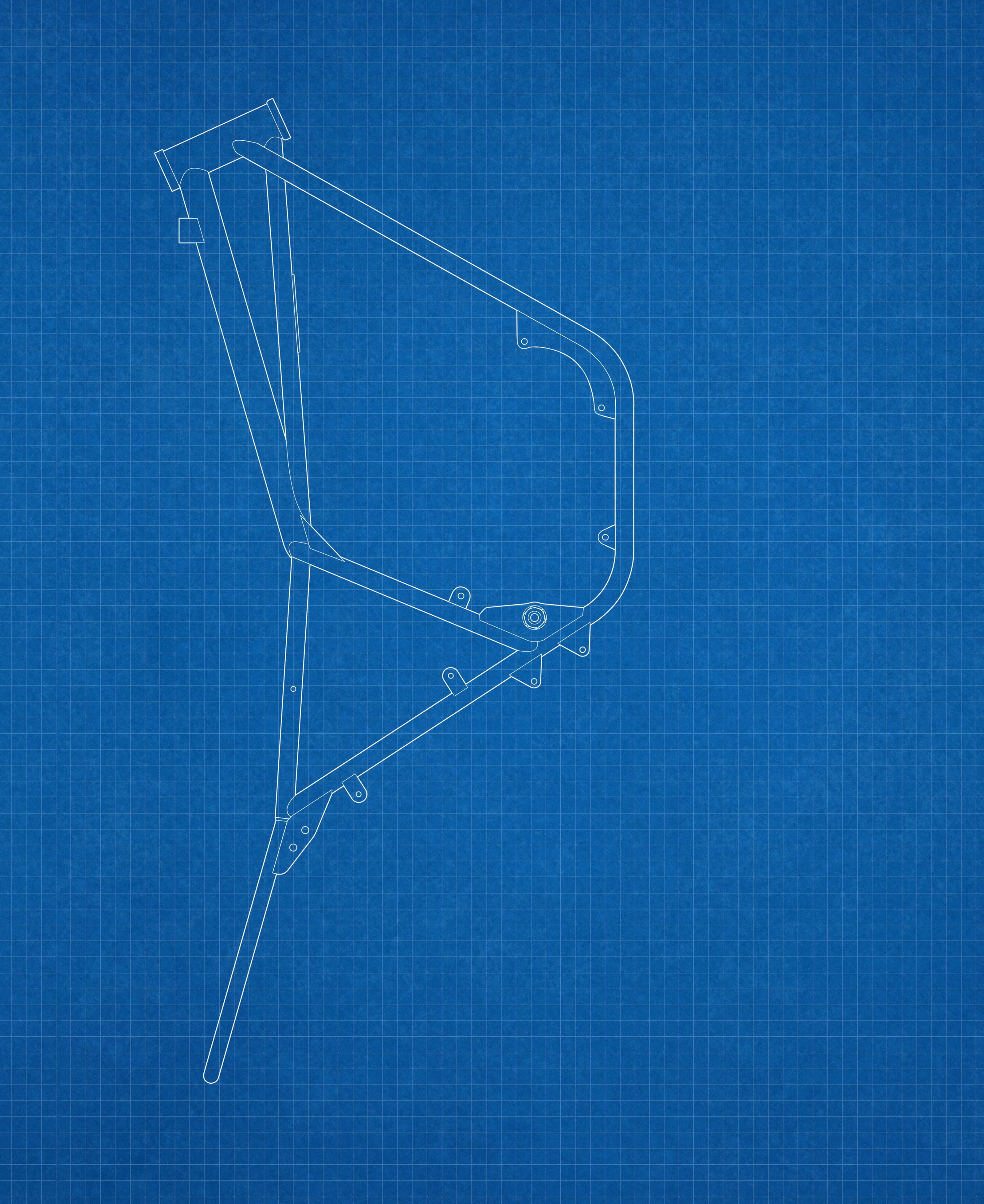
www.facebook.com/roadracemotorcyclesSimple but effective doublecradle frame by Doug ‘Champion’ Schwerma 3/3 FRAME N/A SIDEBURN #42 2020 CHAMPION KAWASAKI H2R
Brelsford already in the tuck off the turn in a battle with the Shell Racing Yamaha XS650 of Hank Scott
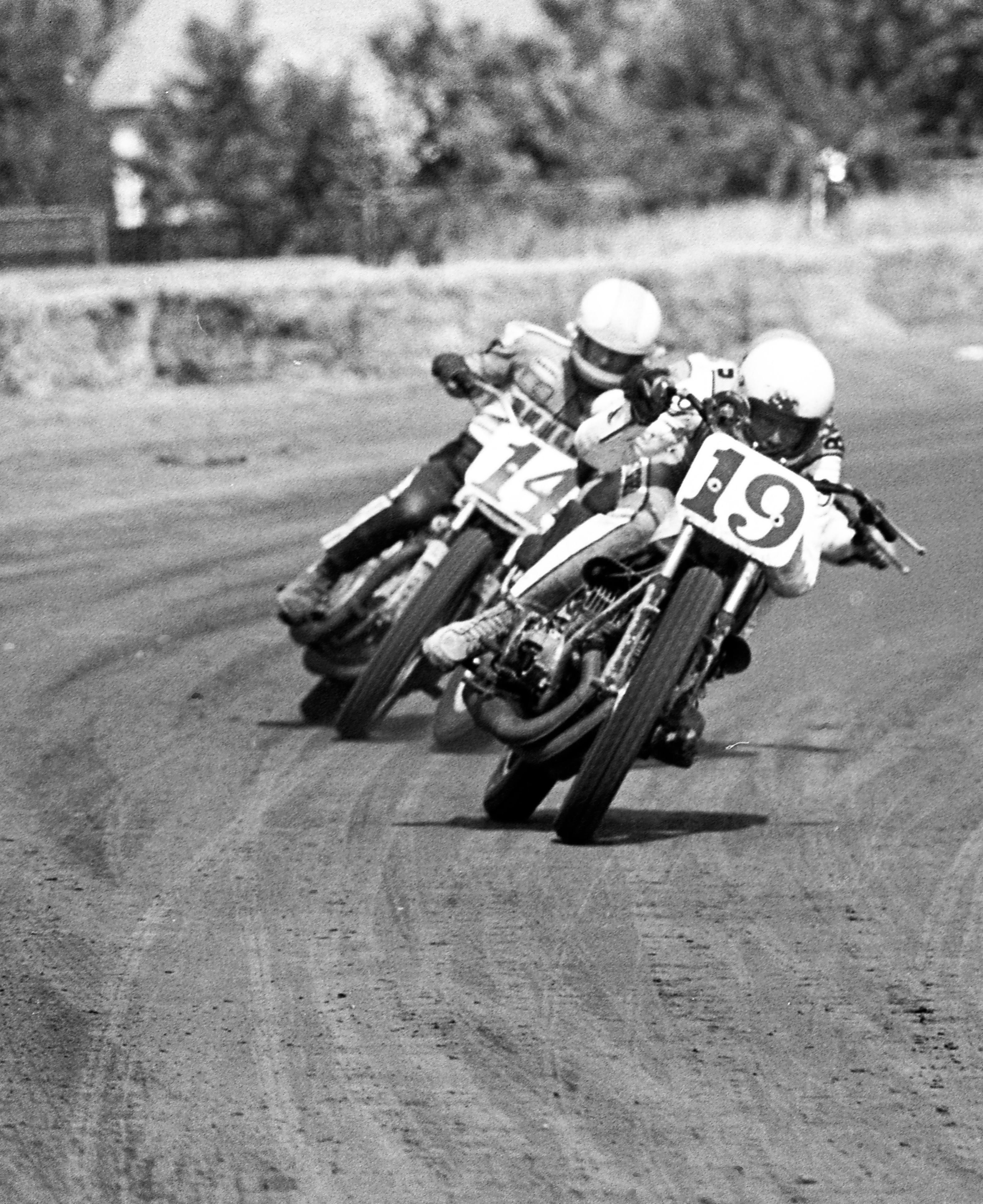
‘135, 137mph, in fifth gear, and the thing was still pulling pretty good’
Scott Brelsford gives us a seat-of-the-pants recollection of racing the Kawasaki 750 triple Words: Gary Inman Photo: Gary Van Voorhis

‘You couldn’t gear the Kawasaki to run in one gear [like you would with a four-stroke]. You needed the lower gear to come off the corner, because the Kawasaki didn’t have the torque of the XR750s.’
The bike had very similar horsepower to an XR, says Brelsford, about 90bhp in 1975, but the Kawasaki was much lighter at 290lb (130kg) according to some sources, compared to around 310lb (141kg) for an XR.
‘I had to be straight up and down when I changed gear, I didn’t want to shift when I was leaned over. And you didn’t want to make a mistake downshifting or you’re
dead. In a 25-lap mile race you’ve got 100 shifts to make. I was shifting not quite halfway down the straightaway. After getting off the corner about the same as the Harleys, I could pass them around the start-finish line, but then the corner comes up and I really had to drive it into the corner hard to make the most of the advantage of the top speed. The corner wasn’t a problem, because I felt real safe on it.’
And what was that top speed? ‘I think I was doing 135, 137mph, in fifth gear, and the thing was still pulling pretty good.’
55
Leather Queen Dee Johnson of D’s Leathers made a race suit for her husband and didn’t stop making dirt track leathers for nearly 50 years
FLAT TRACK LEATHERS have always been an important part of the sport’s draw for me.
Two-piece, zip-together, straight-leg-overthe-boot, those huge numbers on the back...
At the time I got seriously into flat track, all that made them so different to what was being worn in World Superbike and MotoGP. Plus, they were made to last, so sturdy they could stand up by themselves. Since the dawn of the AFT era, European brands, specifically Dainese and Alpinestars, have moved into flat track and now outfit the majority of the pros. Before that, and dating back to the 1960s, the vast majority of pro racers’ leathers were handmade in the USA by Vanson, Bates, ABC, NJK and, of course, D’s. Now, leathers are thin, made to be light and flexible, with inbuilt air bag systems. They’re made to protect, of course, but not necessarily to survive multiple, or even one, highspeed crashes. D’s Leathers were trusted by the stars, and were paid for, not given by the manufacturer as part of a sponsorship package.
We tracked down the now-retired Dee Johnson, who has made some of the greatest leathers for the greatest riders, and also helped run her family-owned race team.
How did you start out in business?
I started the leather business because my husband, Larry, wanted to go flat track racing and he needed a leather suit. We had three kids and money was tight,
but because I made all the clothes they wore I told him I would give it a try. I called every pattern company in the US and no one could make me a pattern for the race suit so I set out to make my own. That project took me about a month, using cloth material as a pattern, trying it on my husband when he came home from work, then altering it to make it fit. It finally did! Then I needed a machine. My friend had one and loaned me it, but of course it didn’t work, so I had to get parts and fix it. I ordered leather from a place called Tandy Leather, and the sewing began. Larry wore the suit (which I still have) to the races and the orders started to pour in. I had no idea it would turn into a job, but it did, and it has given me a very happy life. I got to stay home and sew from my basement and raise my kids.
How long were D’s Leathers in operation?
I was in business for nearly 50 years and I would make at least 100 suits a year. I had to quit making suits last year [2019] due to an eye condition. I tried continuing after a year of surgeries, and made a couple of pairs of pants for Scott Parker and an easy drag racer suit, then came the suit with four quarter-inch stripes and a quarter-inch separation. It was a struggle to finish it, taking me two weeks when it would normally have taken two days. That made my decision to retire. It was hard for me to quit the job I loved so much. I had planned on working to noon on the day of my funeral.
 Words: Gary Inman Photos: Shogo Nakao (opposite); Flat Trak Fotos (all others)
Words: Gary Inman Photos: Shogo Nakao (opposite); Flat Trak Fotos (all others)
Dee Johnson, as resilient as the suits she’s famed for. It took an eye condition to force her to finally quit

57 >
Why concentrate on leathers for dirt track racers?
In the early days I made road race and drag race suits too, but got so busy with the dirt stuff I had to make a decision. It was easy, as dirt track was, and still is, my favourite type of racing.
To start my business I needed money, so my husband sold his boat, as he had quit racing because we didn’t have the money to buy a 750 bike and he had made Junior status. So, with the first money I made I surprised him with an XR750 race bike that I bought over the phone from a guy in Indiana. Larry was helping kids build bikes at the time and what a thrill it was for him and the kid that he was helping, named Randy Raker. Over the years we had lots of kids ride for us. We had two Harleys, so we always had a Junior kid and an Expert. I would sell Pirelli tyres to make gas money, so we didn’t have to take prize money from our riders.
It seems like the custom leathers business would be very focused on the off-season.
I was always booked for the season by January or early February, non-stop sewing till late in the night. I am proud to say I never let a customer down. When I told him he would have his suit by a certain date, no matter if I didn’t sleep, he got his suit. I knew what work I could accept, sometimes underestimating the time it would take me to make the suit. I never missed a race, but I did miss a lot of sleep.
I was blessed to have a friend that could sew to do all my repair work till he had to retire and that’s when my daughter, Debbie, took over and she has done my repairs for 20 some years now, and has made a name for herself in the business.
How many employees did you have?
In the beginning I did it all myself, then it got out of hand and a friend of mine offered to help, which she did for about ten years, but was forced to retire because of illness. That’s when my daughter, Vicky, who is married to Randy Goss, stepped in. What a dream come true she was – and still is. She loved racing too, so it was a labour of love for her like it was for me. She had a natural knack, and she cut out all my letters and logos till the day I retired.
Who was your favourite customer or racer?

Now that’s a question too hard to answer. I loved all my customers and knew them all personally from going to the races and sponsoring a team. To mention a few: Scott Parker. I was the only one who ever made his suits, except for the one plastic suit his mom made for him when he was about eight. Joe Kopp is special, he lived with us during race season for about five years until he got married. I was so proud to be asked to make his son, Kody, a suit when he started racing a few years ago. Then there’s Randy Goss, who is my son-in-law, so I can’t leave him out. Kenny Coolbeth. As with Scotty, I was the
‘my daughter, Vicky, who is married to Randy Goss, stepped in.
What a dream come true’

> >
(clockwise from top left) George ‘Geo’ Roeder and Dee in 2005; Check out Geo Roeder at Lima, 1995; Another of the Roeders, Will, road racing an XR1000 at Daytona, 1985; Kevin Atherton and Dan Butler in mid’90s high fashion; Scott Parker in one of the dozens of D’s suits he had; Kenny Coolbeth, one of a long line of Harley champs who trusted D’s leathers
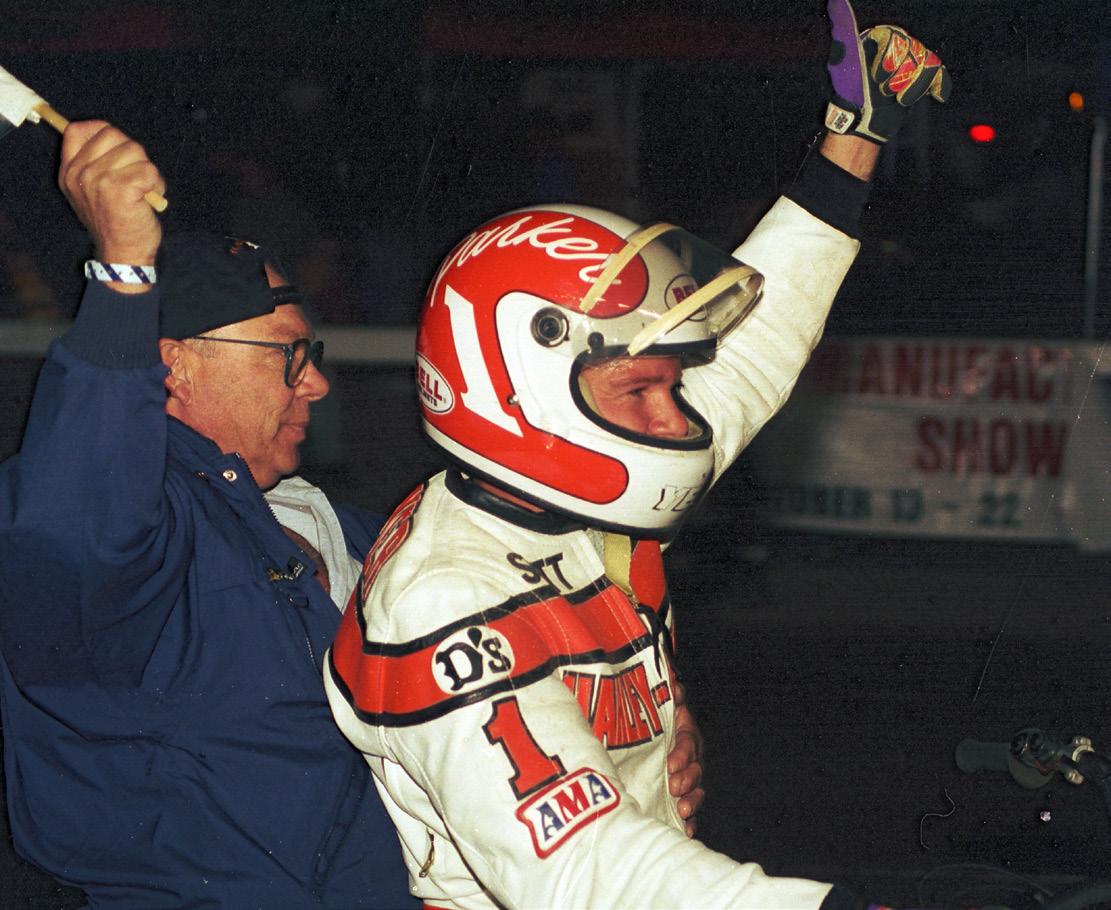


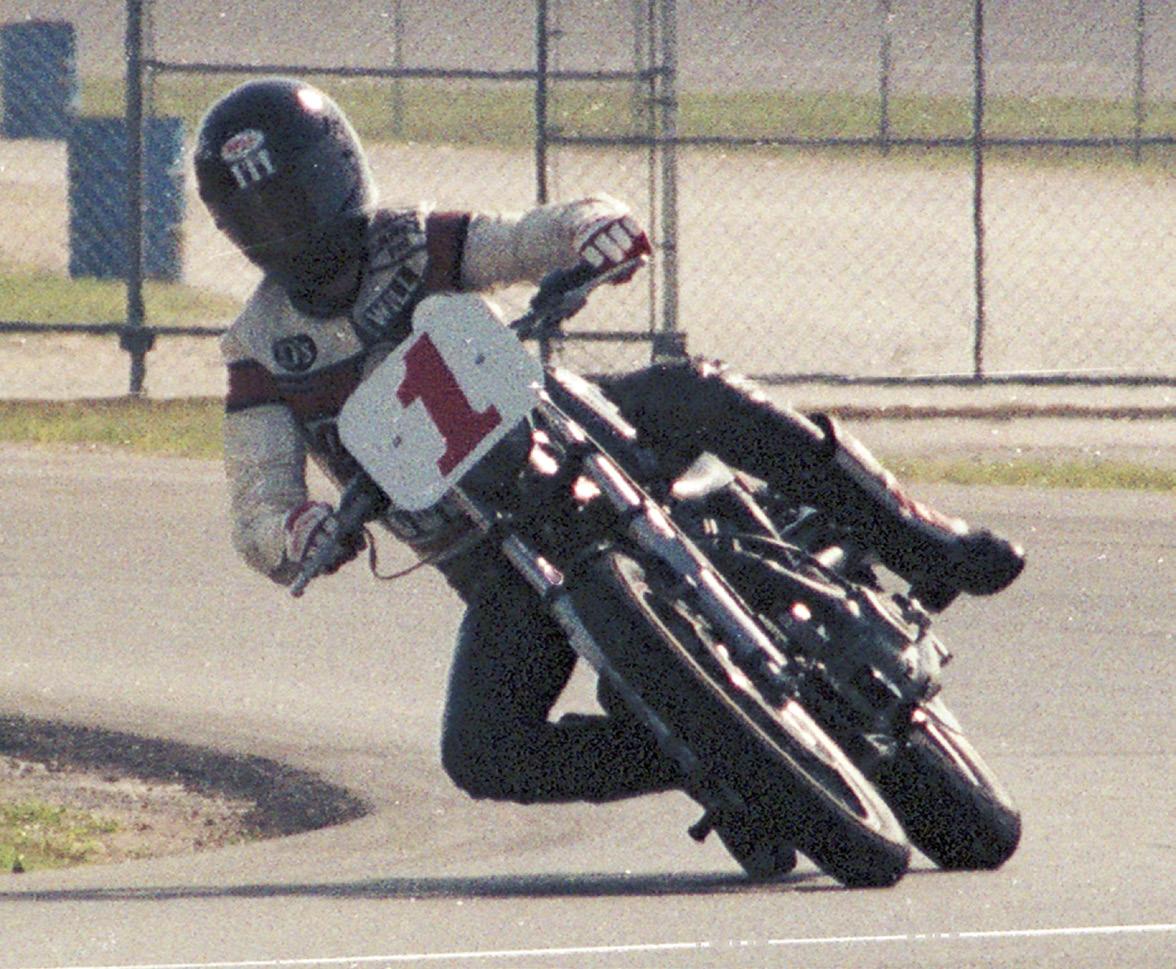
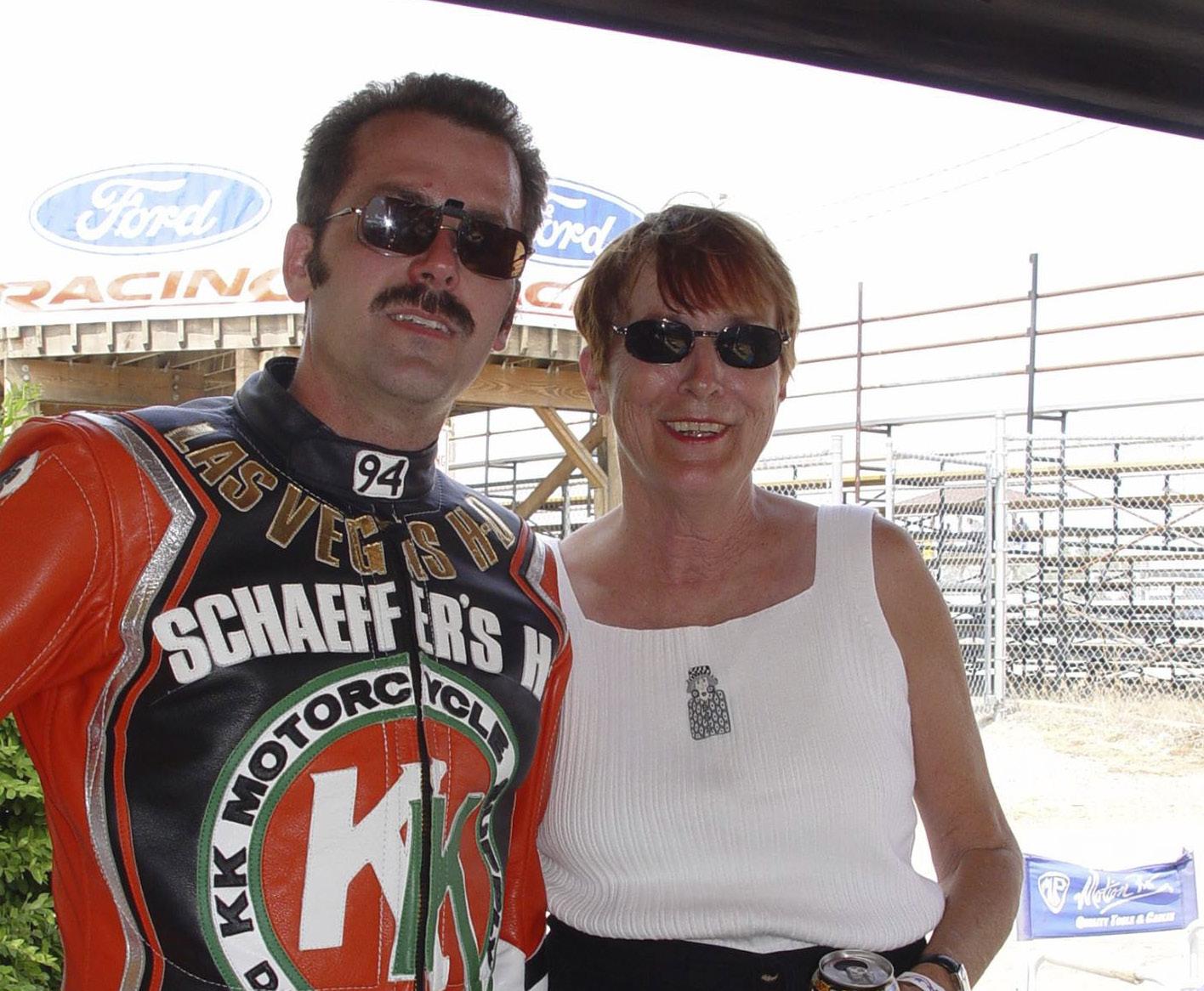
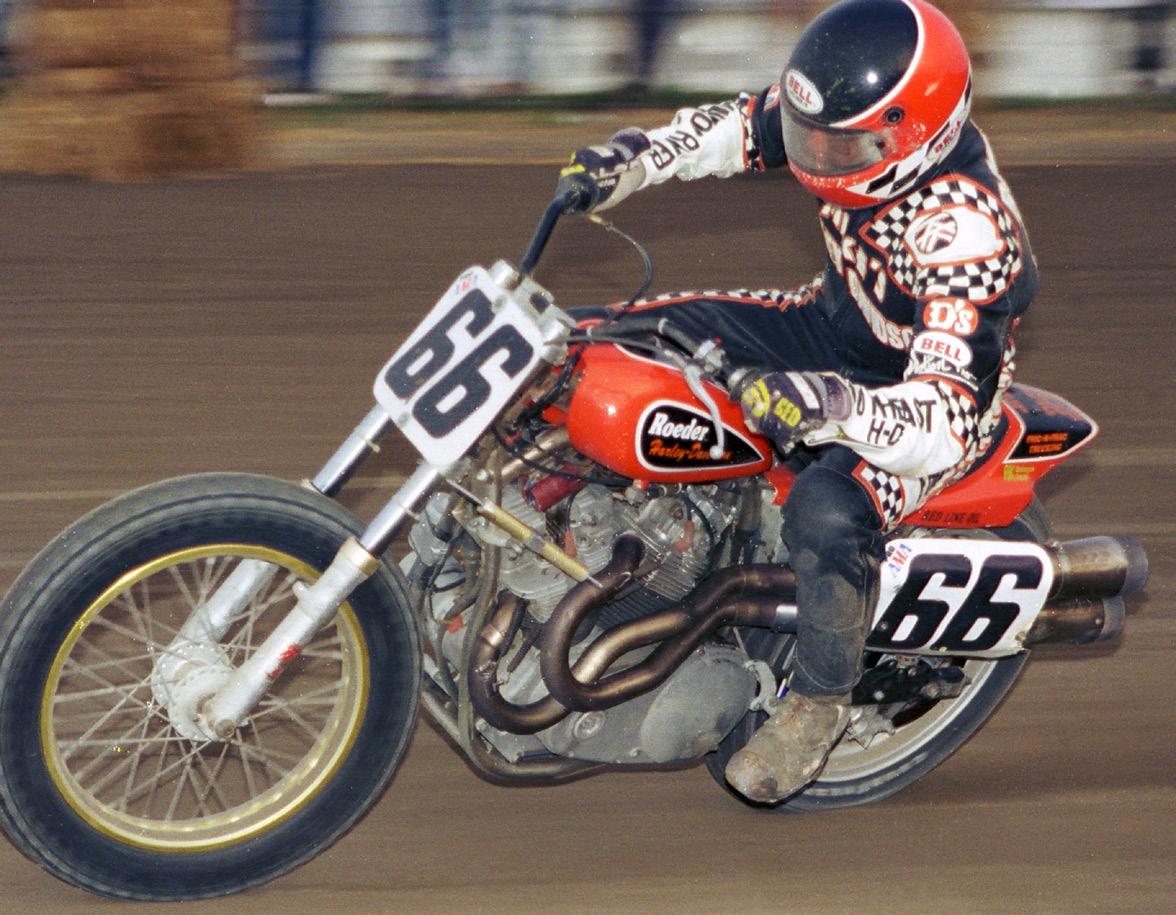
(clockwise from left) Steve Morehead in 1998. Now race fans can see him mopedmounted as AFT’s Track Director; Randy Goss in classic H-D colours; Joe and Garrett Kopp; How many champions have worn D’s Leathers?; Eric Rausch styling it out on Daytona’s short track in 1988


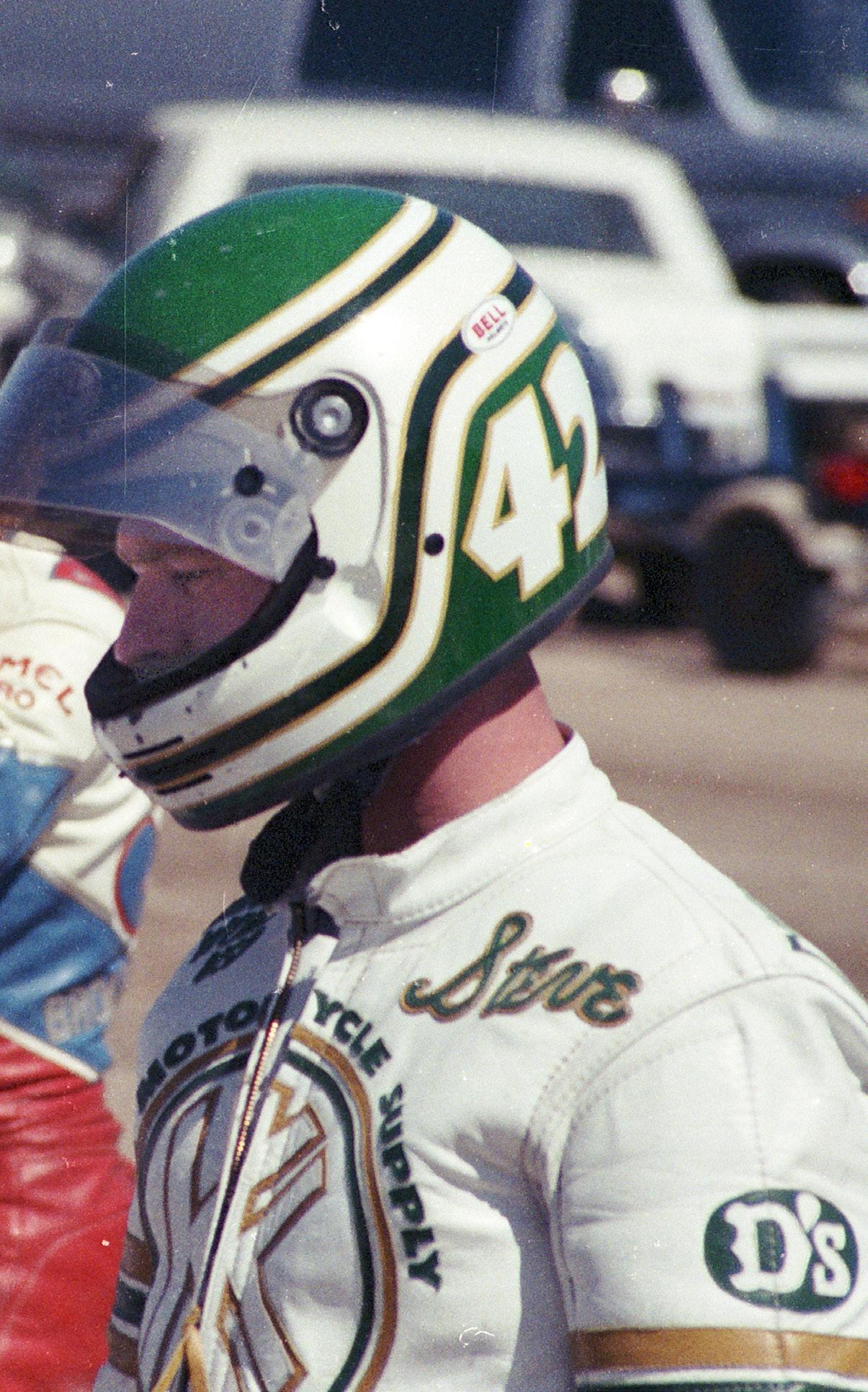

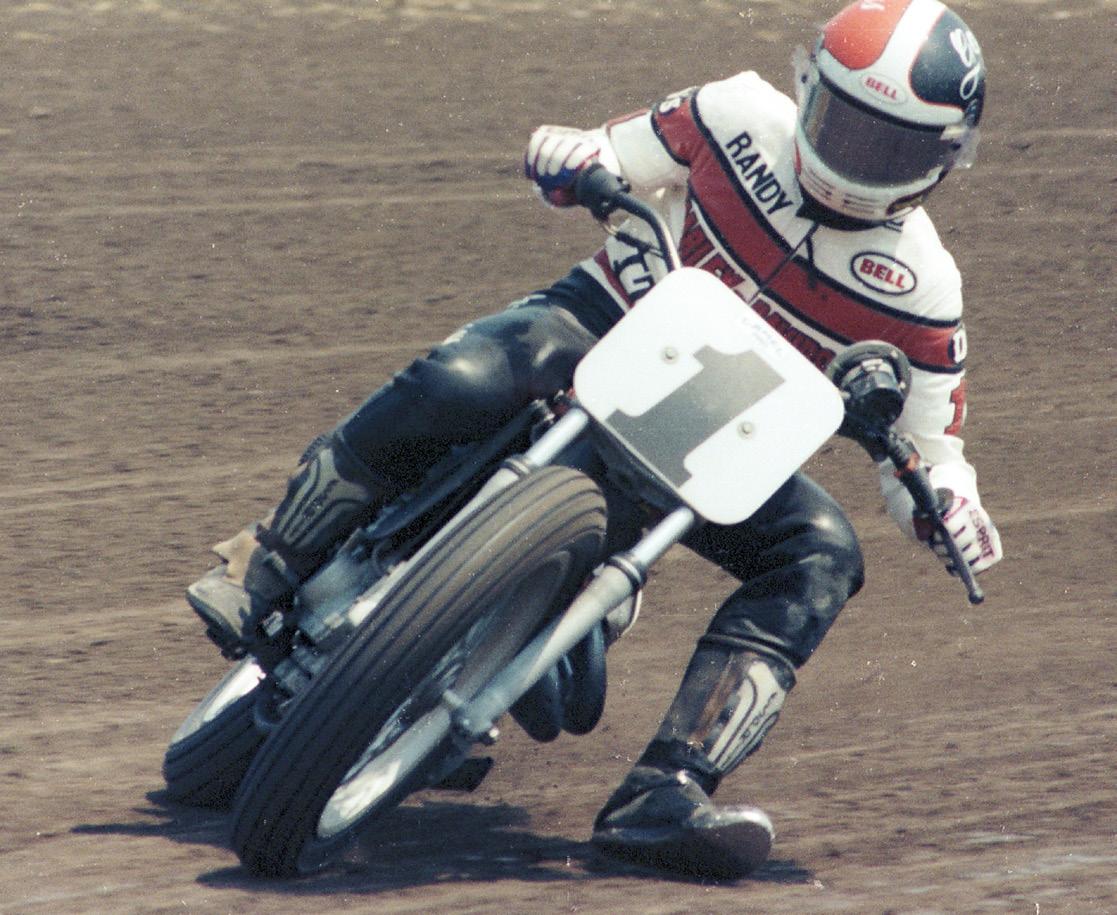
It’s 1990, Sturgis. You’ve got a hot Rotax, neat leathers and shades on. Time to haul ass

only person to make Kenny’s suits. Ricky Graham was a great friend and I was proud to have worked for him. Corky Keener was my third customer, and he gave me my company name. He said, ‘There was ABC Leathers and now there’s D.’ He even drew me my first logo. He wore the suit I made him to Houston Astrodome races for the first time [in the mid-1970s]. At that race, I presented Dick O’Brien (H-D factory team manager) the bill for the suit, he asked where the rest of the bill was and I told him that was the total bill. From then on, till Vance & Hines took over the flat track programme three years ago, I made all their racing suits.
I can’t leave out Bart Markel and Neil Keen. They were the ones who introduced me to Wanda Pico, who had made leathers in California, but was retired. She had been looking for six or seven years to give the business to someone and I was the lucky one to be picked. She gave me her pattern, which was better than mine, and all her connections of where to buy supplies. Remember, this was way before the time of the internet. She even gave me the sewing machine that I still sew on and made everyone’s suits on. I was forever grateful to her and her husband, Ernie.
And I can’t forget to mention one of my all-time favourites, Steve Morehead. He rode for our team for most of seven years. He’s a great guy and still a wonderful friend.
Are there any designs that stick in your mind as being your favourites?
Oh, another hard one. I always hated to make the same thing twice, so when I worked on the Harley suits I would make one, then do another racer’s suit, then go back to the next Harley suit. The year before he retired, I had to make about 12 suits for Scott Parker, so I made them all different and he let me have freewheel, which was fun.
Another memorable suit was for the KTM factory riders, Coolbeth and Kopp. KTM sent me a design and it was terrible, with everything on it but the kitchen sink: checks, flames, stripes... I didn’t want to do it, so I called the team manager and had a discussion. He was hard on me and was sticking to his guns, so I made him a proposition that I would design the suit and make it and if he didn’t like it, he didn’t have to pay for it. I had never made an offer like that before, but knowing Kenny and Joe, I knew they wouldn’t want the design KTM had sent me to do. Eventually, the manager accepted. The kids went to Daytona with my new suits and that week Cycle News came out and they were in the paper with lots of photos. That’s when the team manager called me, said I did a good job and that the cheque was in the mail.
How do you feel when you see racers still competing in leathers you made years or even decades ago?
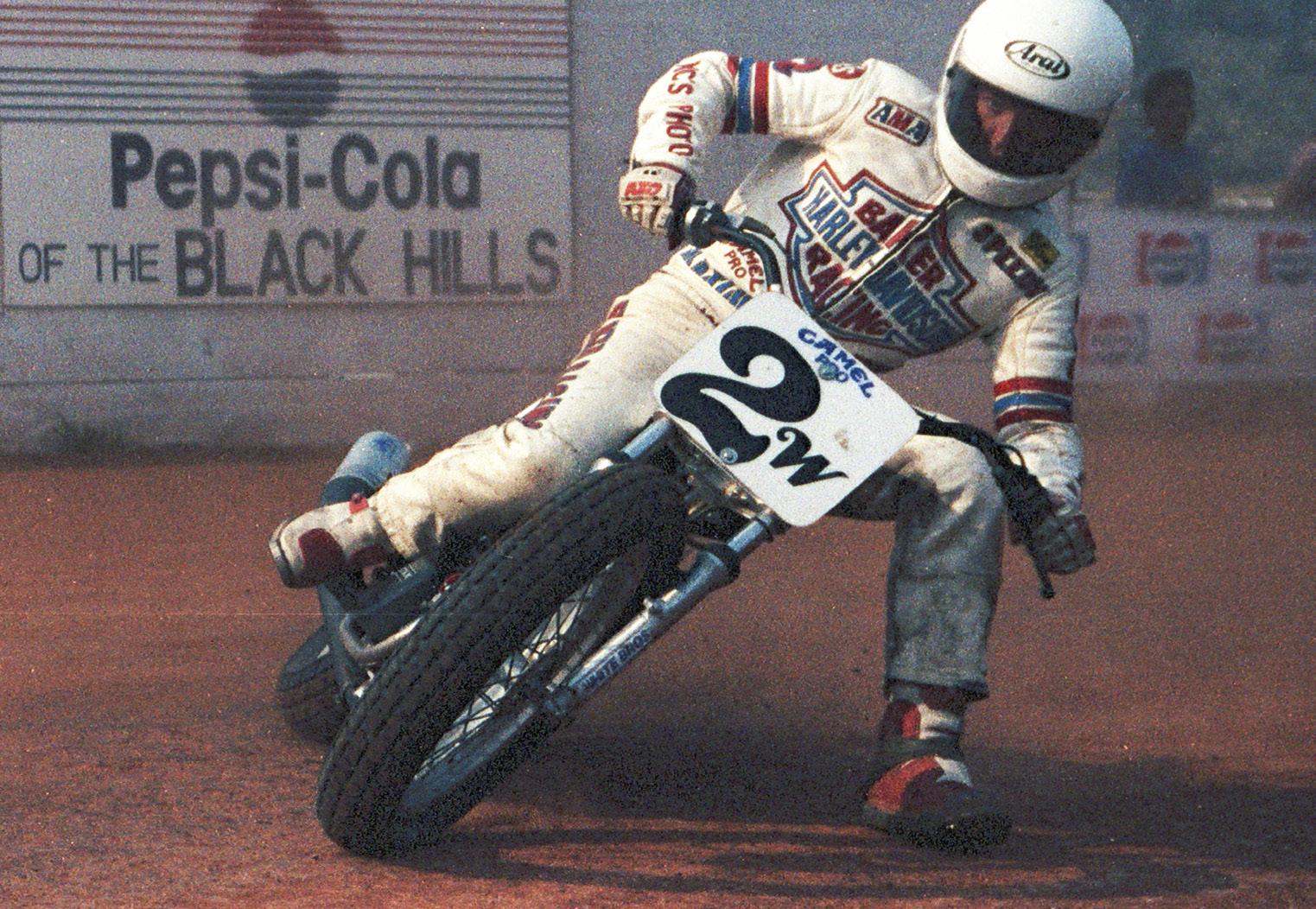
Very proud of my product. I tried to give the kids the best I could and I think I must have succeeded as they’re still around after all these years. My daughter gets 15- to 20-year-old suits in from racers who have decided to go Vintage racing, but for some reason their leathers don’t quite fit around the waist anymore. She enlarges them, has them put oil on them and makes them like new again.
What do you miss about running your business?
There was never a day I didn’t love my job. Yes, it was tiring at times, but always fun to please my customers and they always appreciated what I did. I don’t go to the races every week like we used to, but I still keep in touch with my customers. Like I said, there was never a thought of retiring, but when my eye failed I had to quit. Now I spend my time sewing costumes, you can make a mistake on fabric, but there is no forgiving a mistake on leather.


Motorcyclessaved
Words: A Dirt Track Racer Illustration: Nick Simich
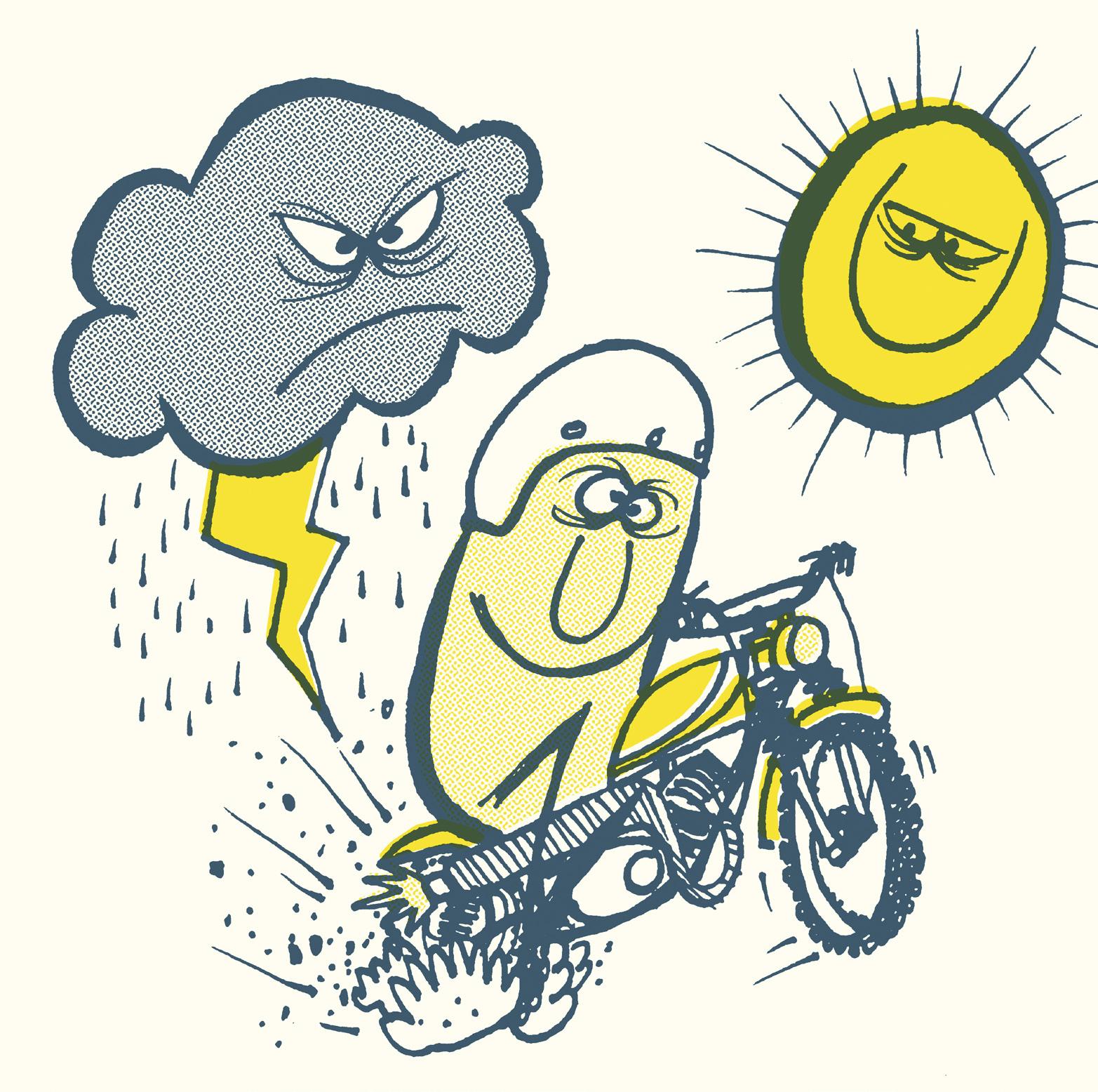
IT’S MORNING. THOSE precious couple of seconds between my mind fully waking and reality hitting pass all too quickly. During that brief window, I feel alive, invigorated and so positive, like anything is possible and life is as easy as it used to be. Then, like the vignette on some early photographs, it closes in and that’s it, until sleep again.
My life is by no means matched to the hardships that some people suffer. It could never be compared to those suffering severe illness or injury, experiencing poverty or war. However, it is the world in which I live, cannot escape... every single day. I’ve read comparisons to heavy weights bearing down upon people; dark clouds or fog; overwhelming oppression. It’s different for everyone, but the effects it has on dayto-day life are all absolutely real.
It’s only now, after some particularly difficult years, that I have pieced together and begun to understand what goes on in this mind, the one we try to protect with our wellused helmets.

As a child, I was well cared for and raised in a family with a lot of love, but also a lot of bullying, conflict and manipulation. The two halves could not be more opposite.
I was timid, chubby and terrible at ball sports due to lacking depth perception. This all went against me at school and the mental bullying and belittling continued relentlessly at home. Each day, all of the traits I hated about myself were continually reinforced, exacerbating my feelings of inadequacy and inferiority. On top of that, my childhood was made up of a series of false hopes. We would be tantalised by a holiday, day trip or being allowed family visiting, only for it to be withdrawn at literally the last minute, sometimes in the car about to set off. My whole world was so insular, with no overseas trips and very few away from the village I grew up in. I was taught that xenophobia, homophobia and racism were all traits that should be continued down the dark side of the bloodline, along with
mental/physical abuse. There was no reasoning other than it was what previous generations had championed, so it was clearly right.
All of this led me to cope by shutting out as many feelings as I could, no feelings equals no pain, right? Well, at least that’s how I thought it worked. When I was able to become independent, I entered a very physical, masculine industry, to prove to myself I wasn’t the weak embarrassment so often referred to. I threw myself into overseas volunteer work in difficult countries or provinces – small South American islands run by cartels being one that sticks out – again, to
We all feel good when we get on a bike, that’s why we do it. But for some, a motorcycle is a true life force
my life

prove I could. Each time I moved somewhere new, took up a new hobby, started a new job, it was always something daunting and scary, something that made me toughen up and stay that way. This was my Forrest Gump period. I had some incredible experiences, alongside those that were not so good, but none that I would change.
In an effort to protect myself, I had successfully blocked out so many negative feelings, but at the expense of becoming numb, thereby feeling very few positive feelings. Throughout my adult life I have always felt like a fraud, or an imposter, living in dread of being found out – every single second. It is relentless and so overpowering.
In my mind I’m still the timid boy. All that I have achieved since then I see as pure good fortune and dumb luck. I don’t for a second feel deserving of any of it.
I am no angel and would not claim to be. Drinking heavily led to various lapses in judgement, in turn crushing people I love dearly. I have been an asshole in the past, although most of my life has been spent trying to avoid becoming one of the assholes in my life, or those in the all-too-large asshole demographic.
THERE AREN’T MANY experiences in life that can offset this. In fact, only one that I am fortunate to have regular access to.
When time and money allowed, there was motocross and enduro, adventure riding overseas, messing around with little bikes... With each turn of the wheels, the polarity of unhealthy mind and riding mind became ever more obvious. The noise, the dirt, the tastes, the smells, the pure freedom, all combined to make another world, one that I could feel at home in. Even now, all of my senses relish even just minutes in the seat.
Clutching a strap in each hand, pulling slightly apart, then ducking my head, I put the helmet on. It’s grubby, got a few scrapes and chips and, well, smells like a combination of sweat, joy, fumes, fear and dust. The feeling I experience then is one of excitement, trepidation and of a mind finally filtering out the deafening noise that predominantly fills it. A final run through of mental bike checks, swing a leg over, clutch in, shift into a gear, pick up the revs, then let all the feelings in!
Whether racing or trail riding, the countless positives are always there. The adventure, the buzz, the friends, the pain,
the smells and sounds, the visceral decisions made by muscle memory before the brain even processes what’s going on. For me, even crashes and injuries differ from those elsewhere in life. They happen in pursuit of something special and meaningful, so although in themselves not something to be taken lightly, they can be dealt with in my mind. Once recovered from, they can be looked back on as hurdles overcome or challenges bested.
I’m certainly not a naturally talented rider, or engineer, I am a slow learner, but I learn – slowly. Each minor accomplishment is quite the opposite when you have a lid on. Thankfully, this isn’t a big deal when you have such friendly, like-minded people around you. Anything is possible. In life, I avoid people as much as possible, always feeling that inferiority. In my bike-related world, it’s the opposite. Never have I felt so comfortable with other people as I do with those in the DTRA. This UK flat track series, this lifestyle, is one that hasn’t been affected by commercialism and the modernday fakery a lot of other organisations see. It is accepting of everyone – pro or first timer, big or small, male or female, brand new or shed built. It’s like the convergence of two great lines into the perfect berm, hooking up and giving that immense drive forward.
The benefits of people like this in one’s life are immeasurable, benefits that extend away from the track to off-season days on rainy green lanes, to invites for a session in a garage with someone willing to give their time to help repair a bike or teach you something.
The legacy of a good ride or race meeting lasts days – not just the sense of achievement and general buzz, but the calm it brings in the mind. Alongside the love of bikes, fittingly, is my love of dirt. Digging it, moving it, getting covered in it. It’s just a basic, natural, simple material; no hidden motives or meanings.
I’m numb most of the time. I don’t mind it now I understand it better. It’s something I have looked at logically, almost too calmly. Over the years, things have become so dark on occasions that the obvious end to it all would come to mind. Not in a melodramatic way, not seeking attention, more a calculated solution to a lifelong problem. Like a lot of depression and mental health issues, this really takes hold in the winter – the darkness, crap weather, general dampness. The winter, for a lot of riding, is generally the off-season, a major downer for me. A few years ago, mid-winter, more than the usual excess of whisky was consumed, too many sad memories were mulled over and the last two verses of a track called The Train, the Drink, and the Dawn by Kill County, went round and round in my head. I got closer than ever that night… Since then, I’ve got back into winter riding on MTBs and enduros, and I’ve shared the best experiences on winter days.
Riding really has saved my life. That’s not a sensationalised statement, just a fact. Putting the helmet on is like extending those precious few seconds on waking up. The time when I can ride freely away from eternal grey.
65
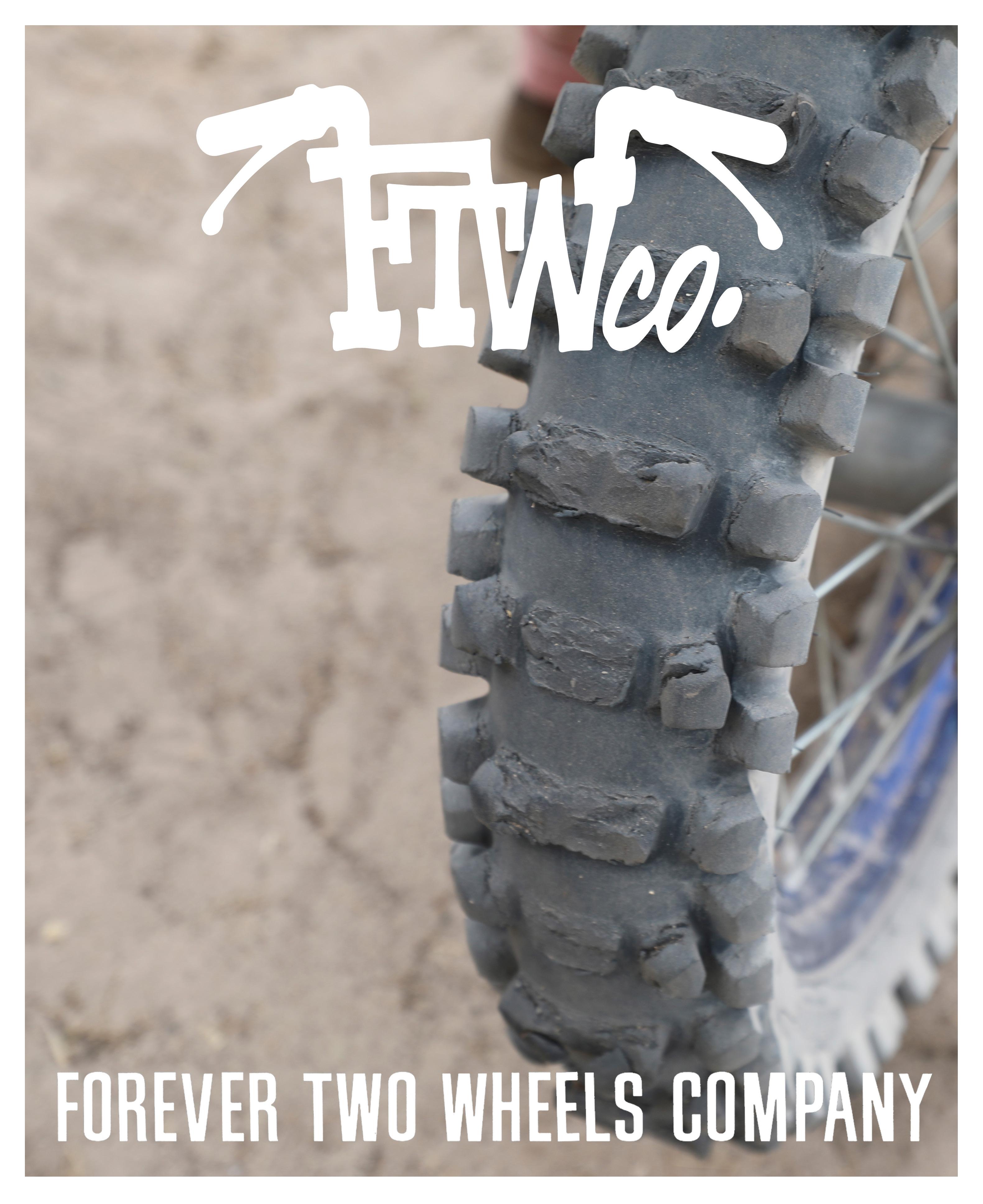
MANUEL PORTUGAL
30 years with a camera around his neck, nearly as long with bars in his hands. We celebrate Portugal’s premier motographer
Words: Gary Inman

67 >
OME SURFING IN the morning; afternoon shooting some interesting people and vehicles; dinner with family and friends and a rock ’n’ roll gig at night.’ Manuel Portugal is describing a perfect day. ‘Sometimes it happens.’
Manuel Portugal is a photographer; called Manuel; from Portugal. That’s his real name, Manel for short – like Dave for David. I first came across his work for REV magazine, then we met at an event in Portugal and have bumped into each other over the years since, both in England and his birth city, Lisbon. He’s lived most of his 44 years in the Portuguese capital, but has just been priced out and has moved up the coast to near Nazaré, home of the world famous monster waves that roll in off the Atlantic.
‘REV is a motorcycle “culture” magazine that is now celebrating its tenth anniversary,’ he explains. ‘It was pretty risky at the time to launch such a magazine in a small country with poor motorcycle history, but it was worth it. REV aims to talk not just about motorcycles, but the stories behind
(from left to right) The Ton Up Garage; Oporto Cafe Racers, 2014. There was a crash that day, because everyone was going really fast. I was trying to stay safe on the pillion and take photos; Barcelona Girls, 2017. Whenever I travel I try to contact people from the motorcycle scene and book shoots just for fun


the motorcycles, to show people who work or promote the motorcycle scene. The challenge from the beginning is to have the usual subjects but with a different, new approach, not just in the words but also in the design and photography. It was and still is important, because it opened [Portuguese] people’s minds and eyes to this different approach to motorcycling.’
Even though it has incredible opportunities for on- and off-road riding and world-class racetracks, Portugal doesn’t have the same diverse history of motorcycle culture as many other European countries. This is due in part to the fact it was for some time one of the poorest western European nations and also to the authoritarian ‘Estado Novo’ regime’s general anti-import policy, in place until 1974. But things are changing.
‘It’s crazy, because being a small, Southern European country, Portugal has a strong scene now. There are a lot of builders, artists and events all over the country. When I go to the Bike Shed Show in London I see three or four bikes from Portugal every year. Portugal
MANUEL’S KIT
Canon 5d Mark III It’s been very trusty over the years and will become a back-up camera when I get the new Canon R5. 70-200mm lens I’m a tele lens guy and this is my workhorse. About 90% of what I shoot is through this lens. It’s old, it has worked under very bad conditions – desert, sand, rain, salty water – and it’s failing a lot lately. Waiting to be replaced with the new 70-200mm RF. Sigma 85mm 1.4f lens. For
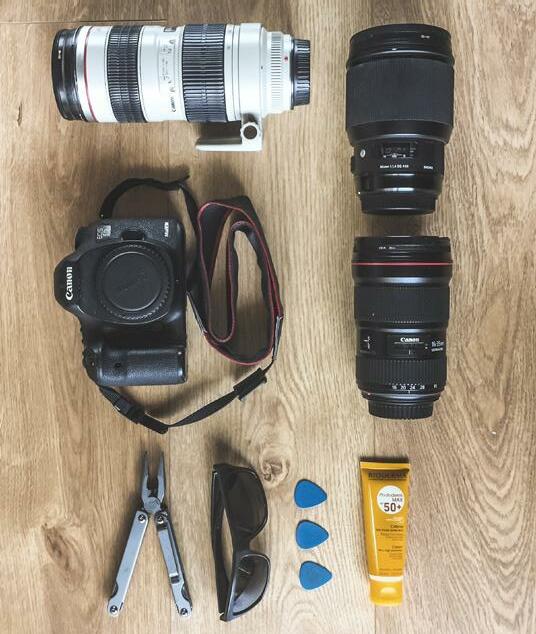
portraits or a fashion look, this is the lens I’ve been forcing myself to use to get new perspectives. Canon 16-35mm lens. Rarely used, except for tracking photos, but when I use it, it works really well.
Plus: Leatherman, because you never know; sunglasses, as the future’s so bright I gotta wear shades; guitar picks, in case I find myself in a jam; sunscreen, I burn easily and I’m always outside.

>
is a petrolheads’ country. If you see the world rally images from the ’70s or ’80s, you see how crazy and eager people were to get close to the roaring machines, sometimes putting their life at risk, but there was no economical and political access to motorbikes. In the ’90s there was a boom, and now we are living a second boom, with a new generation getting their hands dirty, more open-minded, more informed, and very skilled.’
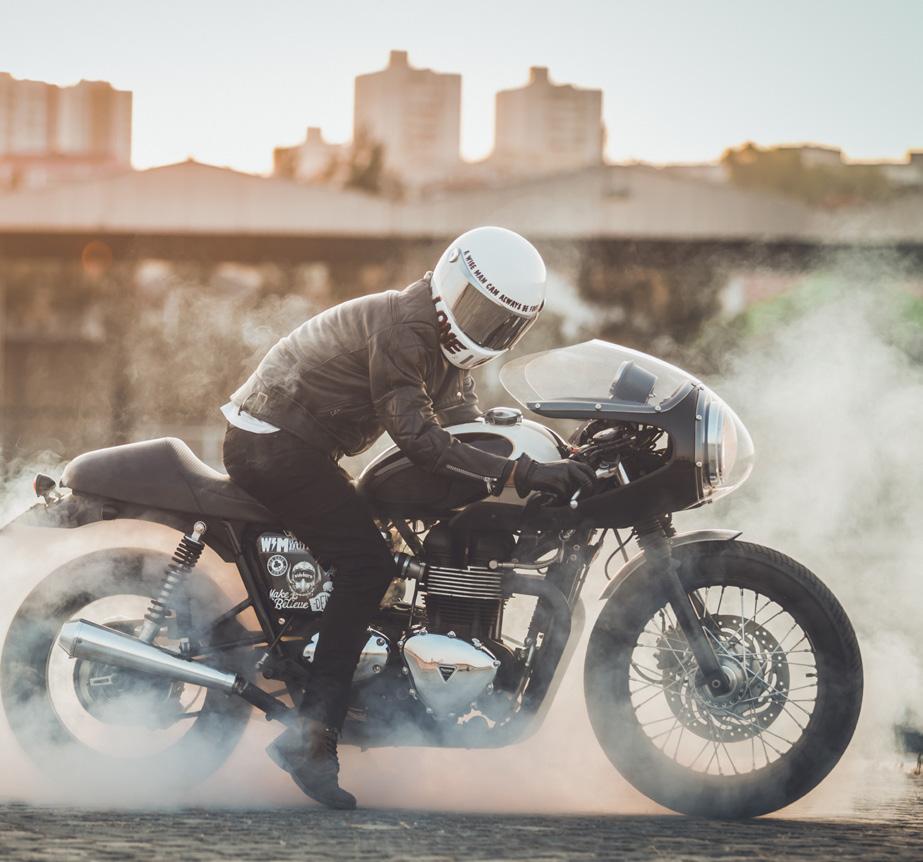
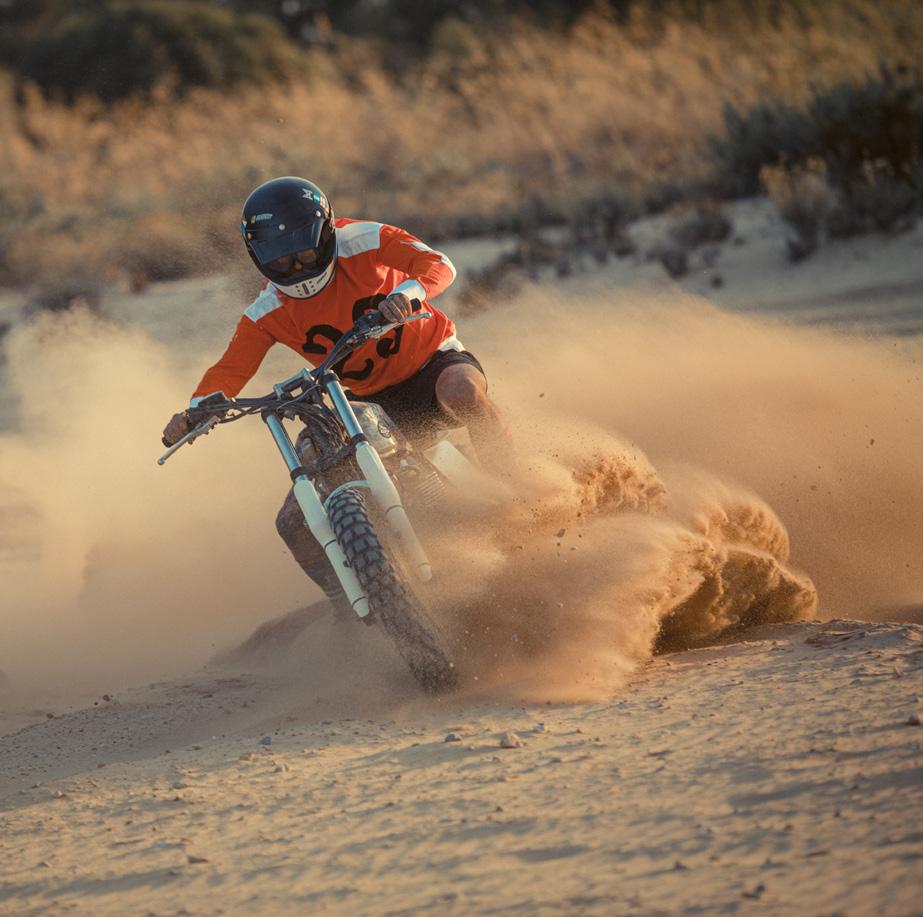
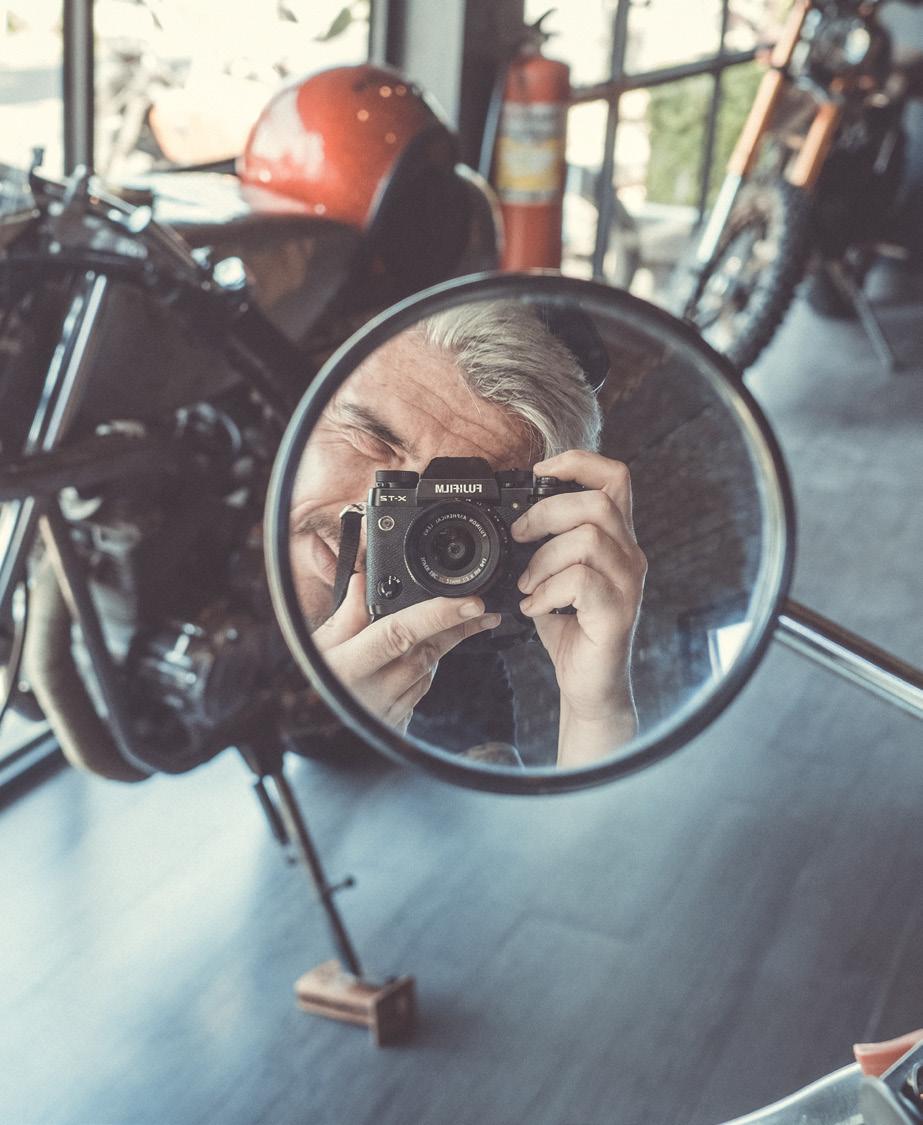
Manuel’s switch from the mainstream motorcycle press to REV is similar to my own path with Sideburn. ‘I worked for “normal” magazines for 14 years,’ he says, ‘where the motorbike had to be always well lit, you had to have the photo with the rider with the knee down, turning left, turning right and I got a bit tired of that. Now, my objective is to get a photo that can tell a story, even if it’s not in sharp focus or perfectly lit. Lately, I’m obsessed with shooting into the sun, against the light and photos with a strong human presence. In comparison to cars, bikes have a strong human presence. The position of the rider on a bike can change the feeling of the photo; a motorcycle is an incomplete object without a human on it.’
The photographer generally agrees with the statement often attributed to Confucius: Choose a job you love and you will never have to work a day in your life. ‘It’s perfect when you do what you like and get paid to do it. I don’t make a lot of money, but I’m able to shoot a subject I love and I get to meet very interesting people who share a lot of the same interests. It’s a blessing. In the beginning it was hard. I feel it took me 20 years in the business to become known. I love it here in Portugal, but it’s a small market too far away from the decisionmaking centres.’
You don’t consider those external forces when you’re a teenager. ‘I won an amateur photo
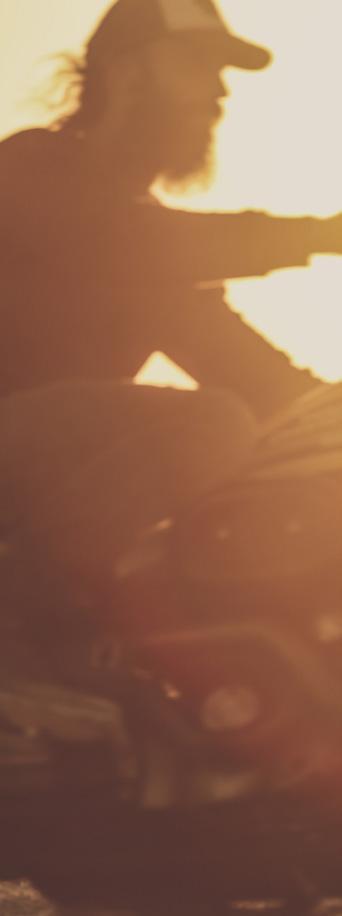

M ANUEL
(clockwise from top left) Self-portrait in Bali; Fiumani the artist; Bandit Garage BMW in Barcelos; Northsiders Nights in Porto; Scram Africa; Flag for Maria Riding Company, the pole broke after that; Dust Girls in Cuba. I’m making a short movie of this trip; Burnout for Nexx Helmets; Supermoto champ Cristiano Fernandes; Golden hour fun with the Maria Riding Company; Fuel Motorcycles Guzzi, Scram Africa. I was the official photographer for two years

PORTUGAL
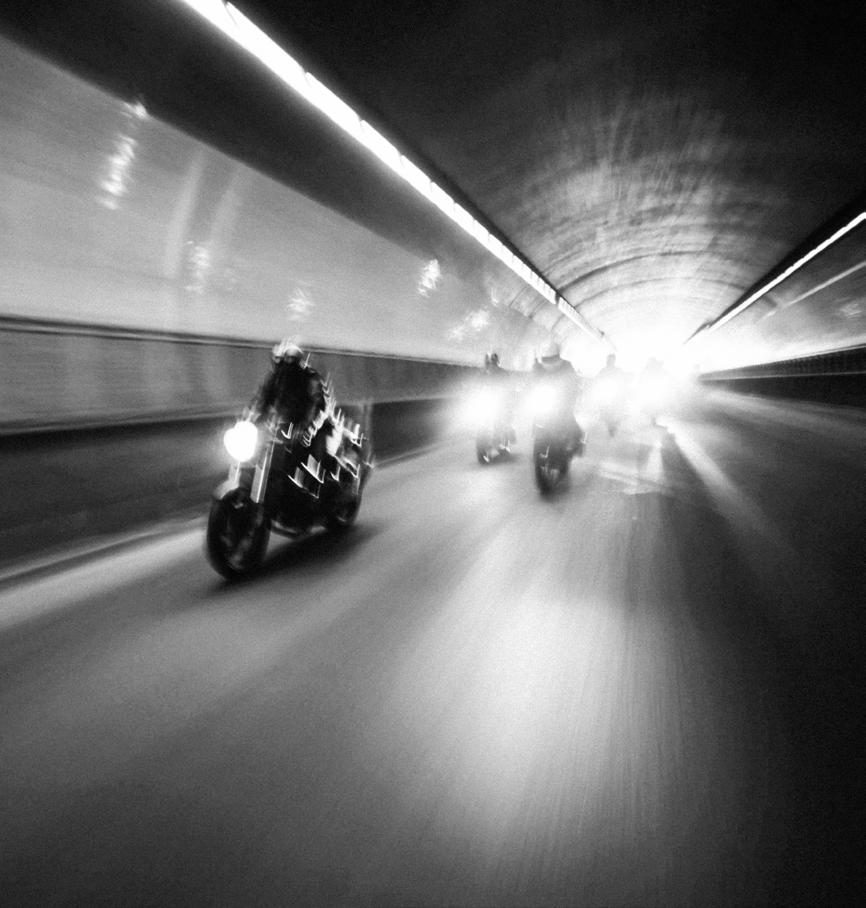

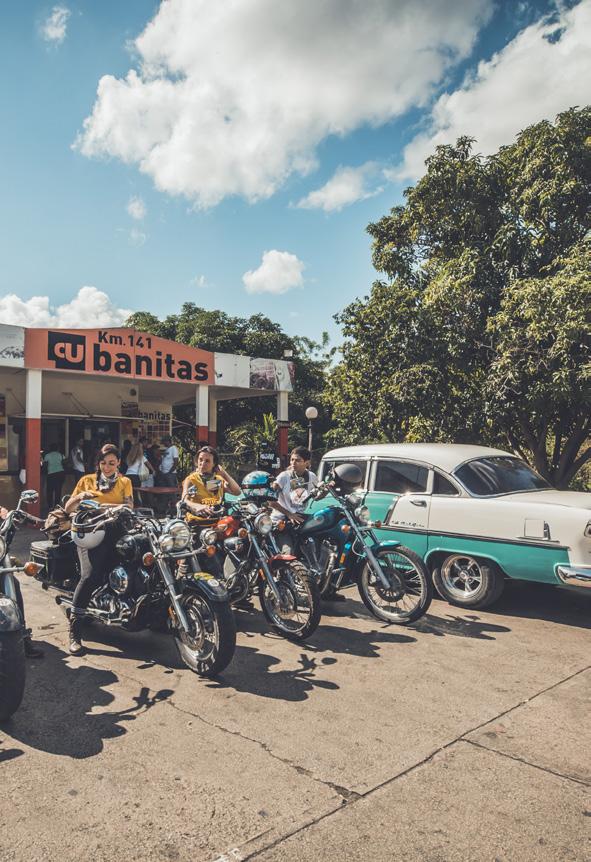
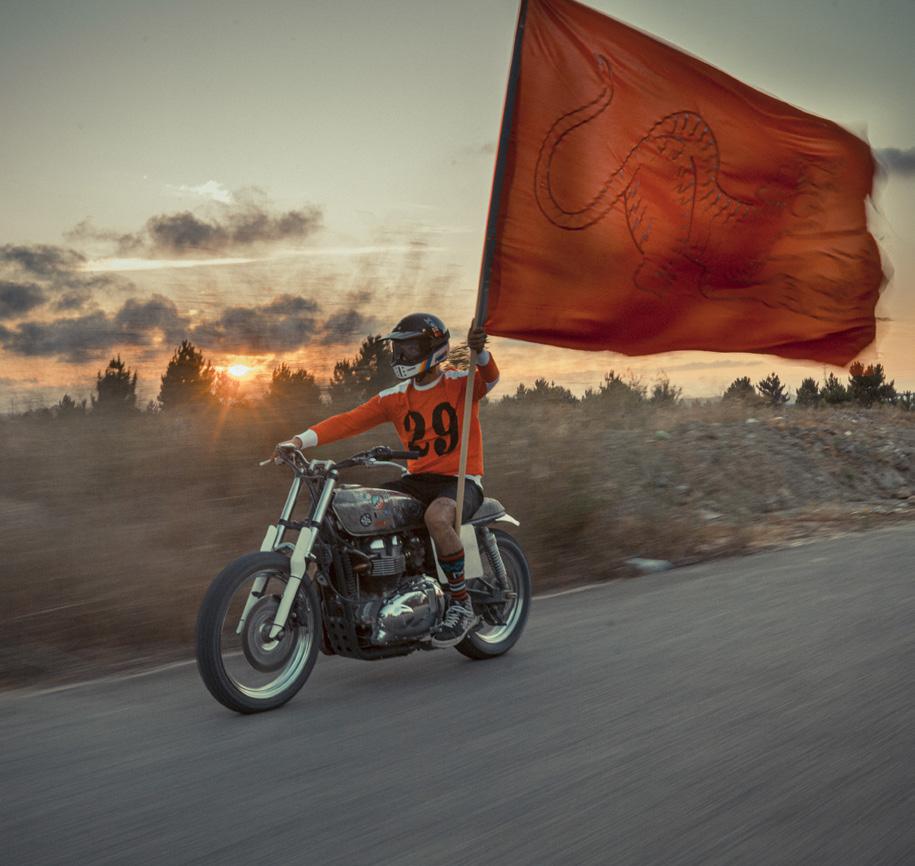

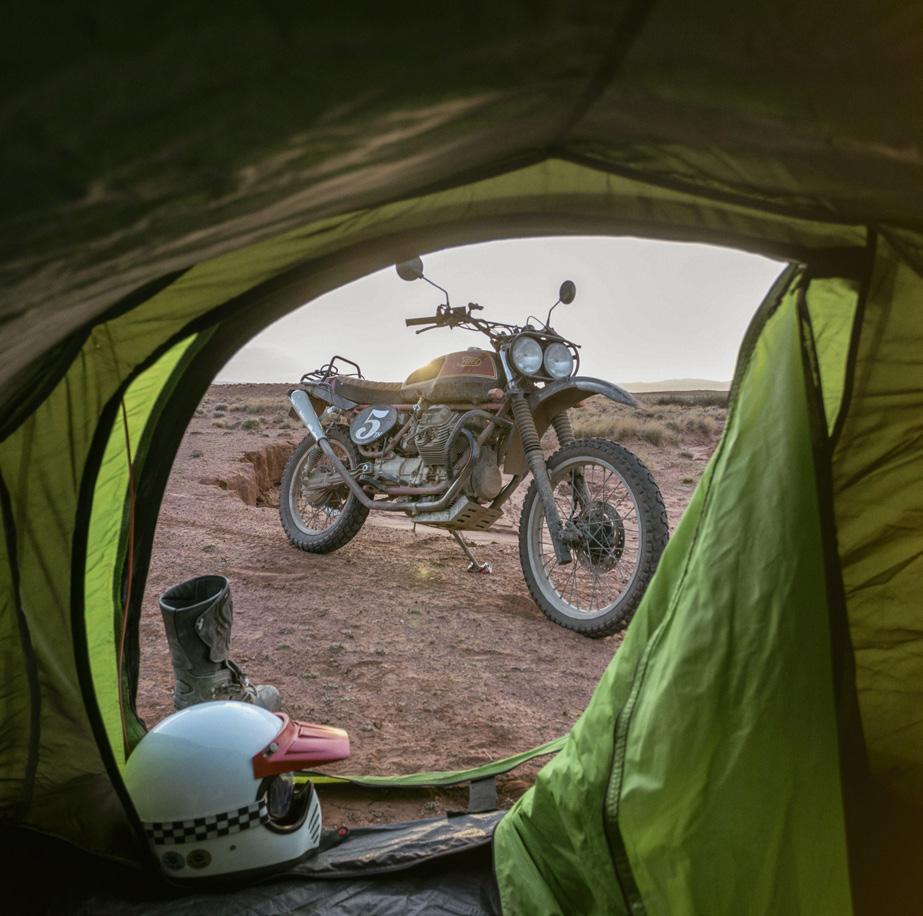


>

Portuguese pissed-up pagan pauses for a portrait >
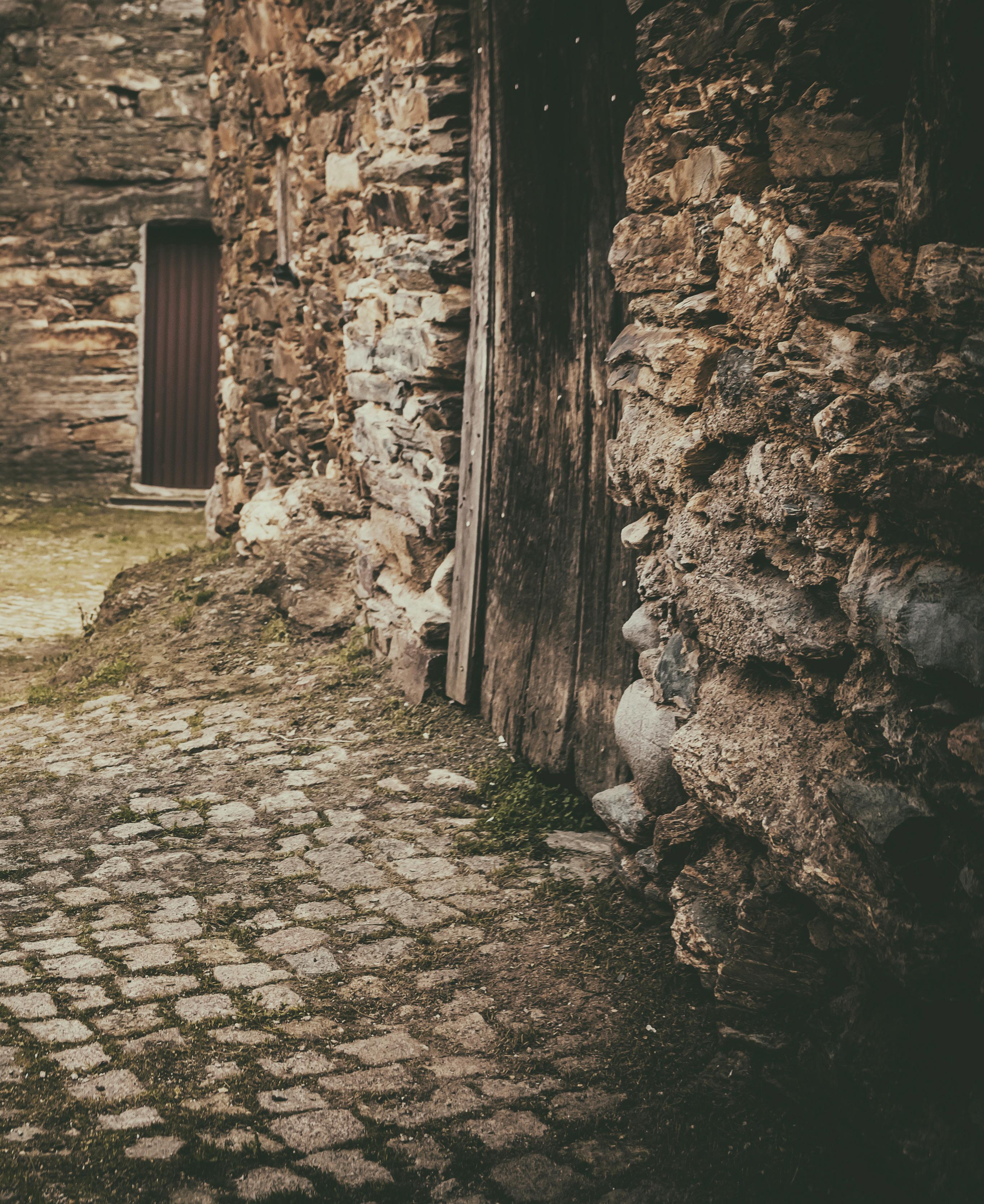
competition when I was 13 and that was the beginning. I went to art school from 14 to 17 and specialised in photography. I attended more photography courses after that. I was 22 when I got my first paycheck from photography. That was from a motorcycle magazine and it felt great.’
Cameras and motorcycles have defined Manuel’s life. ‘When you get into the motorcycle scene you have to be committed to it, there’s no other way. It’s not for the money, because you can make much more money with other photography subjects. I got hooked when I was a teenager, even though there’s no history of motorcyclists in the close family, but somehow the looks, the coolness, the feeling of freedom... At the time, when I was 16, you could have a special licence to ride bikes with up to 50cc engines, so everybody would start with that and eventually swap to cars at 18, when you can have a ‘real’ licence. I knew I wouldn’t have the money to buy a car, so it was logical and practical to get a riding licence and a cheap bike.’ Manuel now owns a 2001 Harley-Davidson Dyna FXDX, and it was years before he finally bought a car.
An example of his commitment to the scene is his involvement in a major event on the
Portuguese calendar, the annual Lisbon Motorcycle Film Festival (LxMFF). ‘It was something I had in mind in 2014/15. I noticed there was a lot of good content on Vimeo and YouTube and there was not a proper, worthy way of seeing that. I shared the idea with some friends, and together we started LxMFF in 2016. I thought it would be tough, but this team can move mountains and from the first year we got the support from Lisbon’s city council. And we have the perfect venue, a theatre built in the ’40s with three rooms, the biggest one with 847 seats, right in the heart of Lisbon. Our aim is to screen films where they should be seen – theatres – with good seats, good sound and images.
‘It’s a three-day event. During the day we have talks and short films and long films in the evenings. It’s very important for us to have the filmmakers on-site to represent the films and talk about their work, otherwise it would be just a screening. That gives the chance for the audience to meet people they see on screen and it’s one of the highlights. We try to make a small exhibition of bikes and artists in the hall. Our main purpose is to show recent films, none more than five years old. We made an exception in 2019 to

‘THE ONLY THING THE MACHINE CAN’T DO BETTER THAN HUMANS IS BE CREATIVE, SO WE STILL HAVE THAT. FOR NOW’
celebrate Easy Rider’s 50th anniversary. We take advantage of the golden times we live in now, where art meets motorcycles like never before in the last 40 years.’
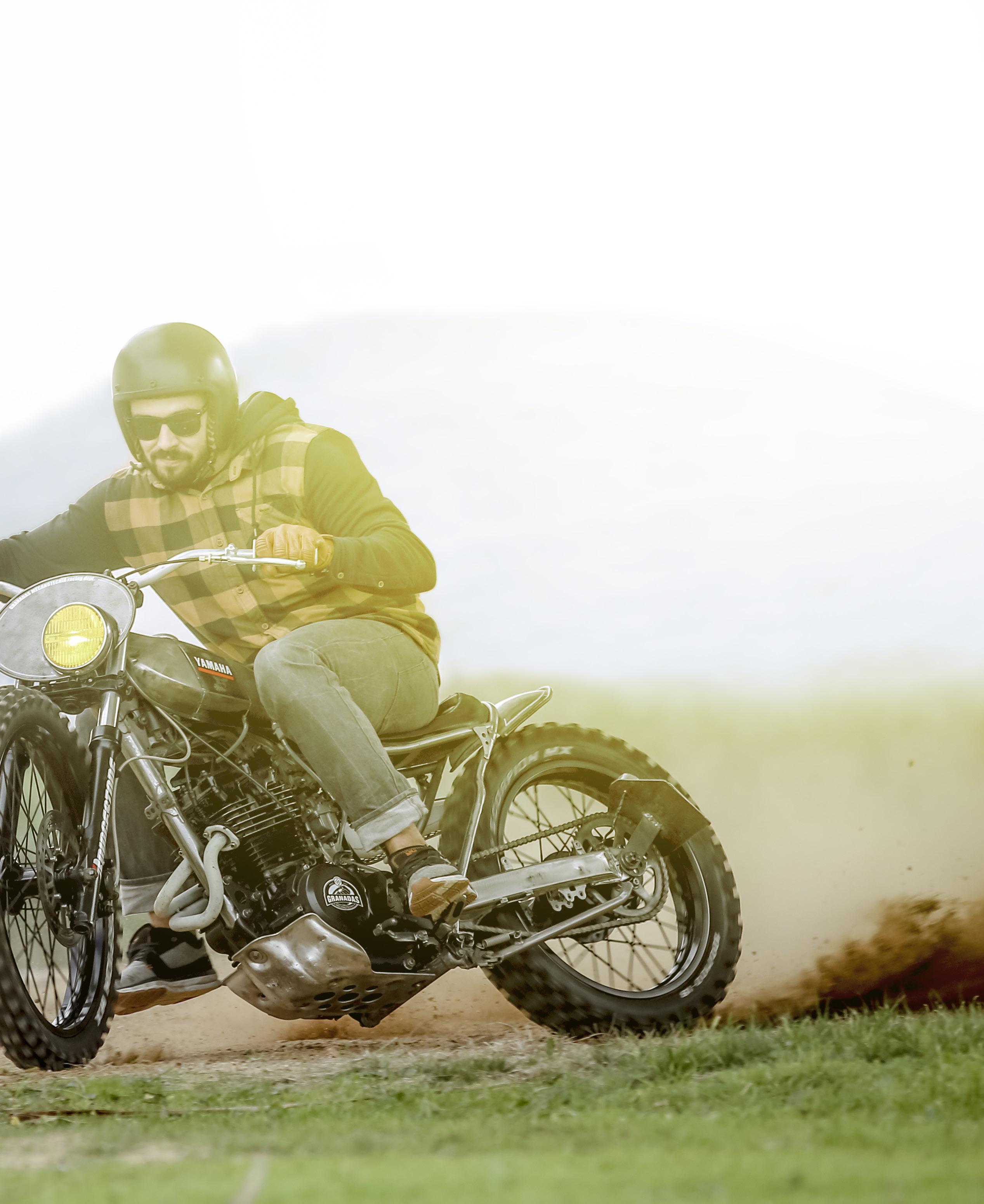
Instagram and iPhone culture has changed how we, literally and figuratively, view photography. How does that affect someone with 20-plus years in the business? ‘I’m not very optimistic. The machine is taking over. The only thing the machine can’t do better than humans is be creative, so we still have that. For now.’
When it comes to Instagram, Manuel admits, ‘I quite like it, it gives me the opportunity to follow other photographers’ work and it has shown me some good photos over the years and I can also show my work. I’m not worried about competition with other photographers, I try to do my thing. I follow a lot of photographers and I’m a fan of Laurent Nivalle, John Ryan, Sebas Romero, Josh
Kurpius, Vince Perraud, Larry Niehues…
They all influence me. I wish I was more edgy, radical, like they are. I’m still trying.’
Manuel has shot car launches for Honda –as corporate and structured as it gets – but makes time for his own private work, like the tours od Cuba and one of my favourite shoots of his involving pagan wildmen.
‘Yes, the Caretos de Podence shoot. It’s one idea I had to mix Portuguese traditions from a pagan carnival with custom bikes. It took me two years and a lot of travel to do it. The Caretos are like little devils, hellraisers, running and jumping on the streets, trying to get single young ladies, and when they find one, they shake her and hit her with the cowbells they have hanging on their waist. It marks the end of the winter, and they told me it was pretty rough back in the day, now it’s more peaceful, more controlled.
‘The first time I tried I couldn’t find a cool bike to get there, but I made some contacts and on the second try I had the perfect bike, the perfect setting and ten minutes for the shoot. The Caretos were in party mode, they couldn’t care less about the bike and the shoot, they were completely drunk... Still, it turned out pretty good.’
Granadas Mecanotécnia’s XT350 spitting a roost
5ive steps to sudo
One man’s journey from BMX street rat to race-mad flat track component designer
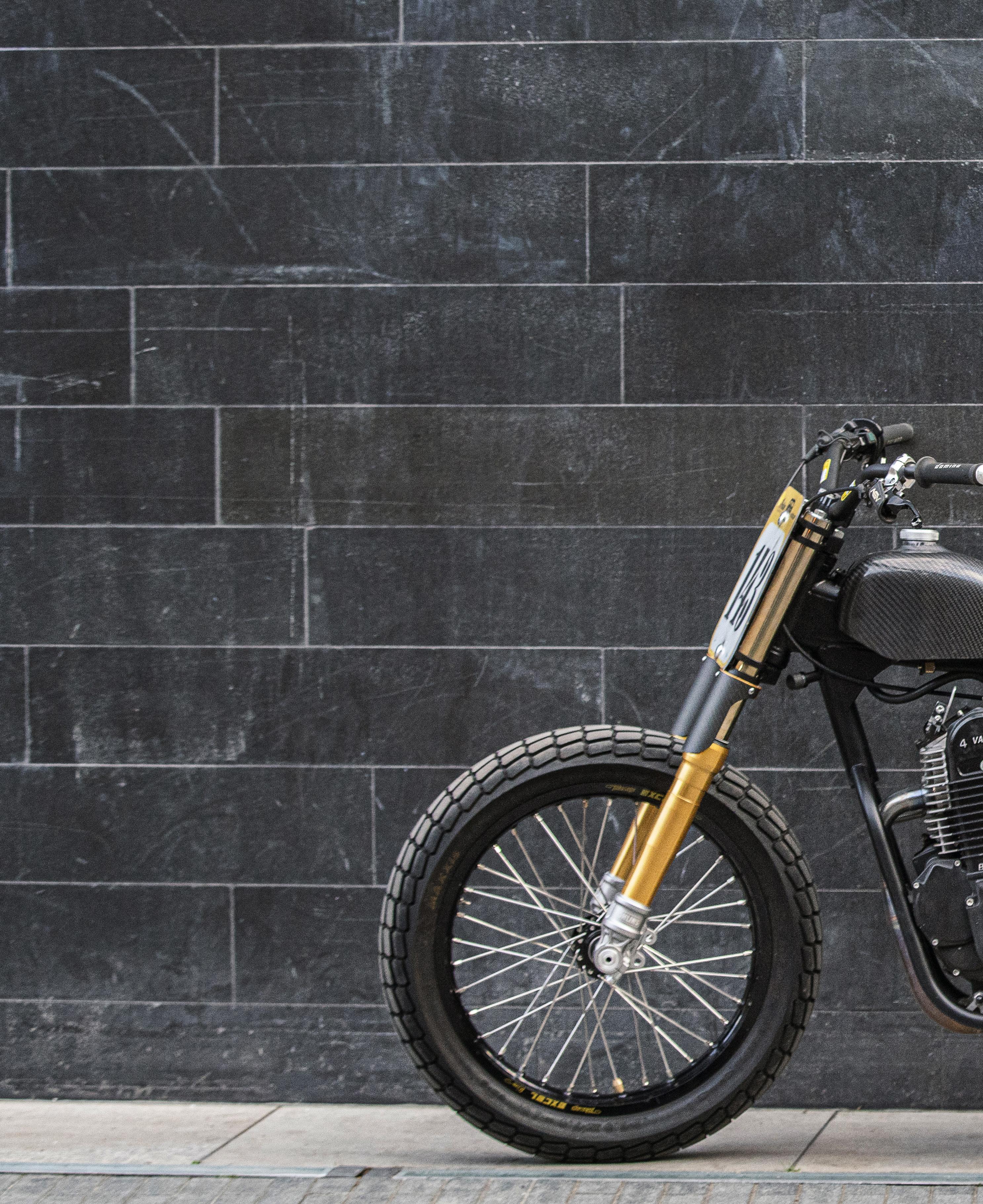
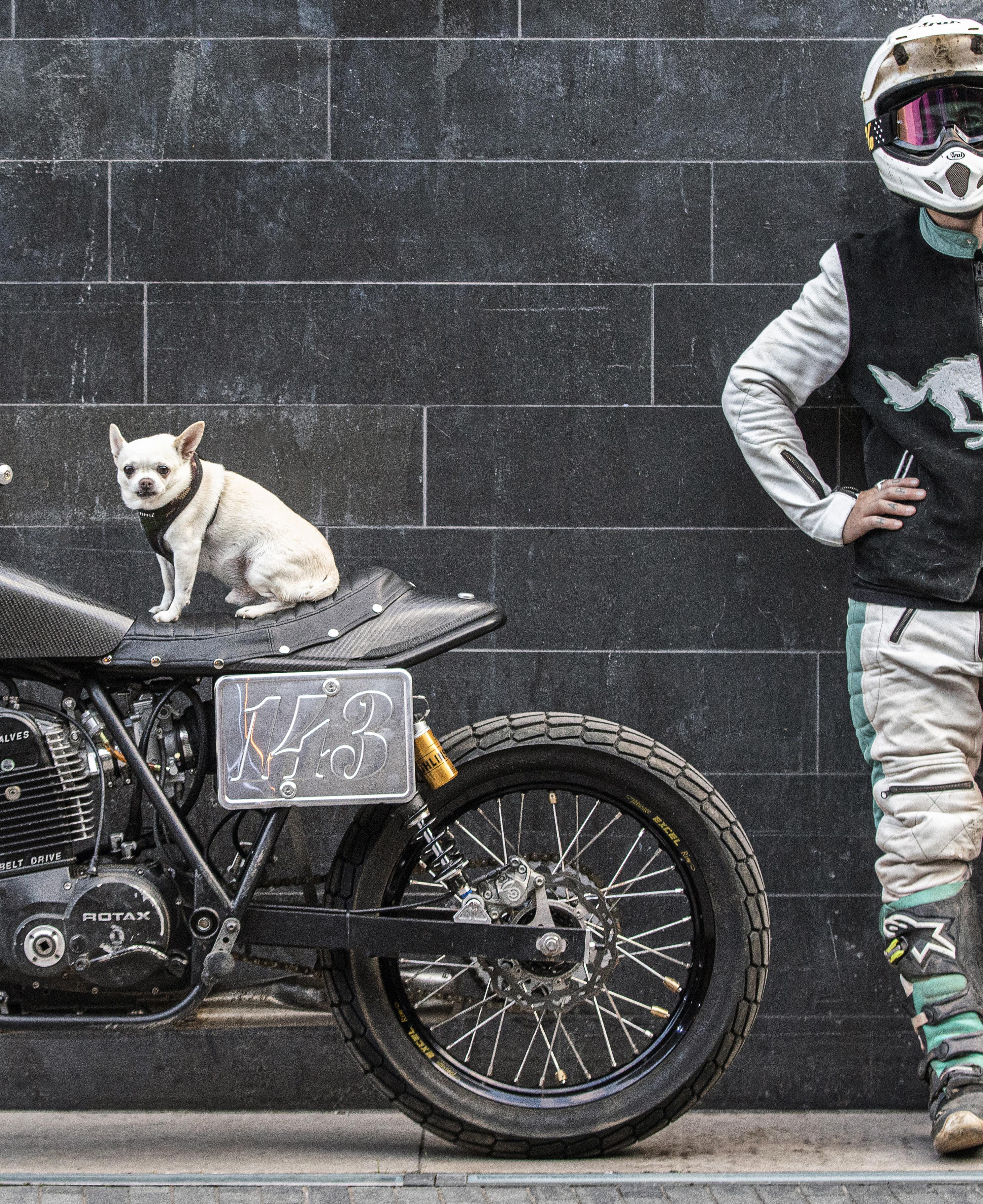
77 >
Words: James ‘Leftie’ Smith Photos: Sam Christmas
step 1
Around the age of ten I discovered the 1983 book BMX Freestyle by Dave Spurdens in the school library. It was the best thing I’d ever seen (and is still in my possession… sorry, not sorry). Everything about it was amazing: the photos, skate parks, sequence shots, even the How To Build Ramps, which, thinking about it now, may have been first time I’d ever seen technical drawings. I remember spending hours drawing my own ramps, thinking about why they had certain bits and needed a supporting structure where they did. From then, I would spend all summers with my mates digging jumps in the local woods any chance we could, making sketchy kickers with bricks and bits of wood to send it off them.
As we went into our teens we would get the train to South Bank [area of London] to ride and go street riding all over the city, coming home in the wee hours, always hungry to do it all again. I started doing more flatland, which is a stripped down form of freestyle where you do stuff with the bike without ramps on flat ground. I would often spend ten or more hours in car parks repeatedly doing the same thing till I learned it and then I would move on or incorporate it into a previous thing I’d learned.


I started travelling to competitions in the UK and Europe. I got to a level where I started getting good results at events and would get exposure in magazines. I was sponsored by Carhartt and WeThePeople bikes and others over the years and thanks to them and BMX I had some of the best years travelling the world, having the best times.

Sudo Cycles production parts include fork guards, triple clamps and front and rear sprocket covers
step 2
In 2008 I was in the French Alps for a few months’ snowboarding. Towards the end of the trip, I got a bit cocky, eyeing up a big jump down the side of the mountain some pros had built the week before. Little did I know, the snow was hard packed from hundreds of landings. Long story short, I landed on my back, earning myself a mix of compression, collapsed and straightup fractures on several vertebrae on the lumbar and thoracic sections of my spine. As much as I tried to ignore it, it definitely took the spring out of my step and affected my ability to ride BMX, so I started exploring other interests, including filming and editing. This meant I was able to stay involved, travelling to film BMX for a few more years.
During that time, I invented a few camera equipment products and had pretty crazy overnight success. It was hard work, but I had an income that meant I could indulge new things.
Till my mid-20s, I’d had a shitty, 125cc scooter, but my stance was I must avoid being tempted by bigger bikes. I’d heard of several BMXers meeting their deaths as a result of transferring their gung-ho BMX ways to motorcycles. Twentyplus motorcycles later, I’m riding as much as possible, on road and track, to make up for those years of uncharacteristic reserve.


>
step 3
After seeing an advert for Dirt Quake 2, me and a friend decided to ride to it with surprisingly little idea of what it was all about. We turned up the night before at the camp location and it was awesome seeing the eclectic collection of bikes that people had brought there to race the next day.

In the morning before Dirt Quake, the DTRA had a race meeting for their Rookies. This was the first time I’d seen flat track in person, and the noise of all the bikes charging down the straight into turn one is something I will never forget. The DQ event format, with all the crazy different bikes and classes with flat track virgins taking to the track for the first time, made me keen to enter on my 2001 Sportster chopper, not knowing I’d missed the window to enter months before. From that moment I was counting the seconds to enter the following the year.
After the long, 12-month wait, I entered on my Harley 10in over ironhead chopper. Mid-race, I managed to snap my transmission mainshaft but, my cherry popped, I was hooked and wanted more. When the DTRA introduced a Hooligan class for the 2016 season, I was all over that like a rash and went about converting my Sportster.
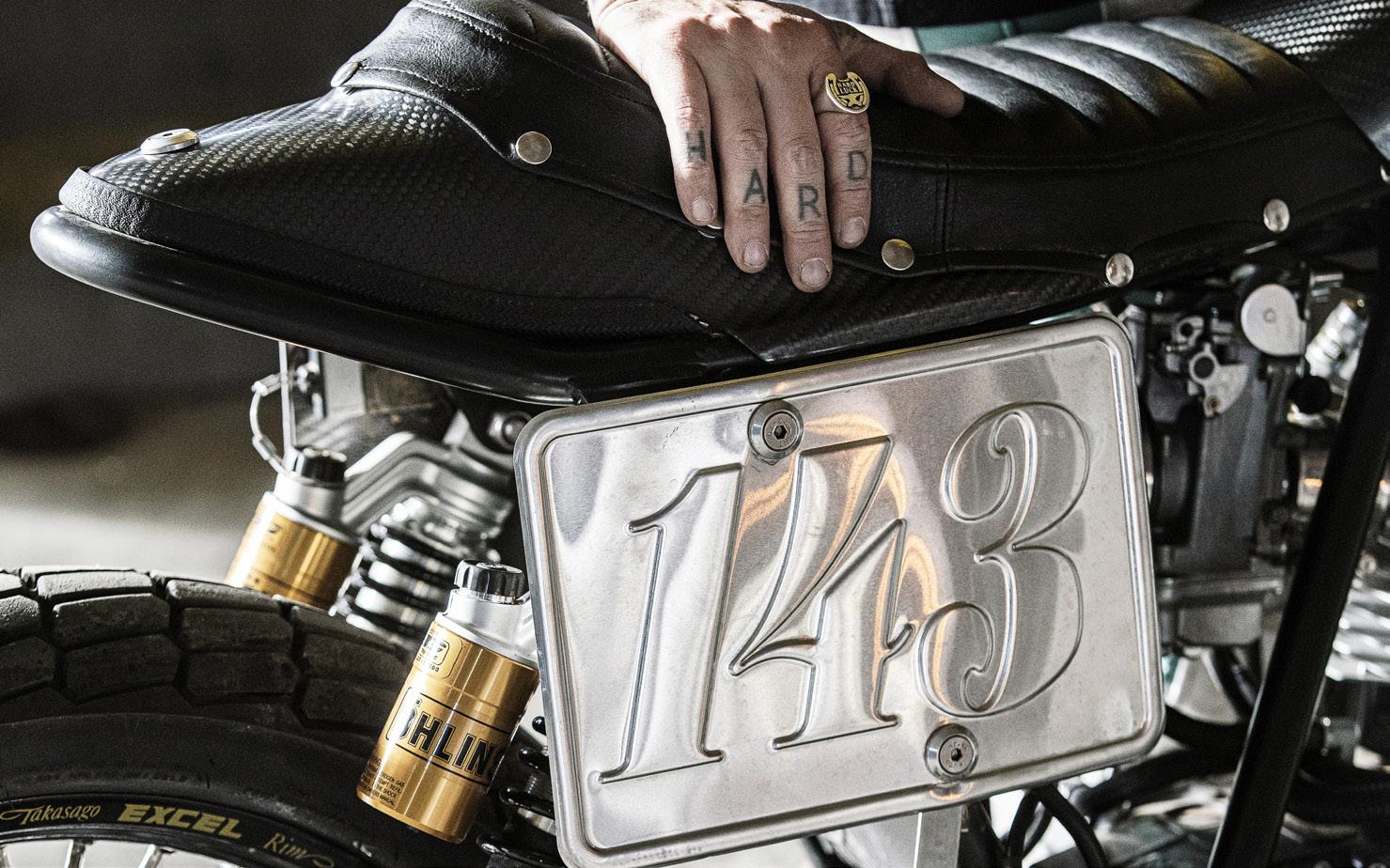
‘This was the first time I had seen flat track in person, and the noise of all the bikes charging down the straight into turn one is something I will never forget’


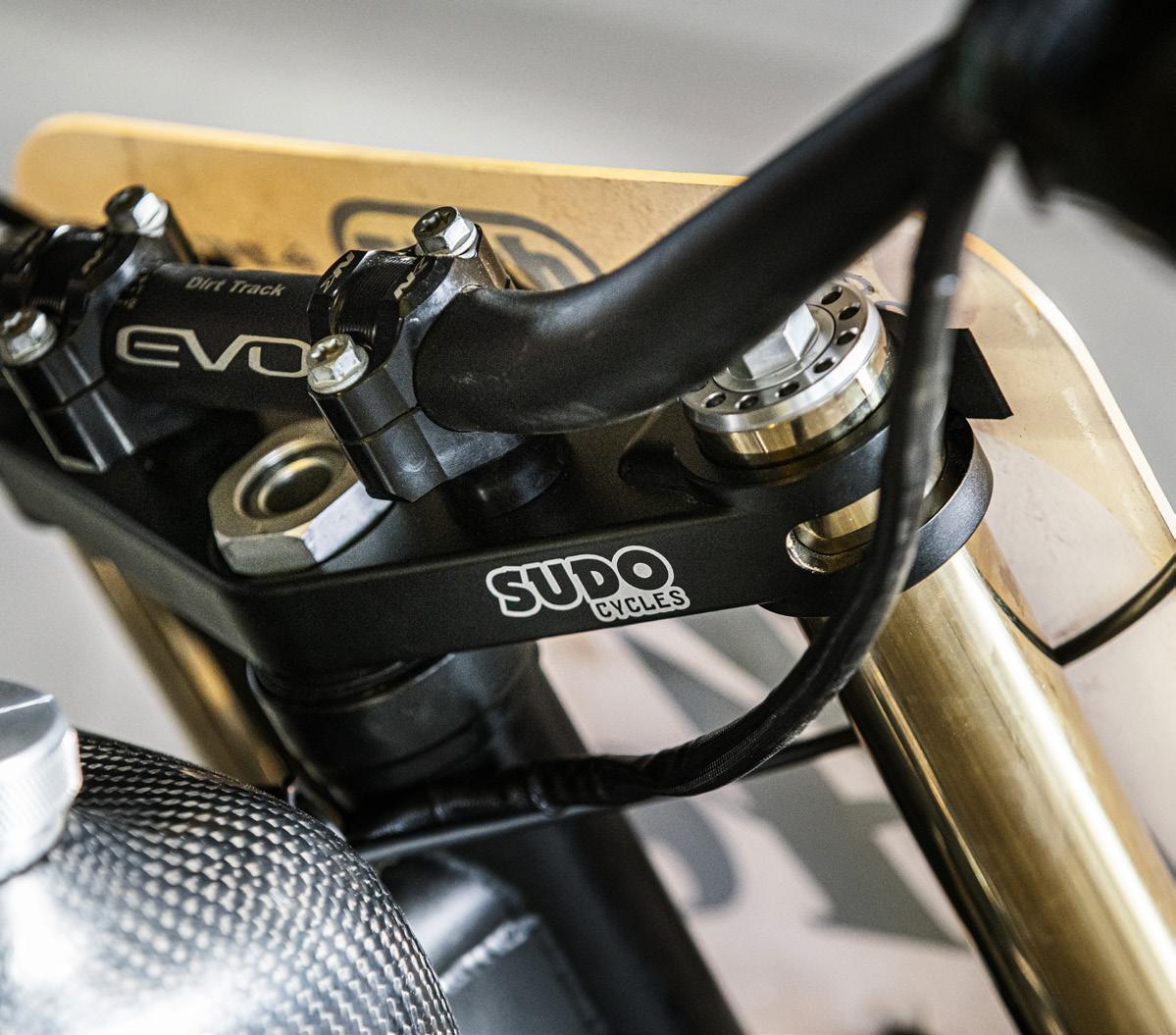

> 35 23 17 15 10 10% Prominent 115% 5% smiles 12% pants 48% Tattoo side hustle 15% Carbonfibre bits 15% Piss-stink car park 10% Pressed number boards 12% Attentionstealing pooch 48%
step 4

It quickly became clear racing the Harley hooligan that weight was an obvious hindrance. I was more of a passenger than a rider, due to the lack of any racing or even dirt experience. The Hooligan class was my focus, but I wanted to explore other bikes that would help develop skills that I could apply on the Harley. The DTRA’s Thunderbike class1 stood out to me: powerful engines, but still considerably lighter and more agile than the Harley, plus buckets of classic flat track aesthetics.
I decided to buy a thunderbike and went for the ‘go to’ workhorse, a Rotax 604 engine, then had a CCM road bike frame modified by Survivor Customs2. I spent the 2018 season unlearning Harley/hooligan bad habits and learning to ride this new set-up. The next season, I started to get comfortable and was enjoying the Thunderbike class more than the Hooligans.
Then, in the final round of the 2019 DTRA season, I had a nasty highside off a Sunday minibike that gifted me a broken collarbone, ten broken ribs and punctured lung and, my old favourite, another broken vertebra.
My post-healing aim for 2020 was to build on and better what I’d done the previous year (not the crashing part). Some of the races, I felt I was riding well but losing places on straights, despite throttle pinned.
Anthony Brown (DTRA head honcho and fellow Rotax Thunderbike racer) offered a few ideas. The plan was to stick to stock bore, but fit a high-compression piston, larger inlet valves with stronger springs and a larger carb.
Appendix
1. DTRA Thunderbikes is for the following: Multi-cylinder two-stroke machines – 500cc to unlimited; Parallel twin four-stroke machines – 500cc to unlimited; Singlecylinder four strokes – 600cc to unlimited; V-twins and multi-cylinder four-strokes –600cc to unlimited. 2. See Leftie’s and other Survivor CCM Rotax thunderbikes in SB34.
‘king time consuming, ‘king expensive, ‘king worth it though
When I came to re-fit the engine, the new Mikuni flatslide carb wouldn’t fit my CCM frame. That was the gentlest of pushes needed to convince myself to go the purposebuilt framer route.
A few years before, I’d seen Bram De Roeck’s Co-Built3 and thought it looked so good. The frame featured geometry that had been expounded by Kenny Roberts and sounded like a winner.
I approached Geoff at Co-Built in Oxfordshire, UK, with a loose enquiry and ran some ideas past him. He was super open and keen. I sold my Thunderbike, minus the engine, and set about building a bike with the best set-up possible, a bike I could grow into and if it didn’t perform it was me, not the bike.
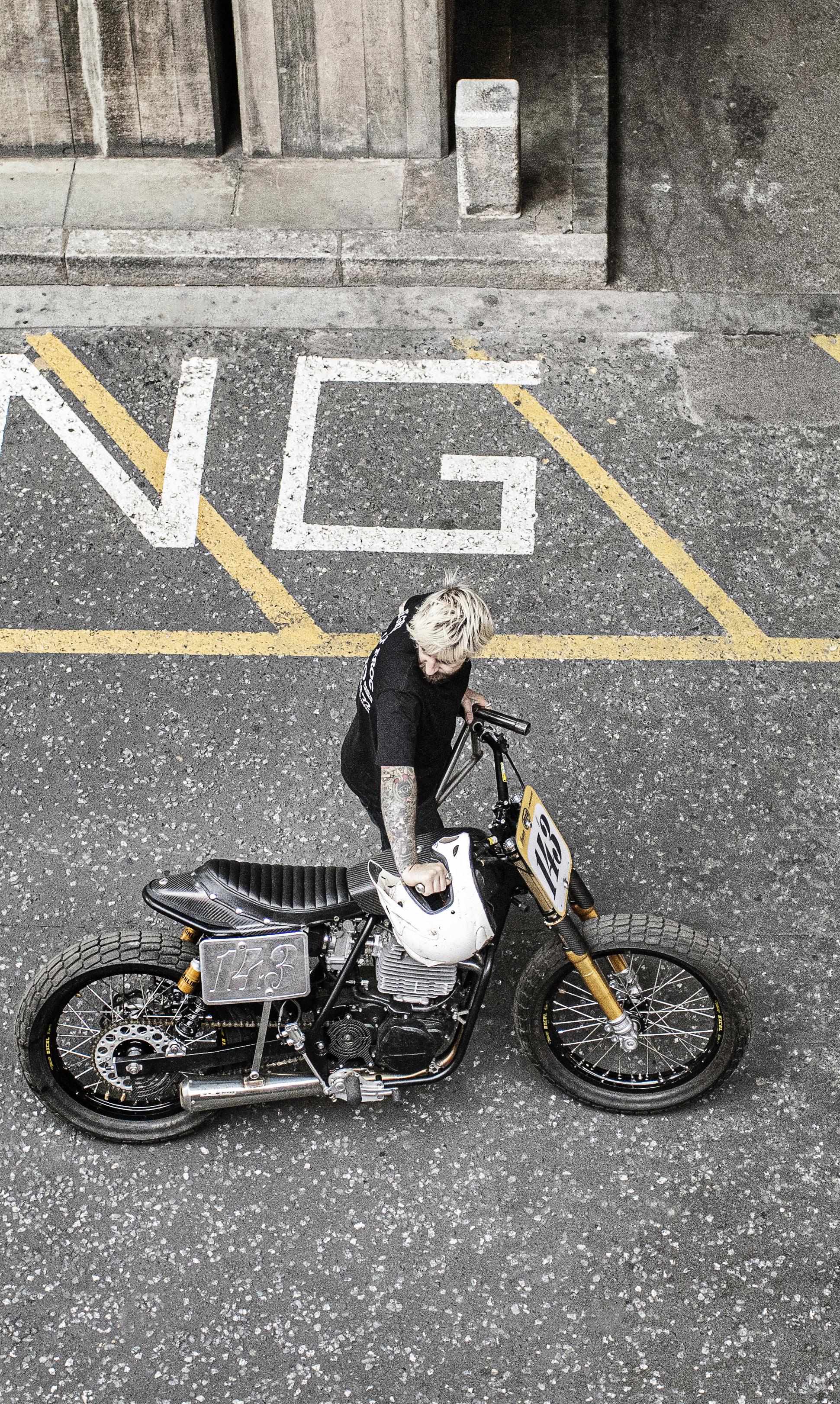
My riding seemed to improve when I had help with setting up the suspension. There’s no point having loads of power if you can’t keep the bike straight and on the ground. I’d been talking with Ben at BG Motorsports, a suspension expert who attends DTRA races, assisting riders with set-up at races. Support those who support the scene. So I bought Öhlins via him and he set them up for my height and weight.
I’d had a carbonfibre mould made for my hooligan build years before that I wanted to get more use out of, and I love the Wood Rotax tank and tail look, but I always thought the seat looked as if there was room for a pillion passenger, so I requested a frame to accommodate a far shorter seat base, which gives the bike a modern twist.
Appendix
3.
Bram’s Rotax graced the cover of SB30.
>
step 5
December 2019, while Co-Built started the frame, I had loads of time to think and plan details about the bike. I’d recently started using Shapr 3D CAD, so I used my bike as a project to learn the software. Some of the parts I designed would be useful for other people building bikes, so it gave me motivation to put extra thought into the designs and how they could be manufactured to be good quality and affordable.
I’m mainly self-taught when it comes to engineering and design, but towards the end of my involvement with BMX I worked for a German parts company, dealing with factories, finessing manufacturing details and developing new products, all stuff I put into practice with the camera equipment company and products I invented.
For the last six years I’ve been working in Hard Luck Tattoo, a shop that me and my friend Luke opened in south-west London. Pretty much every free moment when I’m not tattooing, I keep my eyes open for things that could be designed, improved and manufactured and that led to my motorcycle parts company, Sudo Cycles. In geeky computer coding it stands for the command ‘superuser do’. I wanted something short, that had a Japanese sound, and wasn’t already overly used throughout the internet. Designing anything is better when you are immersed in the thing it will be used for, but can also blind you to the business pursuit of profit. I wanted to see some of my ideas turned into reality, but I went to town trying to make them high
quality products and I may never see a return of investment for some of them. I’m cool with it though, as the process of learning, designing and making, followed by positive feedback, makes it all worthwhile.
Sudo Cycles is a one-man show, so I have the freedom to go in any direction and I’m excited to see how other product ideas develop.
Now I’ve tested the bike and it’s surprising how quickly I felt at home on it, even after 300 days of no flat track due to injury and Covid-19. The tailored suspension will be a factor, but the proven geometry gave a feeling of being on rails, but still with agility and control when the extra 10-plus horsepower made the back end want to overtake the front.
Sudo-cycles.com

‘Hi Ken, it’s Pam. Yeah, I have a bloke here wants to ride his motorbike through the shopping precinct. Said you gave him permission. Is that right? Over.’









EGOR
STEPANIZHOV IS Russian and tells us, ‘The bike is a 1963 T120R. We drowned it in a pond, so we decided to make a framer.’
As opening lines go, that takes some unpacking. Let’s start with Egor. He is the co-owner of Anker Company, a surf brand and shop in St Petersburg, formerly Leningrad, on Russia’s Baltic coast in the Gulf of Finland. He and business partner Peter Tyushkevich are motorcycle lovers, too. I first met the Anker crew at El Rollo, the Wheels and Waves short track race in Spain, where they were racing a Soviet IZH two-stroke they’d made into a short track racer (and speaking great English). If your European geography isn’t up to scratch, St Petersburg is a 4500-mile (7250km) round trip to the El Rollo track in San Sebastien, Spain, the route passing through the widths or lengths of Latvia, Lithuania, Poland,
Russia’s only Trackmaster Triumph twin
Germany, Belgium and France. Don’t doubt that Europeans are committed to amateur flat track. But anyway, the pond...

Anker bought the Triumph, in close to stock/mild desert sled trim, from Mike Davis, co-founder of the world famous Born Free custom show in California. ‘It was in good condition, started first kick, but the Amal carbs were pretty old and they played a dirty trick later,’ explains Egor. Importing bikes into Russia is expensive, so Anker had the bike delivered to an address in Germany, dismantled it and brought it into his home country as used parts, via Lithuania and Finland. They can’t register the bike on the road, but it’s a racer so they’re not bothered.
The pond? Oh, yeah. Egor’s business partner, Peter, entered a local race that looks like it takes place in quarry next to a motorway.
‘Our friends in St Petersburg organise a friendly race event for Soviet and old motorcycles. It’s
POWER SUPER
Meet
Words: Gary Inman Photos: Semen Kuzmin

87 >
Harmonious
There is a perfect poise in the Triumph with its organic, flowing lines. It’s a result of flat track feng shui




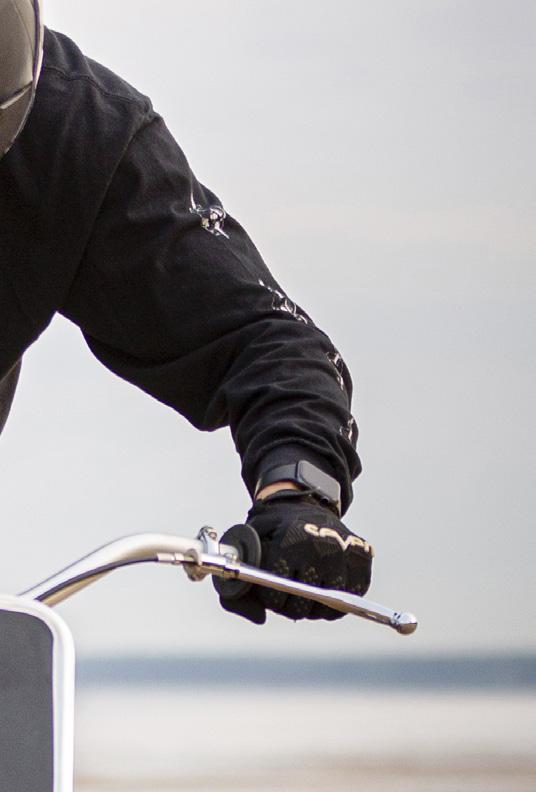

>
Egor and Peter smiling the smiles of two riders confident they have built the coolest flat track bikes in the whole, enormous country
‘Once the throttle was opened wide it didn’t close until the Triumph landed in the pond’
called Road Trash, it’s only for old motorcycles. Lots of people have IZH, Jawas and Urals lying somewhere in their garages or country homes with no documents. The race gives these old bikes a second life because people repair them to get back on track.’
The Triumph, having been brought in from California, must have felt like it had been sent to a gulag when it was rolled out of the back of the van. It was about to get worse for the immigrant. ‘From the very start Peter had problems with the carbs and once the throttle was opened wide it didn’t close until the Triumph landed in the pond 2 ,’ says Egor.
As a result of being submerged in the filthy water the engine was rebuilt and everything replaced except the cases and head, according to Egor. A nickel-plated Trackmaster frame and fibreglass tank was ordered from the US, Ceriani forks and rear shocks bought from Atelier Chatokhine in France. The arrival of a custom exhaust; wheels; pegs; Brembo brakes; fender; seats; Hunt magneto and Mikuni carbs was followed by lots of nights of work.
‘All in all, it took around half a year to build it, but the bike still needs fine-tuning,’ says Egor.
As he’s already explained, the bike is a pure racer, so how’s the flat track scene in Russia?

‘There’s a speedway track 150km from Moscow,’ says Egor. That’s about 190 miles (300km) from Anker’s home in St Petersburg, but Egor has a plan. ‘Right now we are negotiating with an old speedway track in St Petersburg. It is fully destroyed, but we hope to rebuild it before the fall.’
Like I said, don’t doubt that Europeans are committed to amateur flat track.
Appendix 2. See the video at tinyurl.com/y6s59n27
Anker fitted a modern, LeoVince silencer because it’s still relatively hard to find motorcycle parts in Russia

>
THE DOG
This is the bike I saw at El Rollo, but with new paint and improvements. It is based on a ’74 Izh Planeta Sport 350. Russian riders shortened the bike’s name from Planeta Sport to PS. Add an ‘e’ in the middle to get ‘pes’, Russian for dog, the bike’s common nickname in the former Soviet Union. ‘They were the fastest production motorcycle you could buy in the whole USSR in the 1970s and ’80s,’ says Egor, that’s him with the bike. ‘It wasn’t made to carry sacks of potatoes from one farm to another, it was created for speedy burn-ups.’ Anker’s Dog is unrecognisable from a stock Planeta Sport. The power has been increased from 32 to 47bhp. The front forks are from a 2007 Kawasaki ZX-6R. It has new wheels and exhaust and Anker made the onepiece GRP bodywork themselves.
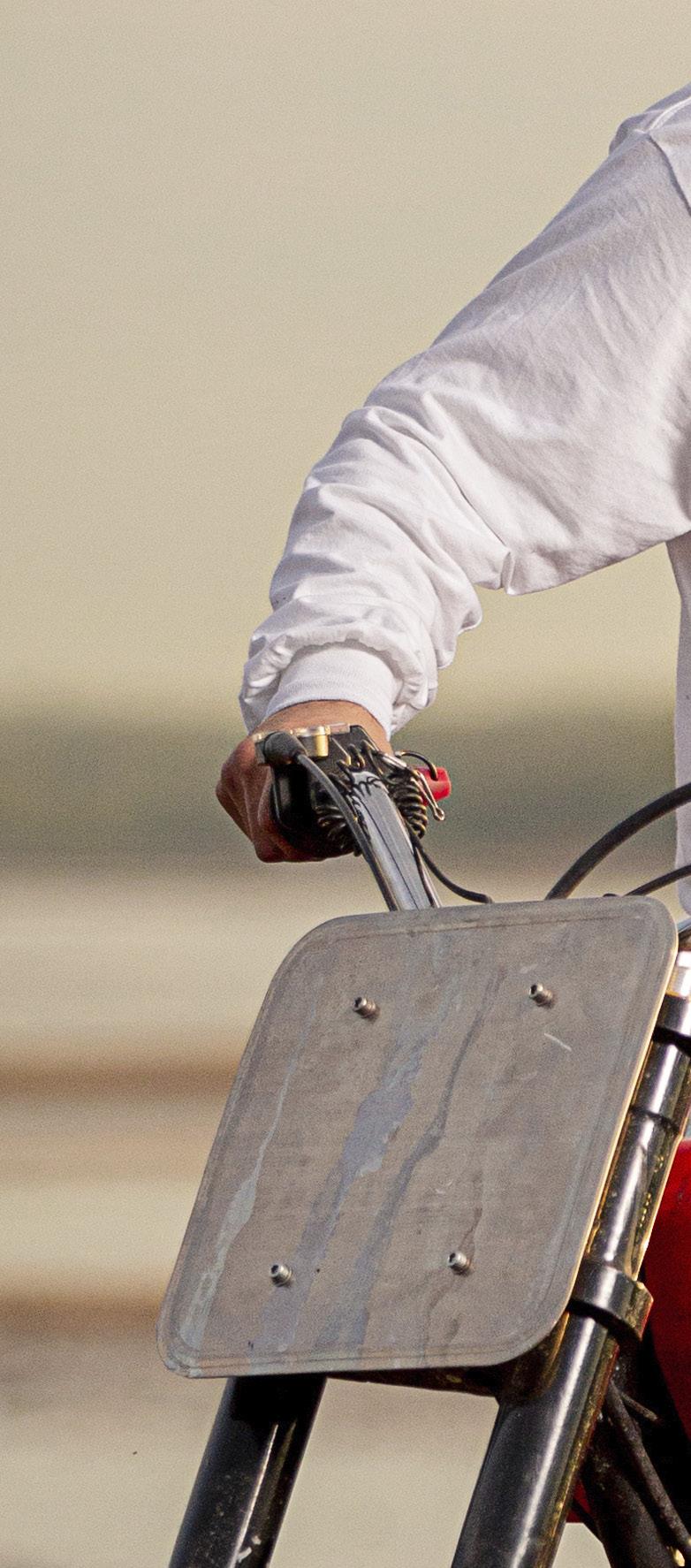


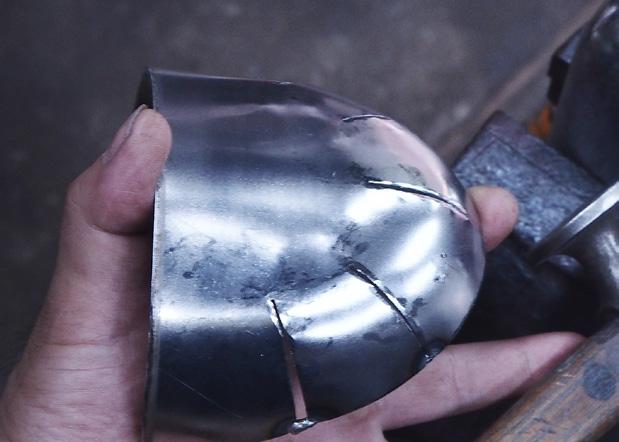

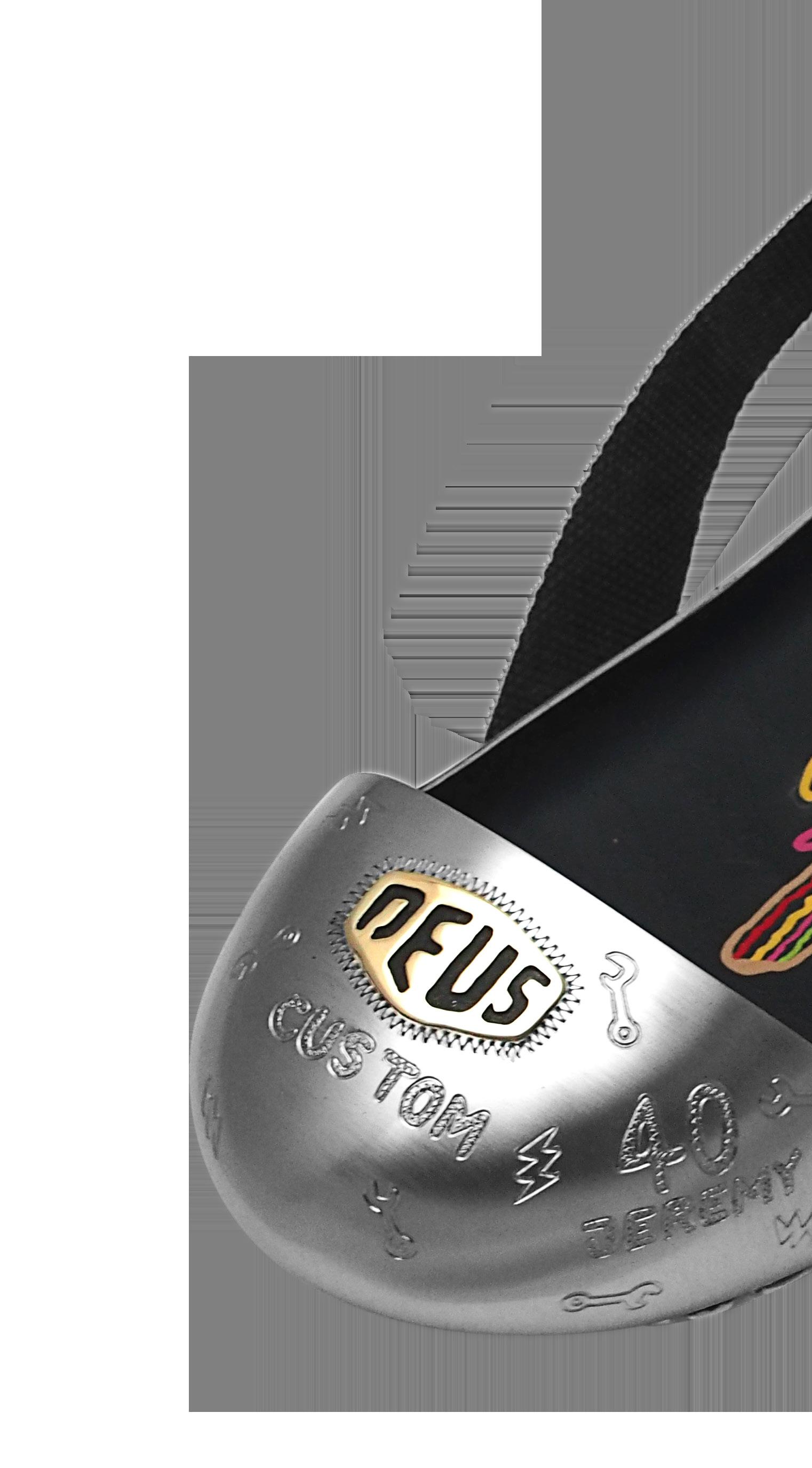


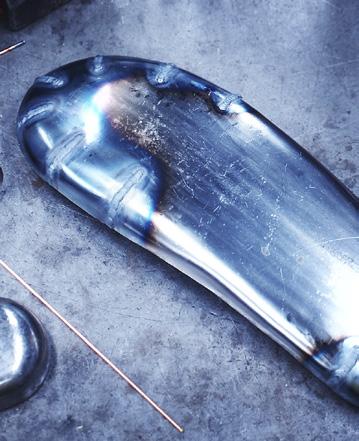
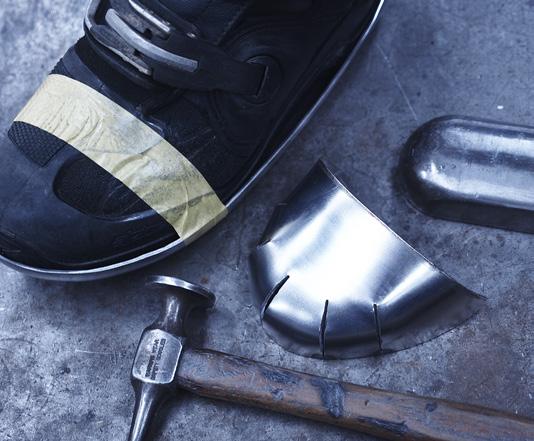

HAVE FUN!! make a STEEL SHOE!! 今回は意外と調べても出てこないスティールシューの作り方。 ただし作る人によって材料や作り方は違うのでここではCHEETAHの作り方。 ようは正しい作り方なんて無いって事、ちゃんと役目を果たしてれば後は何でもOK !! 正直言うとスティールシューの製作はすご~く難しいし大変!! でも、「自分で作ってみたいっ!」って変態達の参考になればそれ幸い。 ってことで Let`s Try !! まずは底を製作、使ってる材料は普 通の鉄の2mm 1 チーターの作り方は底と横は一枚で作るんで一回り大きめに材料を切 り出し 靴底のRよりも少し強いぐらい湾曲させておく、その後割りを入 れてサイドを立ち上げる 32 4 フロント部を作る、こ こも難しいので簡単 にやる場合はサンダ ルみたいに帯だけで もよし。 5 6 フロント部を付けて横から見た写 真、先に言った底を湾曲させるっての はこれの事。 湾曲させておくと地面との接地面が 減り摩擦が少なくなるのと、この後裏 面にステライトを盛る時に熱の変形 が少ない。まっ平のまま裏を盛ると逆 に沿って使えなくなっちゃうよ! 7 かかとにベルトループを付け る、この形状もお好みで。 8 keep going!!

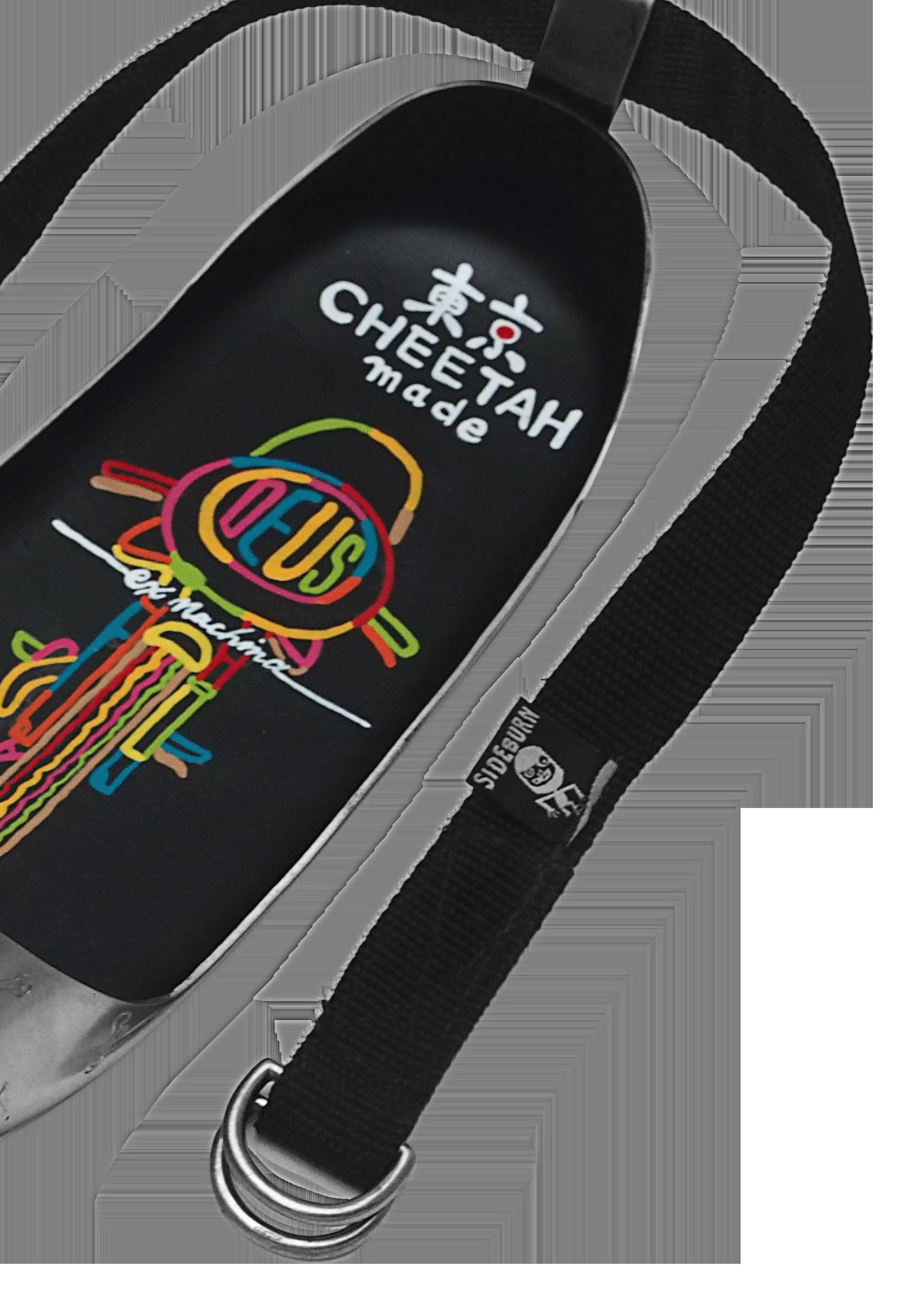

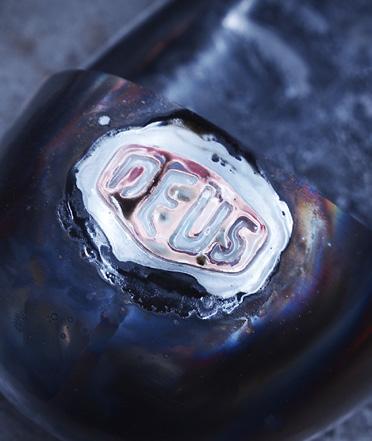

95 裏面に摩擦を減らすため&長持ちさせるた めのステライトを盛る。 これを盛っておかないと鉄板2mmでも一回 の練習で穴があいちゃう。 FTで一番重要なギア、せっか くだからカッコよくカスタム! これで完成。 9 10 11 great job!!


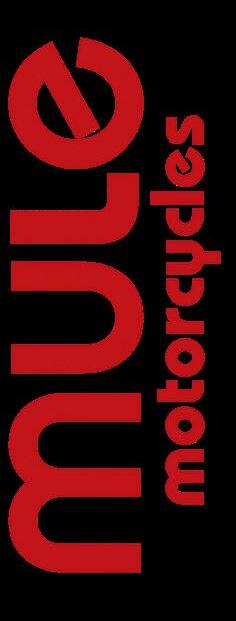
Dennis
Having a flying head that was freewheeling all the time had made Dennis’s world one big mess. When was the last time he and his head had spent a whole day together? He couldn’t remember, it must have been

ages ago. Yesterday, he ran into his nephew, Tony, on Brick Street. They tried to have a conversation but their worlds just seemed to exist in different galaxies, nothing resonated. That made him wonder how his life could have been if he hadn’t joined the freelance forces, now nearly two decades ago.
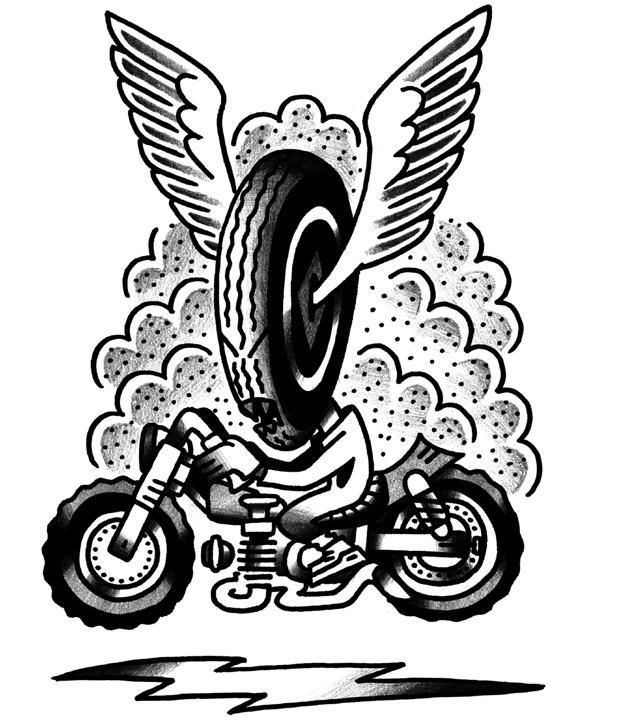
‘Did I leave the house again without my keys? Shit! I’m such an idiot!’
Words & illustration: @lennardschuurmans
A glimpse into the lives of Lennard Schuurmans’ tattoo flash characters
97
Project Bike
How hard can it be to convert a bike from sand to dirt?
THE PREVIOUS INSTALMENT
of our Project Bike feature
ended with the ‘bombshell’ that I was packing in sand racing, for the foreseeable, and converting our Honda 650 to short track spec. The thinking was, the time and money spent prepping it for dirt tracking would be more than made up for by the difference in value a UK short tracker can attract in comparison to a sand racer. I’m yet to find out if that’s true, but I’ve spent a lot of time, and a decent chunk of money, on the conversion, so...

The most complicated modification was fitting a rear brake. The sand racer had never had one, and dirt trackers need them. I bought a used, complete Honda SLR650 cast alloy footrest and brake pedal assembly from Germany, thinking I could adapt it to fit the SLR650 frame that had been modified by a previous owner. Wrong. I couldn’t make it fit for a few reasons, but mainly because the engine has also been modified, to take a kickstart bottom end, and the SLR650 was electric start only.
Time Gary thought each job would take 24%
Time they actually took 76%
(above) As it finished its last sand race; (right) Nearly ready for the dirt
I hadn’t factored that in, and all I could use of the whole assembly was the brake lever and its pivot and the brake master cylinder. So that was an expensive experiment.
This meant I needed to make my own hanger and decided to cut one from sheet aluminium. First, I made three or four patterns, using leftover lengths of laminate flooring, because it’s more rigid than cardboard, but easy enough to cut and shape and roughly the same thickness as the alloy plate I had. It took me so many times to get it right, because I wanted the footpeg in a comfortable and low position, but also where it would clear the kickstart. That, and the fact I’m not a fabricator. Once I was happy with the pattern, I cut and shaped the 3.2mm/10 gauge alloy, finishing it with an angle grinder fitted with a sanding disc. Meanwhile, a local machinist made a footrest hanger that allows the Bates-style footpeg to pivot out of the way of the kickstart lever’s arc.
I also made half a dozen laminate flooring brake levers before getting it right. The idea was to determine the shape then cut and weld the SLR650 lever so I could retain the pivot section. Again, it took me a lot longer than it should. Carl CFM welded up the sections of steel lever I cut, then I ground them neater.
The bike was already fitted with a 19in Honda CRF450 rear wheel, so I bought a new, pattern disc to bolt straight to the hub and found a brand
new CRF450 caliper and hanger on eBay. When it arrived it was obvious it had never been used, it was spotless. Who breaks a brand new CRF450 for parts, or who replaces a Honda CRF450 rear brake hanger? I bought it in good faith at a buy-it-now price, but it stuck in my mind.
I hadn’t had my hands on a CRF450 brake assembly before, but chose one because I knew it would fit and clear the disc and wheel. What I hadn’t envisaged was how it fastened to the swingarm. I worked out I needed a retainer welding to the inside of the swingarm to keep things as neat as possible. Co-Built fabricated it and welded it on. Then I measured up and turned a new rear wheel spacer to suit the caliper hanger. It all looks neat, but, again, took much longer than I anticipated.
Rather than having a hose leading
 Words and photos: Gary Inman
Words and photos: Gary Inman
to a remote brake-fluid reservoir, I ordered an ‘HRC style’ clear hose that shows the level and holds enough fluid for a regularly checked race bike. It doesn’t need a large reservoir, but paying £10 for a 2in length of pipe with a plastic bung in the end made me feel stupid once I got the online purchase in my mitts (it’s not fitted in the photo above).
The front wheel was a 21in ’rim with a Michelin sand knobbly, so I bought an Aprilia road bike 19 off eBay, tapped in new bearings and fitted a Maxxis. The Honda is going to be a cheap starter bike to get someone on track, so secondhand road bike wheels are where it’s at.
New Venhill cables were ordered; a Renthal rear sprocket and nonO-ring chain too. And I made a different left side panel, because the air filter won’t have to hide from the

sand and North Sea any longer, so it can live out in the breeze.
I sent the petrol tank to CJ Powder Coatings, Grimsby, but when they blasted it they revealed a load of filler and dents. I had a very good replacement Honda XL185 tank hanging from the roof of my garage, so that went for a clean coat of bright white. I originally planned to leave the 1980s MX-style seat and rear fender, but a mate said it would probably appeal to more people with a traditional flat track seat unit and I agreed. Long-time Sideburn supporter Motone Customs stock a couple of flat track seats, one aimed at spine frame ‘vintage’ Japanese bikes, the other at Sportsters. They’re good quality (all Motone stuff I’ve had is) and come with a fibreglass seat pan to have upholstered, saving the bike builder
the job of making their own pan. A local general upholsterer covered it, but didn’t follow my instructions, and knew he hadn’t, so it ended up being a cheap job. I won’t go back there. I got the seat back yesterday, so just enough time to perch it on for this update. As soon as the magazine goes to print I’ll finish the last few bits and pieces and try to move it on.
CONTACTS
See
instalments
Co-built.net Cfmofsleaford.co.uk CJPowdercoatings.co.uk Motone.co.uk Venhill.co.uk
previous
on the development of this bike in Sideburn 30, 31, 32, 36 and 41. 99
Racewear
Trusted: When she isn’t racing or riding, Lucia Vázquez runs the bike clothing company

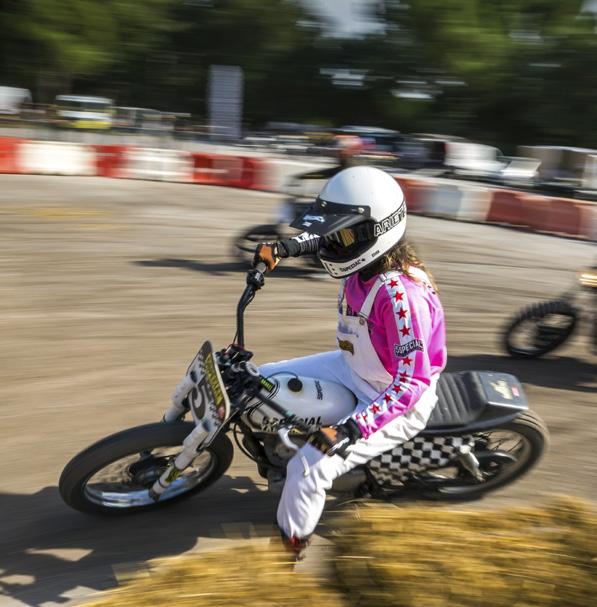
5Special with her brother, Sito. This is what she packs in the van for a weekend’s competition
Name: Lucia Vázquez
Age: 38
Job: Clothing and digital designer at 5Special
1 Crazy racing chicken
It’s my lucky charm. No, really.
2 DMD Seventyfive helmet
It’s one of the first helmets I bought. I like the aesthetics of the 1970s, so this helmet is perfect for me.
3 JT Racing gloves
My favourite gloves for vintage enduro, I bought them in France from a collector and have matching pants for special races.
4 Icon gloves
If these gloves spoke they could tell a lot of tales. They have lived with me through all kinds of adventures: beach race, flat track, mud, sand…
5 Ariete Mudmax goggles
I have many models of Ariete goggles, but these are my favourites. I really like the mirror lens and they are very comfortable day and night. Usually, I try to mix modern and old elements, so modern goggles with a retro helmet.
6 Folding chair
This chair was made in Spain and sold by my grandfather in his hardware and food store in the ’60s and ’70s. It has great sentimental value for me and is always in the van so I can sit in the pits between races.
7 GoPro Hero 7 Black
I like to record myself and friends when we ride and I usually edit videos after going to the races.
8 Notebook
I always carry my markers and my notebook in case I have a good idea while I’m at the track.
9 Vans Old Skool shoes
If I’m not wearing a pair of boots, I ride in my Vans.
10 StylMartin Continental boots
I love the design of these boots and they are very comfortable, and very tough. They have been dealing with all kinds of evil things for over a year.
11 Steel shoe
This steel shoe was made by my brother Sito, who is my partner in the 5Special business. When you’re riding flat track, body position is very important and when you learn to use a steel shoe you see this discipline very differently. I already need a new one.
12 5Special Nofrontbrake vest
This is my ‘must have’ shirt, because my motorcycle life is all about ‘no front brake’.
13 Pincho
Our pet cactus, who travels with us in the van to motorcycle events all around Europe.
14 Denim overall
I often ride wearing vintage dungaree overalls, because I like the style. They are comfortable and I can wear my
Hometown: Vigo, Spain
Bikes:
1976 Honda Elsinore CR125
1987 Honda CBR600 Hurricane
2015 Royal Enfield 535GT Scrambler
1980 Suzuki TS125
1992 Suzuki GSX-R400
1974 Yamaha RD125 Torque Induction
1990 Yamaha Special SR250
2001 Yamaha TT250
armour underneath. Overalls are always a good idea.
15 5Special Pink Star jersey
I have lots of race shirts, but this is my favourite. It was designed by me and some of the profits from each one we sell goes to a Spanish cancer charity.
16 Skateboard
It’s a carving skateboard that lets me surf sidewalks and make turns as if I was on the waves.
17 Woll beer
My favourite beer for the end of an intense day.
18 Make-up
I always take my eyeliner with me, even to the races, it’s my war paint. I need my sun cream too.
19 5Special socks
The best socks to wear with boots. Chequers, flames, a spark plug. What more do you want?
Photos: 5Special/Pablo Nunes/Nicolas Serre
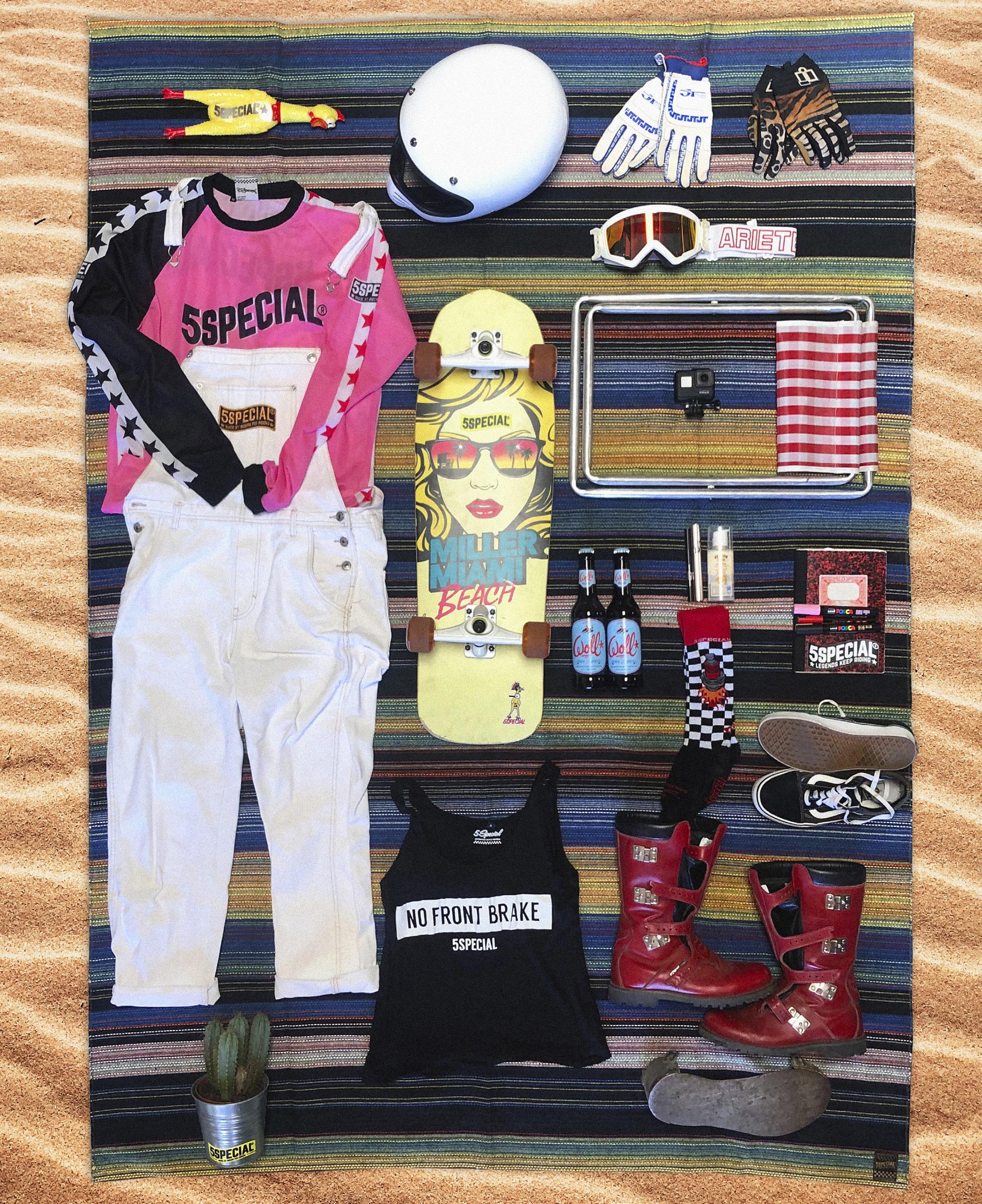
101 13 14 15 16 18 19 17 11 9 8 7 6 5 432 12 1 10

Face
Race
T-shirts, patches, enamel pin badges and tote bags featuring this Jim Koch design are in stock NOW. Order limited-edition Sideburn goods plus merchandise and some of our favourite products from our friends Shipped worldwide Visit Sideburn.bigcartel.com
DEEP IN THE THE VAULTS
Delving into the the deepest recesses of artist Death Spray Custom’s inspiration folder and pulling out some gems. This issue, running a line over beauty


The Other Racing Line
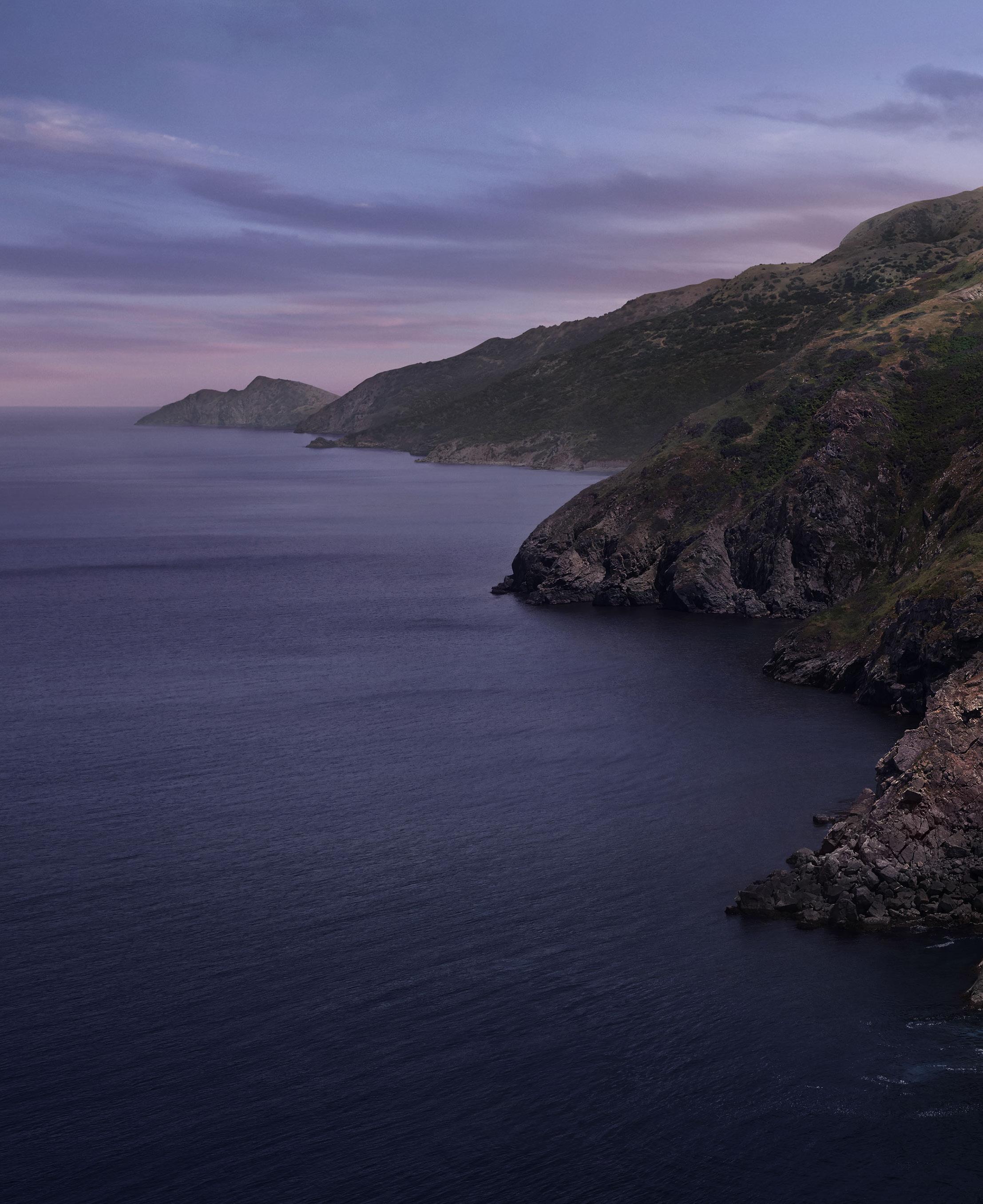
When Gary Inman, Sideburn’s editor, pitched the idea of the magazine to me many years ago, I quizzed him on the bikes that could and couldn’t be featured. ‘High bars and/or knobbly tyres’ was the response. Luckily, GI has yet to refuse a column of mine, so let’s drop some MotoGP into SB.
One bike I can’t stop looking at for the wrong reasons (yet could be the right reasons) is the factory version of the Ducati GP20. The wrong reason is that it looks like a bit of a car crash, each section appears visually designed independent of the the parts, creating a bike with no line. This line being a magic optical line that you can draw from
the front to rear of the bike. It could be anywhere on the form or even made graphically.
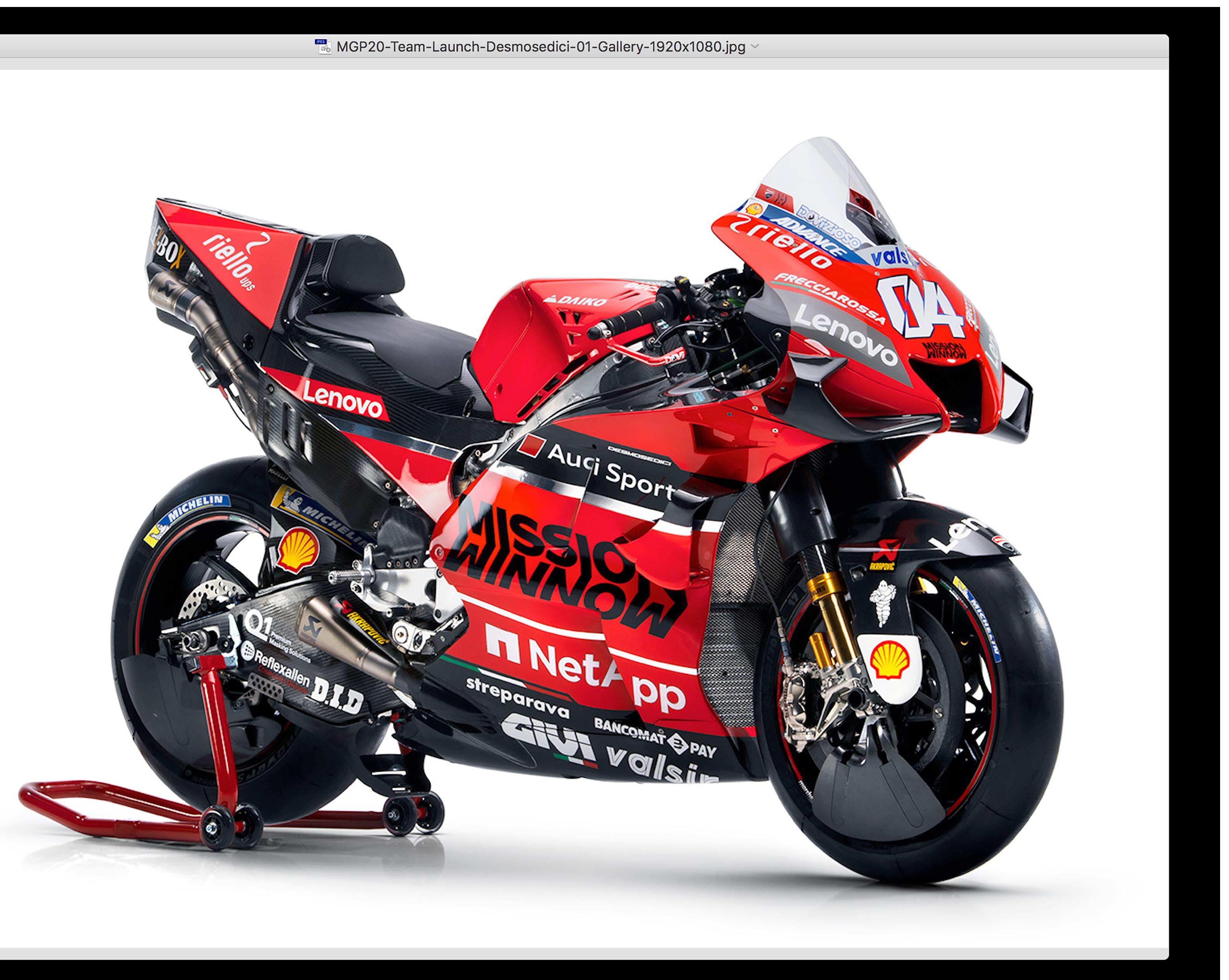
With the GP20, there is no unifying line, which is probably down to the use of Computational Fluid Dynamics (CFD). This is basically complex modelling of the aero of bike and rider in complicated situations, like leaning over. The data forms the most effective shape, though the data will be all function rather than form.
The distant ancestor of the GP20 is the Cagiva C594. It’s up there with the most beautiful bikes in the world. It may not have been successful, yet it lives on as an icon alongside classics like the Ferrari P4, Porsche 917 and Manx Norton.
Ducati GP20 BAD
No discernable line





heavy, awkward visual
of
No hierarchy in branding,
means nothing stands
no branding narrative,
with
similar
package
Ron Wood Rotax
number of aesthetic
make it appealing to the eye.
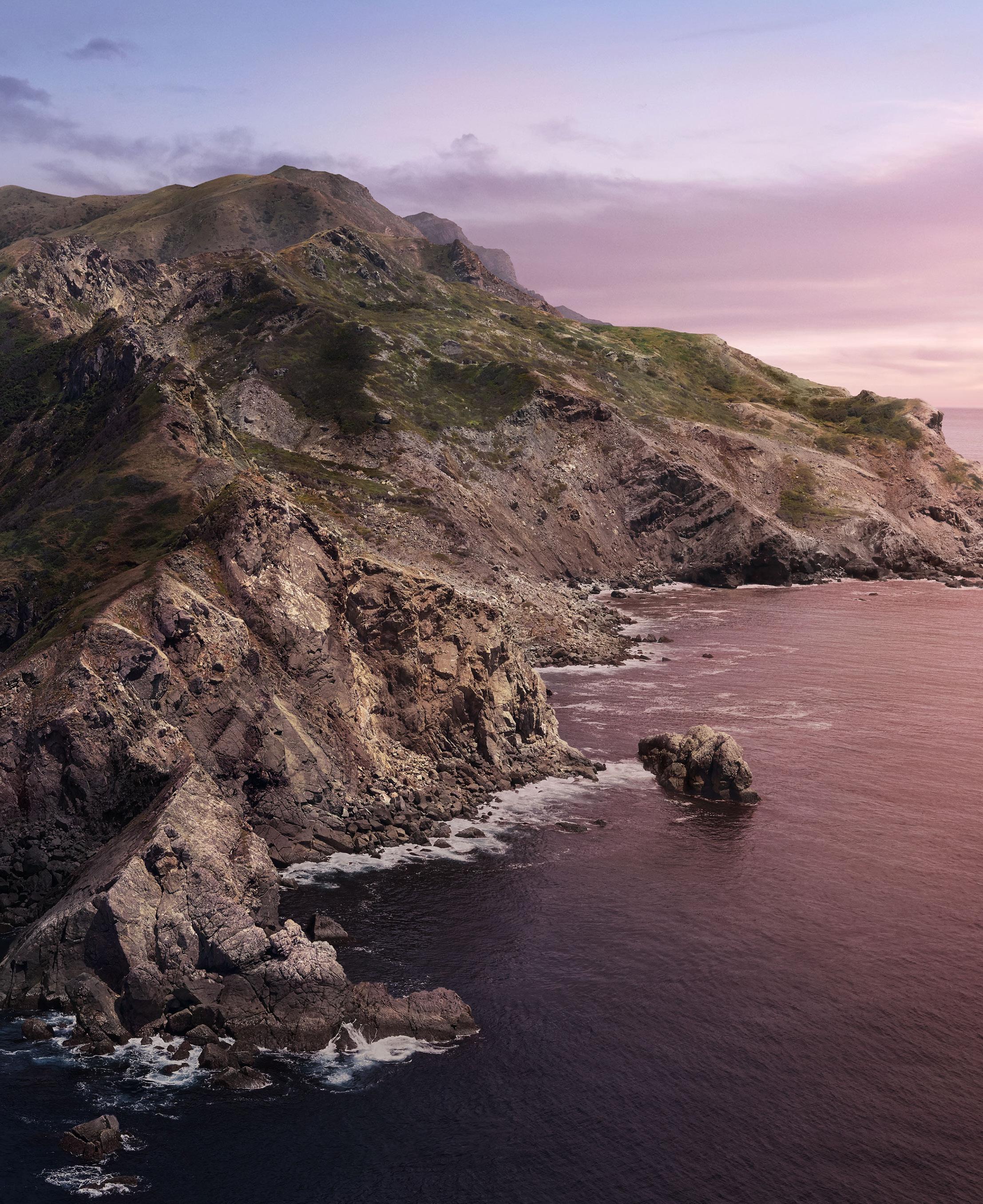
wheels on flat track bikes remind
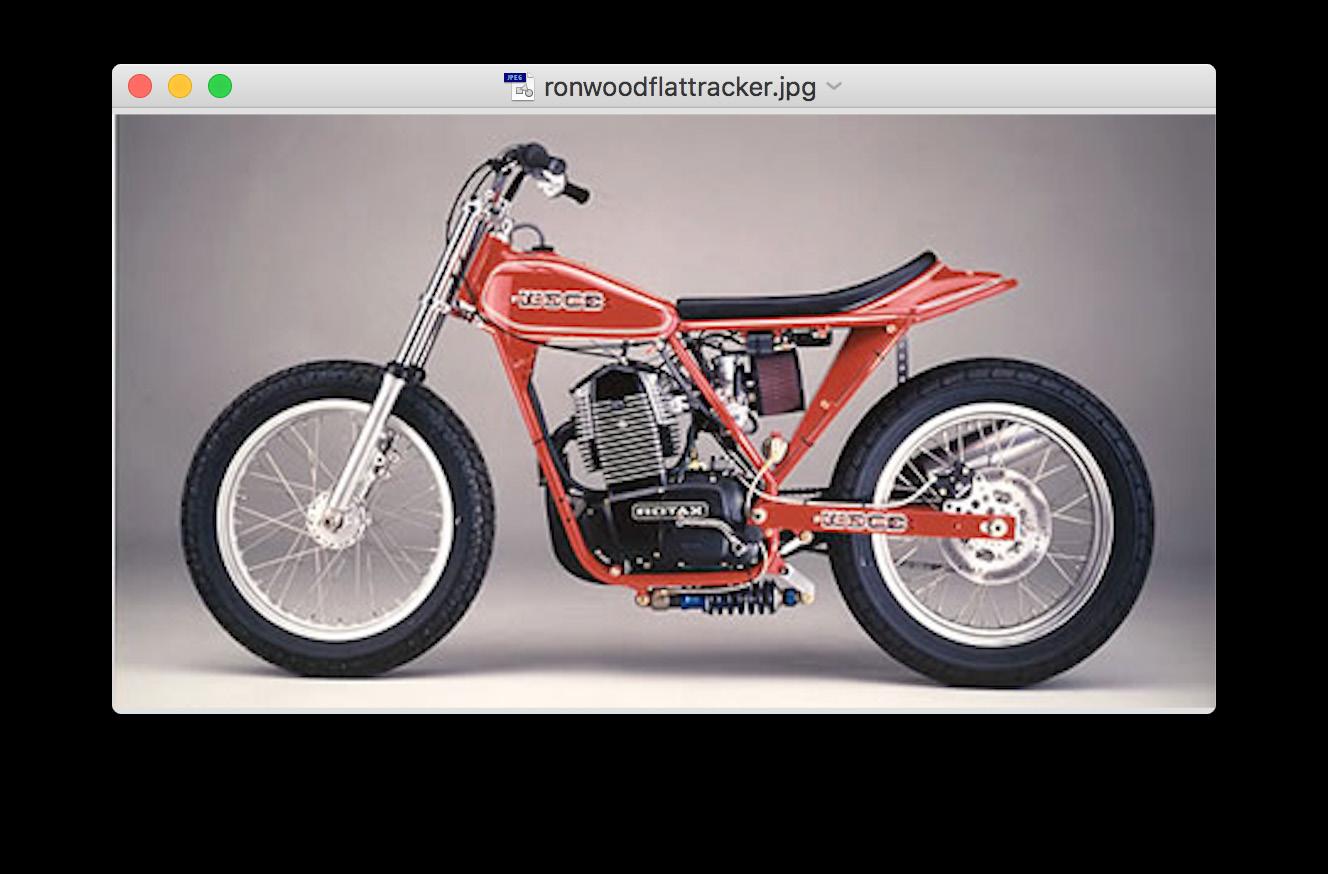
of the human leg-to-body ratio (longer legs
the body more attractive).
Cagiva C594 BAD
Not
Cagiva C594 GOOD
Blend of aero and human
Minimal branding
Can
have
Cagiva
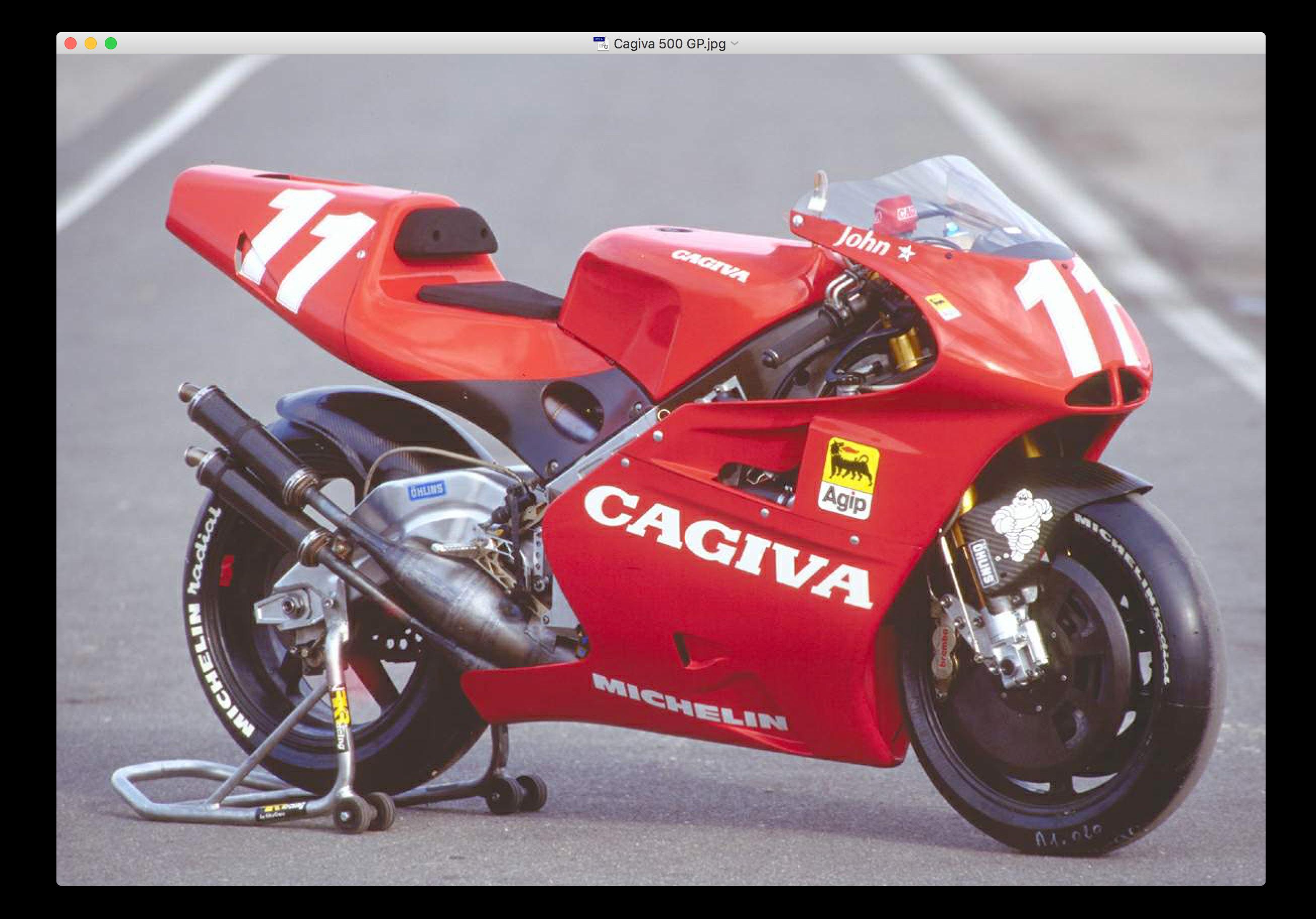
This
has a
lines which
Personally, 19in
me
make
•
• Top
centre
gravity •
which
out,
everything
a
graphic weight
•
competitive (enough) altermodern in its execution • Aero
offers opportunity to consolidate race aesthetic to production bike aesthetic design
•
sculpture forming •
equals maximum impact •
I
one • Please • Also
Mito inspo
SB: Thanks for answering a few questions about the attached photo. We know it’s Castle Rock, WA, September 1990, but what was the race?
DS: This was a Western Regional Championship race. That series didn’t last too long after this. I was 18 years old and a Junior that year. They had ProAm, Junior and Expert categories then. There was a 600 National the next day.
SB: How long had you been racing at Castle Rock by this point?
DS: For about four years. Castle Rock was the first TT I raced and I was a pretty good motocross rider, so I was really fast there right off the bat. Castle Rock really shaped me as a rider. That track showed me I could hang with, and beat, the best in the business. The high speeds and my ability to pass anywhere on that track were a couple more reasons it quickly became my favourite.
SB: What bike were you racing?
DS: Knight-framed BBRP-built Rotax 600. I was a really good starter. I pulled the holeshot and led start to finish that night.
SB: Who else was on the podium?
DS: Jeff Annen was second, one of my best racing buddies and travel partner, who went on to earn a national #40 [from 1993-2000]. Joe Kopp [Grand National Champ in 2000] was third.
SB: How come you were sponsored by Budweiser?
DS: I was sponsored by a local Budweiser distributor. They actually came to our team and really liked what we were doing. Brian Billings (BBRP) was the team owner and one of the best Rotax builders around.
SB: Castle Rock had a reputation for wild crowds, what was it like to win in front of them?
DS: Castle Rock was loud! Really loud. You could hear the crowd while racing and I always thought that was really cool. They were even louder if it was a local guy whipping on the top GNC riders at the time.
SB: You don’t see trophy girls like this any more. What do you remember of her?
DS: I don’t remember very much about her. There were a lot of trophy girls back then.
SB: What does this photo remind you of?
DS: The start of my pro career. I learned so much there, and since it was the only track in Washington state running a Grand National, the top riders and teams got to see what I could do.
>> From: Dan Stanley To: sideburnmag@gmail.com Date: 29 April 2020 Subject: Sideburn questions 23 15 30 15 15 40 30 Castle Rock Raceway 1990 Ab envy 30% Body fat, what’s that? 15% The king of leers 40% Eyes on the prize 15%

107
Photo: Flat Trak Fotos














































 Kevin Varnes The Mechanic
Kevin Varnes The Mechanic



































 Words: Gary Inman Photos: Shogo Nakao (opposite); Flat Trak Fotos (all others)
Words: Gary Inman Photos: Shogo Nakao (opposite); Flat Trak Fotos (all others)





































































































 Words and photos: Gary Inman
Words and photos: Gary Inman

















